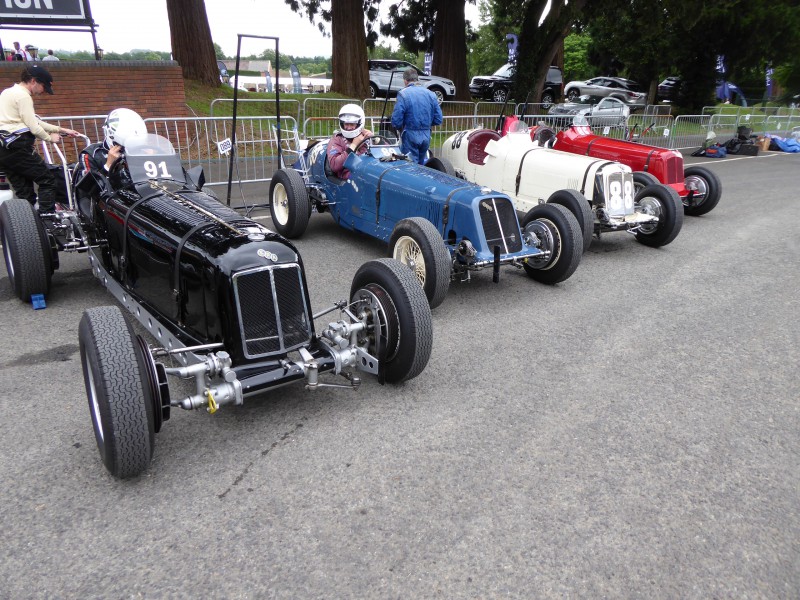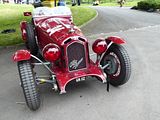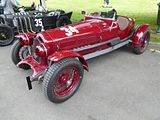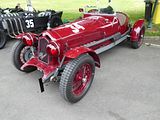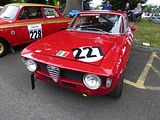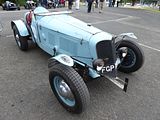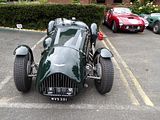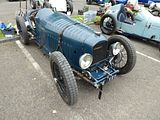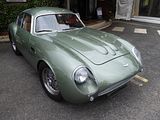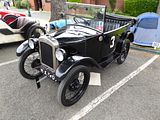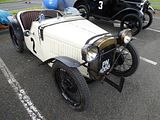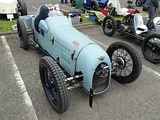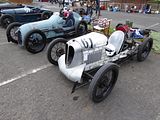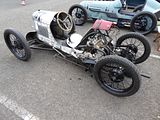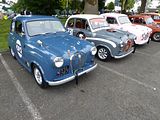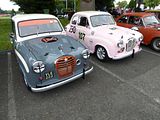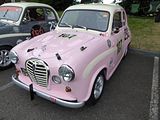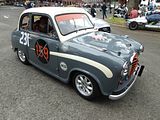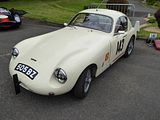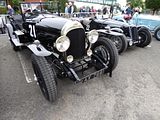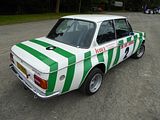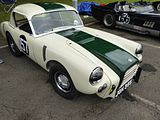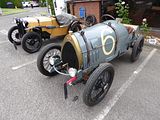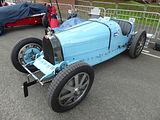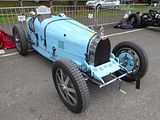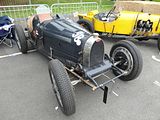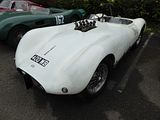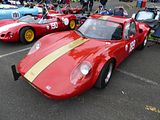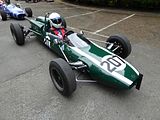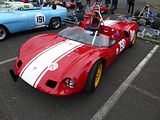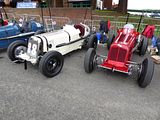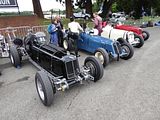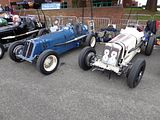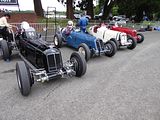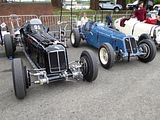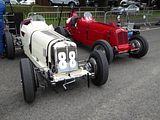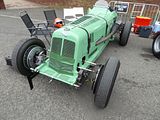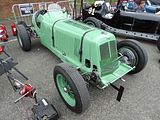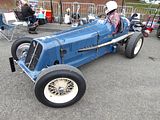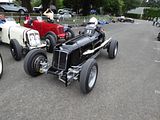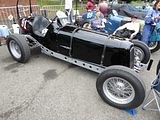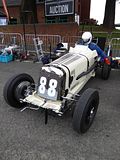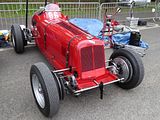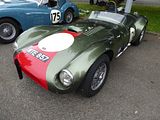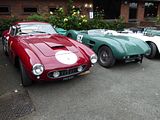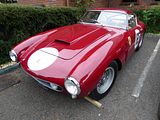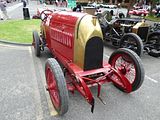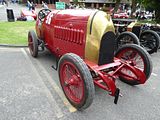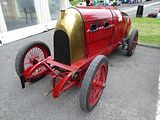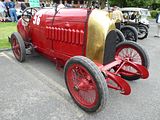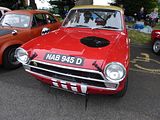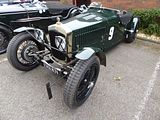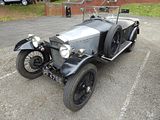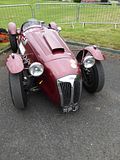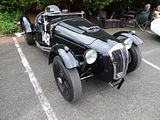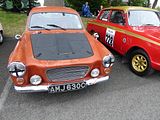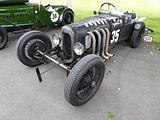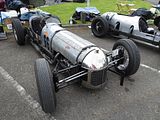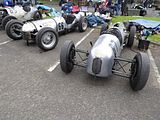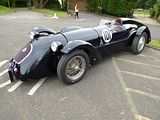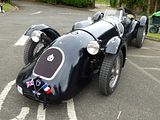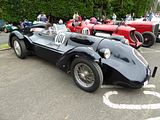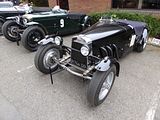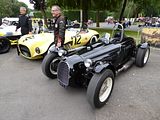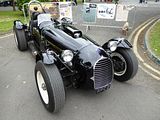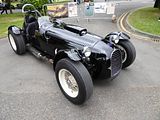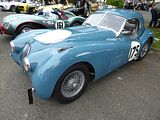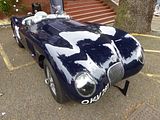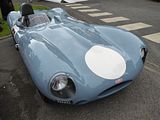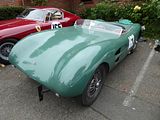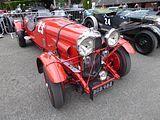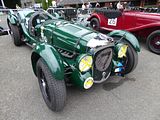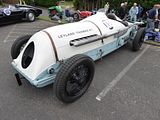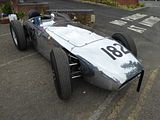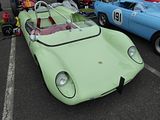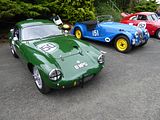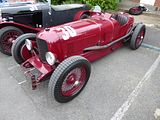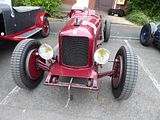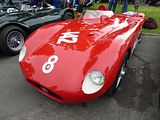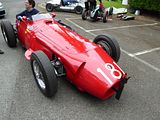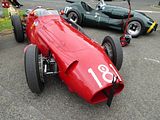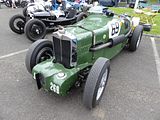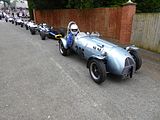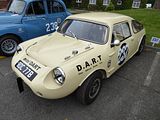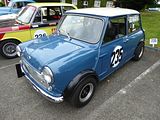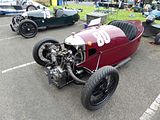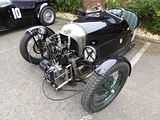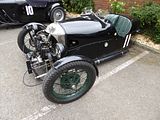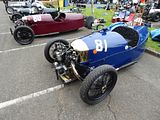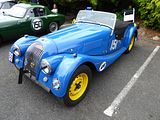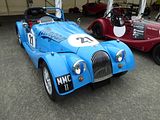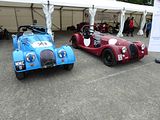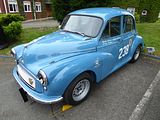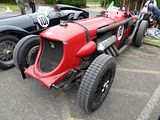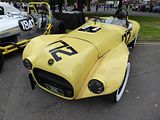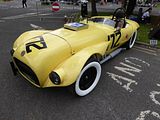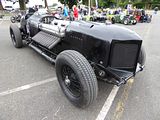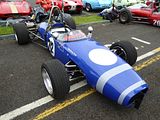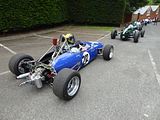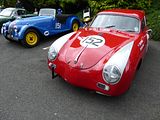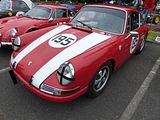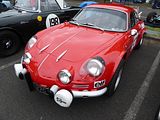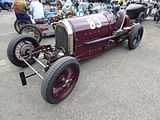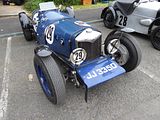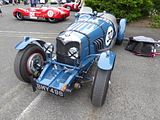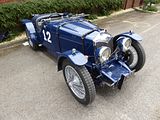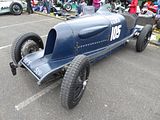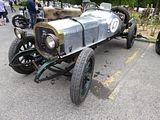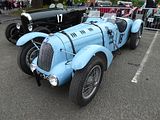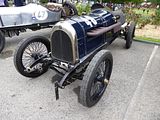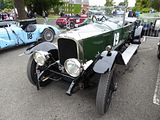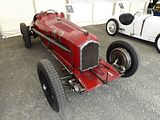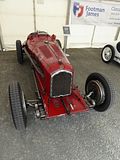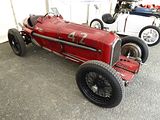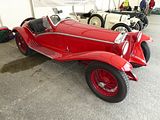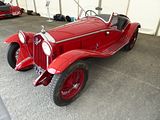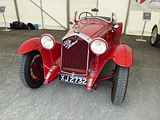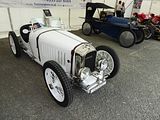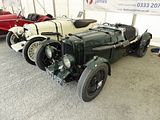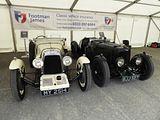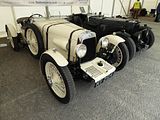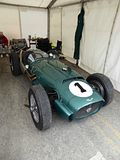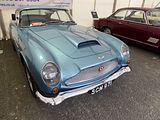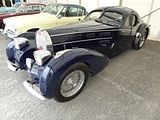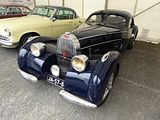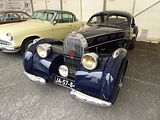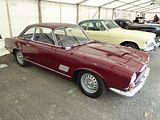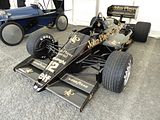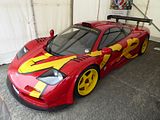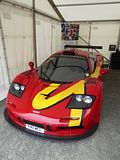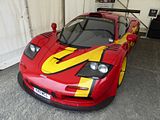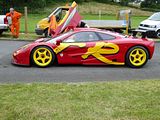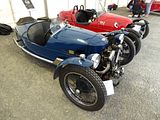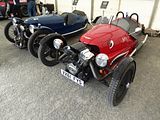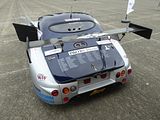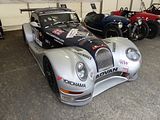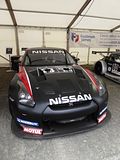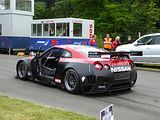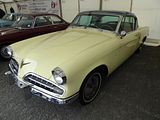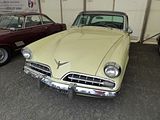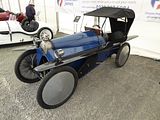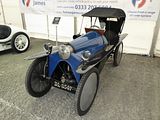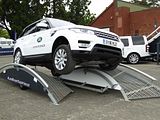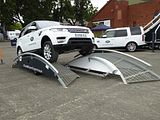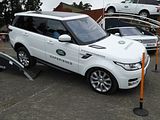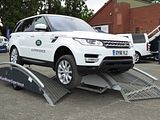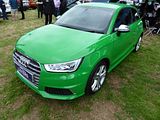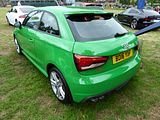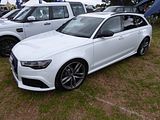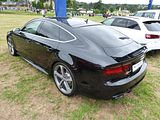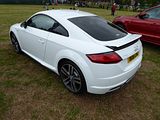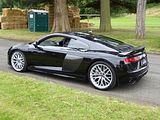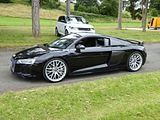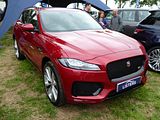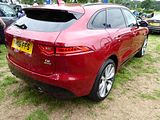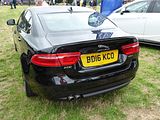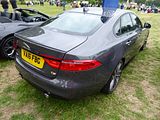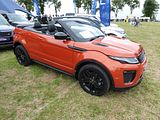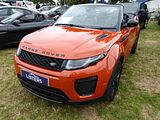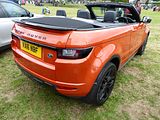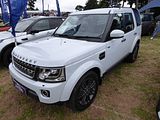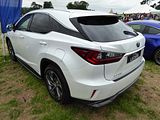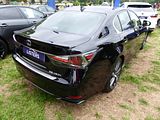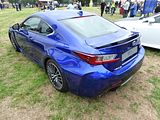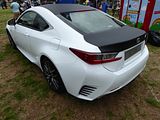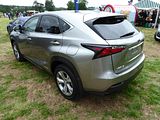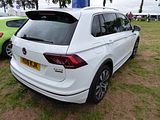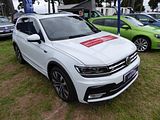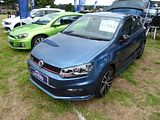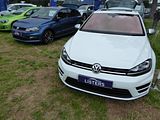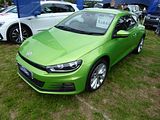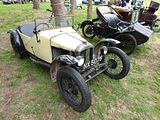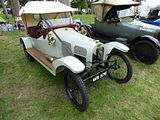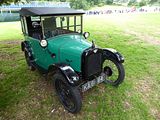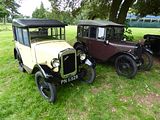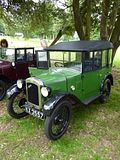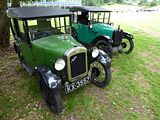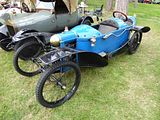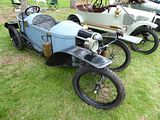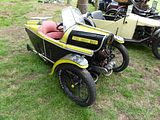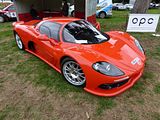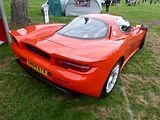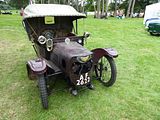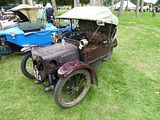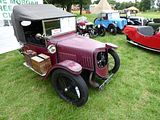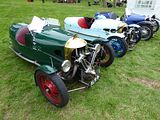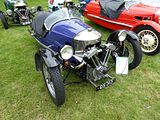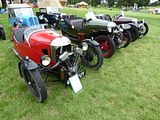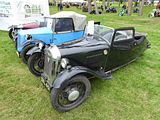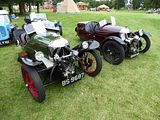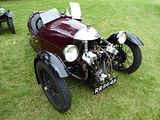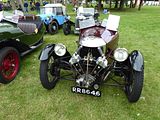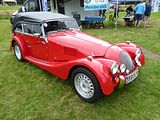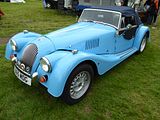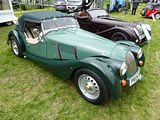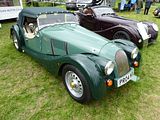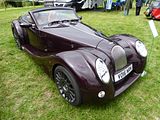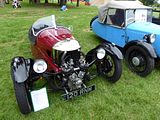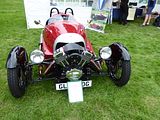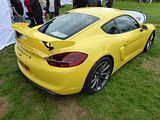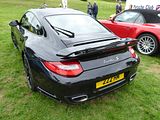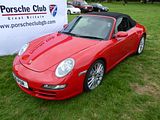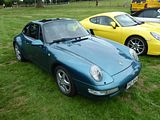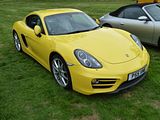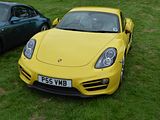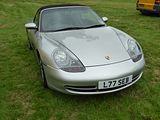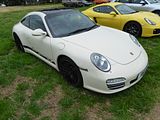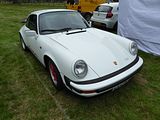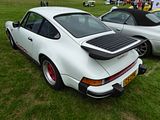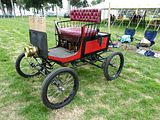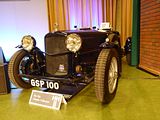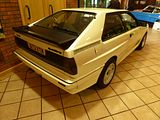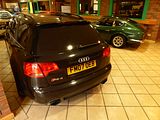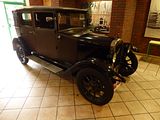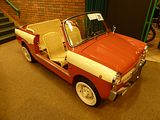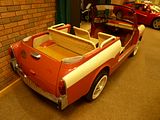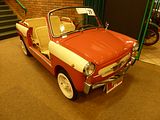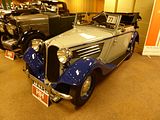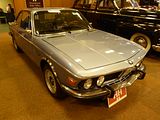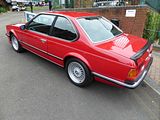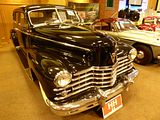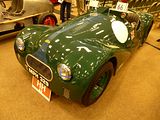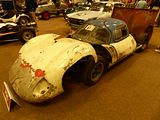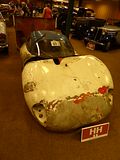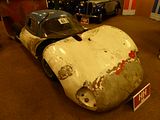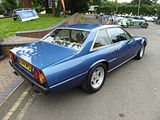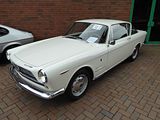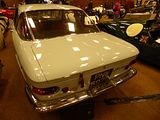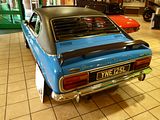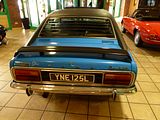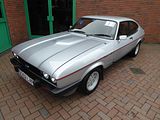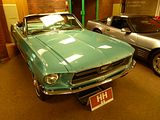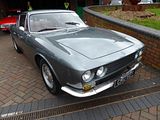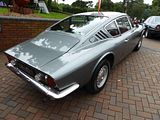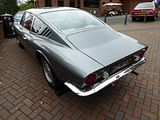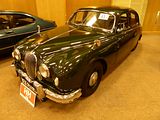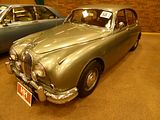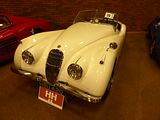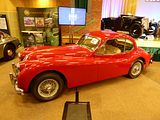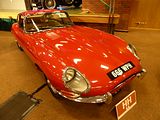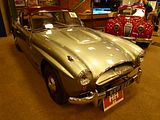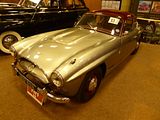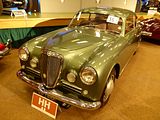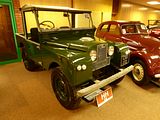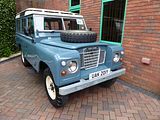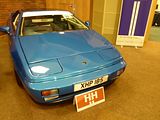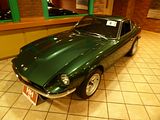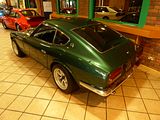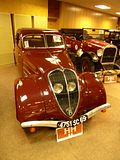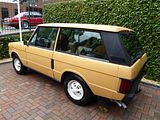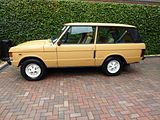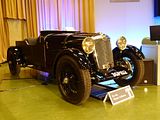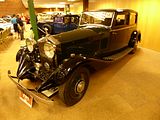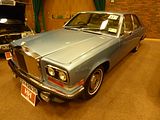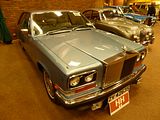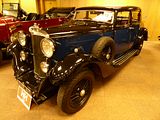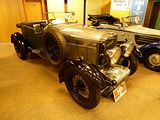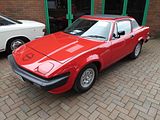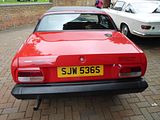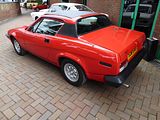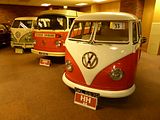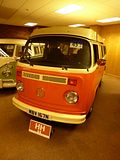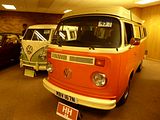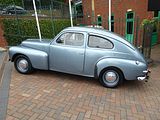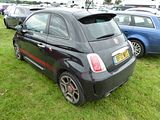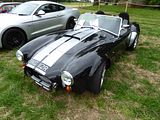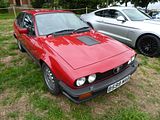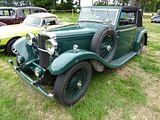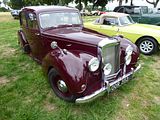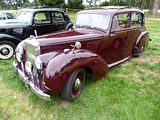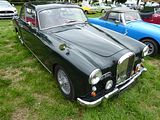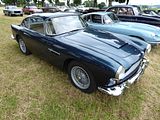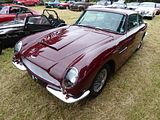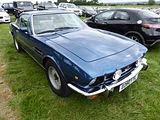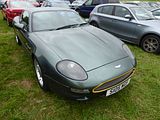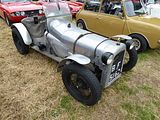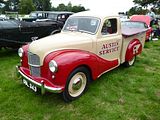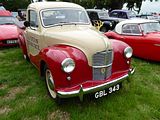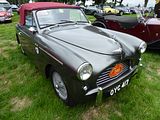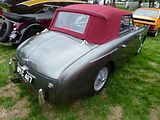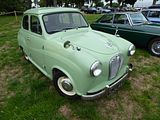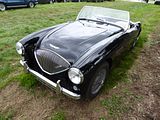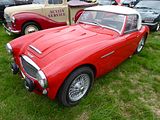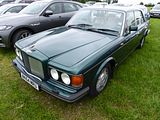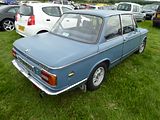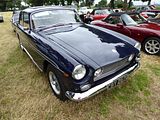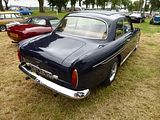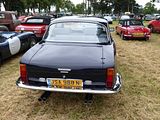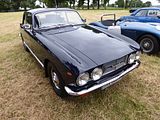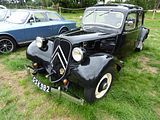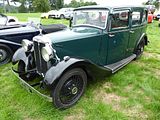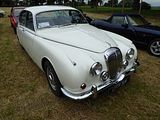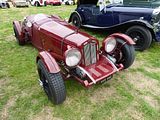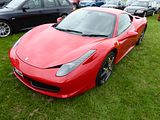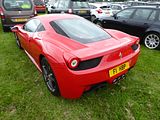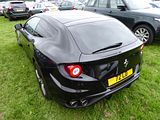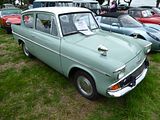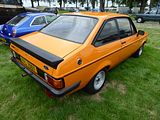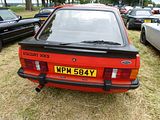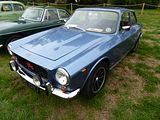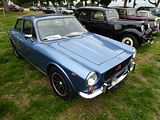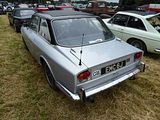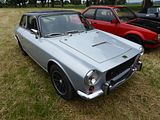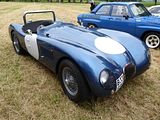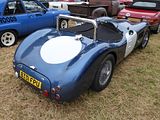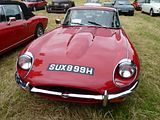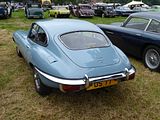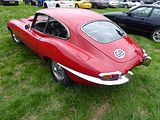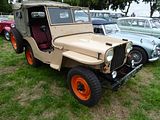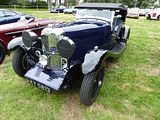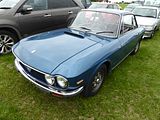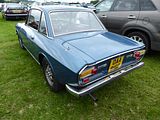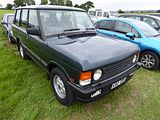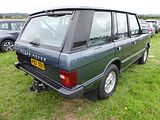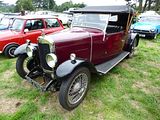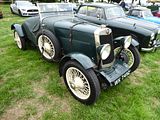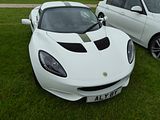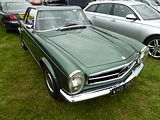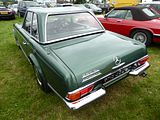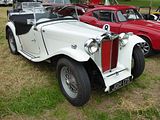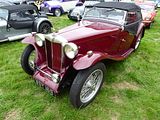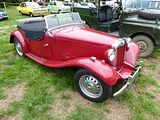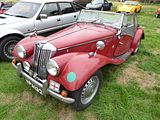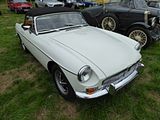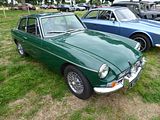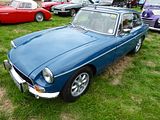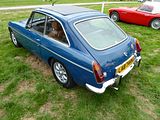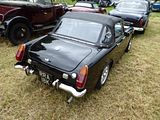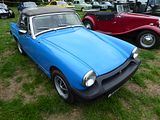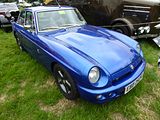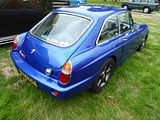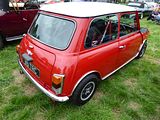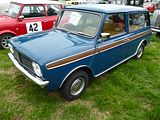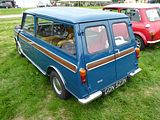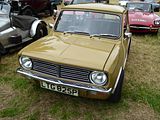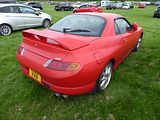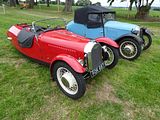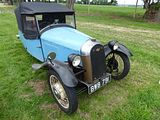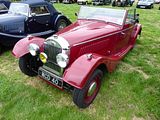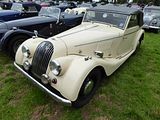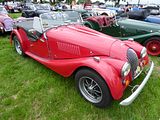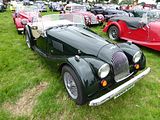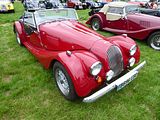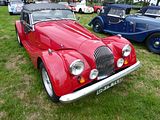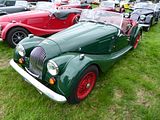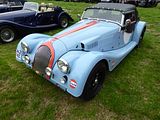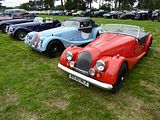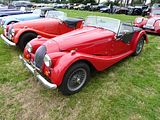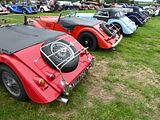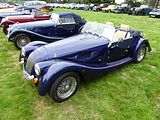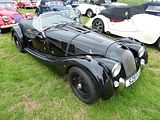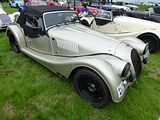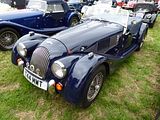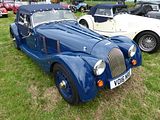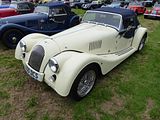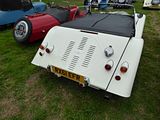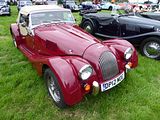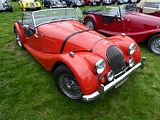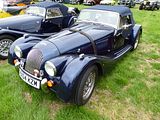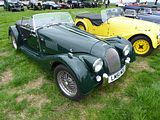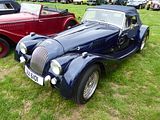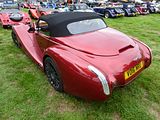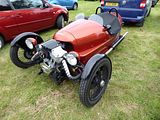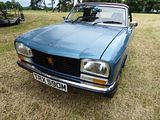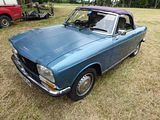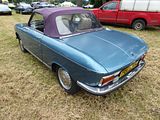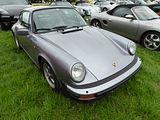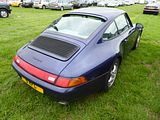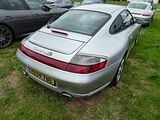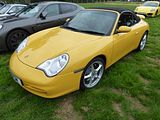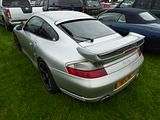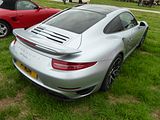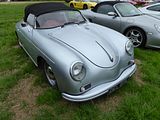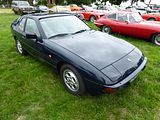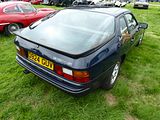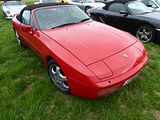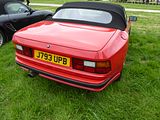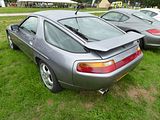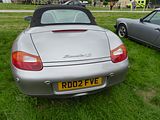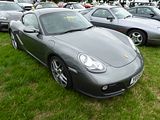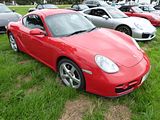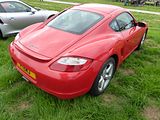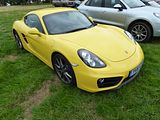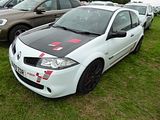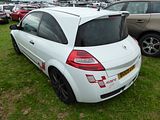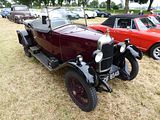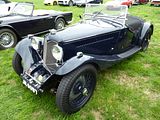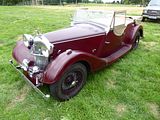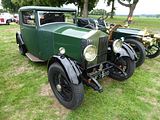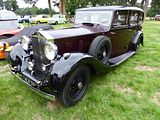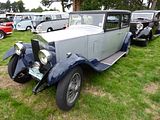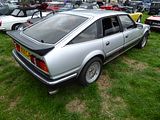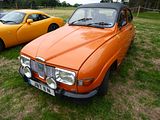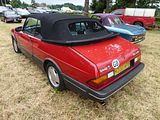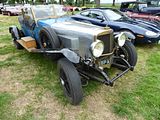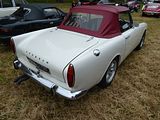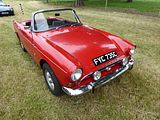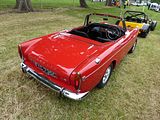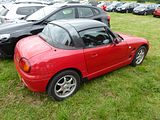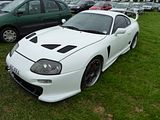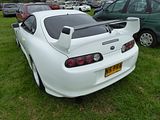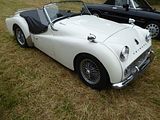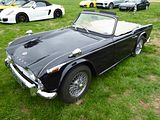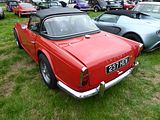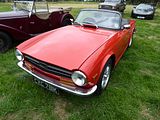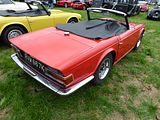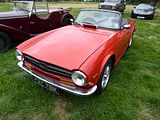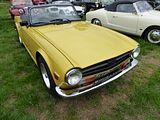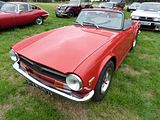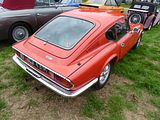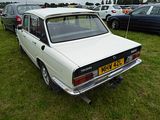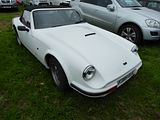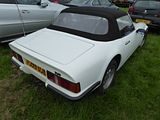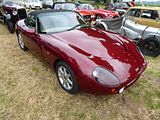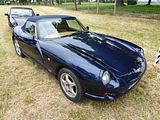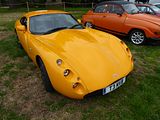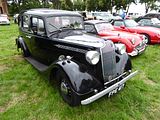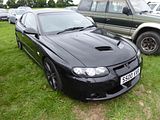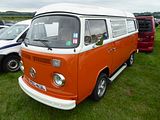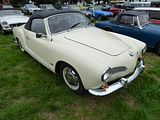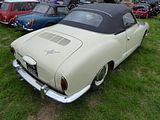Like the vast majority, I confess that I’d never heard of Chateau Impney, let alone did I know that it had played a significant role in the motor racing history of the nation, until plans were revealed for a high profile relaunch in 2015. I duly went along for the inaugural weekend, and was agreeably surprised by what I found. The vast array of interesting cars entered for the hill climb action, the associated displays and the vast number of classic and rare cars in the public parking were more or less in-line with what the pre-event publicity had led me to expect, though no less impressive for all that. But it was the venue itself which stood out. It’s certainly not the most obvious location for a Hill Climb, as this would appear simply to be rather unusual looking building set in a large country park, on ground which is more undulating than hilly. The Chateau dates back to the nineteenth century, and its construction is thanks to a local salt mine owner, John Corbett and his wife Anna, who were married in Paris before returning to England. In 1868 and with a growing family they decided to buy the original Impney Manor House, demolish it and have built a house in the style of the chateaux they had seen whilst in France. They commissioned French architect Auguste Tronquois to oversee the work of English architect Richard Phené Spiers. Completed in 1875, the result is considered to be the finest and most authentic example of French style Chateau building in the UK, and it was a private residence, set in 110 acres of parkland until 1925, when it was sold and turned into a prestigious hotel. The motor sport story started there in 1957, with competitors greeted by a short, narrow and uneven course in the grounds, and needing to concentrate on the road ahead and not the spectacular setting in which they found themselves. The venue became increasingly popular in the next few years. Formula Junior was added to the program and the venue resurfaced the track to make life a little easier for the competitors. And there were plenty of famous names among them: Sydney Allard, Daniel Richmond, Tony Marsh, Patsy Burt, Phil Scragg, Alec Poole, John Handley, Ralph Broad and Rovers Fletcher all tried their skill in what was more of a 550 yard sprint than a true hill climb. The last race took place in 1968 and the site soon fell into a gradual decline, the cost of maintaining that lavish building and site proving just too much. Eventually the hotel passed into receivership. and its future looked bleak. In 2012. though, it was bought by the Greyfort Group, which is owned by the Spollon family, who have links to historic motorsport and the VSCC, going back generations, via custodianship of some notable historic machines The family has ploughed millions into the complex, re-opening the hotel, which is now a rather splendid place to stay (I gather). It was inevitable, given the history, that reviving the motorsport would figure in the plans as well. Actually making this possible is no mean feat, of course, and early thoughts of running an event in 2013/4 were too ambitious. Planning permission was required, a new surface had to be built and surfaced, MSA approval was required, an MSA-approved club had to be formed (the Chateau Impney Hill Climb Club) and a course licence was required. The fact that the venue had previously held events counted for nothing in most of these steps, but eventually all the hurdles were overcome, with a new course that, at 1000 yards, is roughly twice the length of the old one in place, and the first event for nearly 50 years was finally held in 2015. It was such a success, that it was to the surprise of no-one that it was immediately announced that the venture would be repeated in 2016. The format did not really need to be changed, and indeed it was not. It is a 2 day event, but such are the number of events competing for space in my diary that I was only able to attend on the first of these, the Saturday. I certainly don’t feel like I missed anything, as this report will evidence:
IN THE PADDOCK
Core to the event are the very varied hill-climb entries. And there were a lot of them, more even than there had been in 2015, with nearly 300 cars entered, grouped together in a long list of different classes, ranging from some splendid Edwardian machines, many of them with their massive and low-revving engines, through to some race machinery of the 1930s, the ever popular 500cc cars of the post-war period, converted saloon cars, and purpose-designed racers of more recent times. There’s unrestricted access to the Paddock, where the cars can be seen awaiting their turn, some being given last minute adjustments by their owners and drivers. The Start line is some way away, so cars leave in batches to head down there, which means you do need your wits around when moving around the Paddock. Many of the competing cars were ones I had seen here in 2015 or are familiar from other events such as Prescott and Shelsley Walsh, but there were plenty of surprises, too.
ALFA ROMEO
Among my favourite cars of the entire weekend were this duo of 8C 2300 Alfas, a Monza and a Muletto. Although we now think of Alfa Romeos as a manufacturer of road cars, their prime focus in the 1920s and 30s was on racing. In the quest for more power, and hence speed, the first Alfa 8 cylinder engine was created by Vittorio Jano in 1924 for the 1987 cc P2. It featured a common crankcase and four plated-steel two-cylinder blocks, and in the P2, it won the first World Championship ever in 1925. Although it was a straight-8, the 8C designation was not used. Alfa’s efforts for the rest of the 20s were focused around 6 cylinder units, with the legendary 6C 1750 cars earning their place in history with successes in most of the notable races of the era. But to keep up with the competition, more power was needed for the 1930s, and this led to a renewed effort with a straight 8, a new 8C engine. First entered at the 1931 Mille Miglia, this unit also designed by Jano had a common crankcase, now with two alloy four-cylinder blocks, which also incorporated the heads. The bore and stroke (and hence rods, pistons and the like), were the same as the 6C 1750 (bore: 65 mm, stroke: 88 mm 2,336 cc). There was no separate head, and no head gasket to fail, but this made valve maintenance more difficult. A central gear tower drove the overhead camshafts, superchargers and ancillaries. It went on to power two models, the 8C 2300 (1931–1935) and the even more rare and expensive 8C 2900 (1936–1941), where the bore was increased to 68 mm and stroke to 100 mm to give an engine of 2,905 cc. It is the 8C2300 models which are the better known of these, and are highly prized these days. Initially, Alfa Romeo announced that the 8C was not to be sold to private owners, but by autumn 1931 Alfa were selling the unit installed in a rolling chassis in Lungo (long) or Corto (short) form with prices starting at over £1000. The chassis were fitted with bodies from a selection of Italian coach-builders such as Zagato, Carrozzeria Touring, Carrozzeria Castagna, Pininfarina and Brianza, even though Alfa Romeo did also make their own bodies. Some chassis were clothed by coach-builders such as Graber, Worblaufen and Tuscher of Switzerland and Figoni of France. Alfa Romeo also had a practice of rebodying cars for clients, and some racing vehicles were sold rebodied as road vehicles. Some of the famous first owners include Baroness Maud Thyssen of the Thyssen family, the owner of the aircraft and now scooter company Piaggio Andrea Piaggio, Raymond Sommer, and Tazio Nuvolari. The first model was the 1931 ‘8C 2300′, initially designed as a racing car, but actually produced in 188 units also for road use. Alfa often added the name of a circuit where the car had triumphed to the model name. Hence the 8C 2300 tipo Le Mans’ was a sport version of the ‘8C 2300’ which had a successful debut in the 1931 Eireann Cup driven by Henry Birkin and then went on to win the 24 Hours of Le Mans in 1931 (Howe-Birkin); 1932 (Chinetti-Sommer); 1933 (Nuvolari-Sommer) and 1934 (Chinetti-Etancelin). The racing version of the 8C 2300 Spider, driven by Tazio Nuvolari won the 1931 and 1932 Targa Florio race in Sicily, the 1931 Italian Grand Prix victory at Monza gave the “Monza” name to the twin seater GP car, a shortened version of the Spider.
Racing in a class for Production Saloon Cars made between 1950 and 1967 was this Giulia Sprint GT. These cars are very popular among historic racers, which is one reason why the prices of all Giulia/GTV models has rocketed in recent years.
ALLARD
Although best known for a series of slightly ungainly looking cars produced in the late 1940s, with large and powerful V8 engines, the Allard company did in fact produce a few vehicles pre-war as well. This one is known as the “Tailwagger II”. Prior to this year, it had been sat languishing in a garage for over 40 years. Tailwagger II, registration FGP 750, was the second car Sydney Allard built for himself. Allard started competing in 1929 and soon decided that Ford-based specials were the right cars for hill climbing and trialling, so began building his own cars based on a Ford V8 chassis. People liked his cars so much that he started taking orders for them and built 12 cars before World War II. When a new, more powerful Ford engine came out in 1938, Allard bought it for FGP 750 and prepared the car for hill climbing. Allard took part in the very first Prescott Hill Climb in 1939 and took the course record that year, before competition stopped during World War II. FGP 750 was sold soon after the war and had sat in a garage since 1971 until 2014. Its first reappearance was at Prescott, and it has been seen at a number of hill climb events since then.
ALTA
This rare single-seater Alta that launched the racing career of HWM founder and motorsport legend George Abecassis battled against its pre-war rivals once again at this event. A young Anglo-Portuguese racing enthusiast, Abecassis started competing in club events in 1933, where he discovered his passion for speed. He would soon become one of British motorsport’s fastest rising stars and in turn, helped to catapult Stirling Moss into the F1 spotlight as part of the successful HWM works team. However, the car that started it all was the 1937 Alta Supercharged Voiturette Racing Single-Seater – one of just three cars of its kind – which Abecassis purchased in 1938 and raced to great success. The car, chassis number 61 IS, was originally developed by Geoffrey Taylor’s Alta Engineering company for aspiring driver Philip Jucker, who was due to take it to the Isle of Man for the RAC International 1 ½-litre race. During practice, Jucker lost control of the car and crashed into a pole on the Douglas seafront – sadly losing his life. The car came back to England where Taylor decided to try and find another customer for it. Abecassis spoke to him and offered to buy it, asking Taylor to rebuild it as well. Taylor agreed and Abecassis purchased 61 IS for £415 – a quarter of the price of an ERA. He made his debut in the Alta at the 1938 Brooklands Opening Meeting and at the following Easter meeting, earned his first race win. Abecassis proceeded to dominate the British motorsport scene in the Alta throughout 1938, setting course records at Prescott Speed Hill Climb, earning top prizes at the Lewes Speed Trials and placing on the podium at Brooklands. And at Crystal Palace, he beat several stalwarts of the era, including Prince Bira, to claim the Imperial Trophy, establishing Abecassis as one of British motorsport’s fastest-rising stars. When war struck in 1939, Abecassis put racing on hold and joined the Royal Air Force, where he became a bomber pilot. He quickly rose through the ranks to become a squadron leader, earning himself a reputation as a fine pilot and good instructor. On 7 October 1944, he was shot down on a mission over Denmark, and although his co-pilot was instantly killed, Abecassis managed to safely land the burning plane and save the lives of the rest of his crew. Although four members of his crew returned to Britain safely, Abecassis was captured and spent the next seven months as a POW – first in Stalag Luft III then at Stalag IIIA in Luckenwalde. When Stalag IIIA was turned over to British control, Abecassis escaped and returned home, where he was awarded the Distinguished Flying Cross. As soon as Europe was at peace, he was desperate to get back on the race track. With business partner John Heath, he created HW Motors Limited, whose successful works team thrust Stirling Moss into the F1 spotlight. Abecassis continued to campaign 61 IS throughout the 1940s, earning a class win at Shelsley Walsh and taking part in the 1946 Grand Prix des Nations. For the Grand Prix des Nations, he created a new tail for the Alta, removed its headrest and painted it green, and although he reached the final with the car, Abecassis chose to sell it on 1947 in favour of newer, faster machines. Abecassis’ legendary Alta now belongs to Ian Baxter, who coveted 61 IS for almost twenty years after narrowly missing out on purchasing it at auction. He purchased another car to campaign in between, and when the car resurfaced at auction recently, he wasn’t going to let it get away again. The Alta had been undergoing an extensive restoration before it went to auction, but sadly, the death of the previous owner had left the car unfinished. Ian was determined to get it into shape for the next hill climb season, and after just 18 months, had it ready to compete in a number of different events – including the inaugural Chateau Impney Hill Climb. “The car hadn’t been racing since about 1992, and a succession of owners had been trying to restore it for many years – myself included,” said Ian. “The Alta had eight meetings last year and the list of things that needed tweaking just kept growing. We had to stop at August and strip the thing down again. But I have hope that this season will be longer than the last one.” Much like Abecassis, Ian has taken 61 IS to a number of sprints and hill climbs, where he hopes that the car will live up to its spectacular pedigree. “When George Abecassis had it, the car had 38 starts pre-war – out of those, it was on the podium 12 times and finished first on eight different occasions, so it had the capability of showing the ERAs the way home, especially at a hill climb,” continued Ian. “I beat a couple at Chateau Impney last year so that’s spurred me on to take on the rest!”
AMILCAR
Riley Special
ASTON MARTIN
This is an Ulster. Between 1926 and 1937 Bertelli was both technical director and designer of all new Aston Martins, and the cars for which he was responsible are now known as “Bertelli cars”. They included the 1½-litre “T-type”, “International”, “Le Mans”, “MKII” and its racing derivative, the “Ulster”, and the 2-litre 15/98 and its racing derivative, the “Speed Model”. Most were open two-seater sports cars bodied by Bert Bertelli’s brother Enrico (Harry), with a small number of long-chassis four-seater tourers, dropheads and saloons also produced. Bertelli was a competent driver keen to race his cars, one of few owner/manufacturer/drivers. The “LM” team cars were very successful in national and international motor racing including at Le Mans and the Mille Miglia. Whereas two of the 1934 Tourist Trophy Team Cars were rebuilt Le Mans racers, this, the third car, LM17, was built on a brand new chassis. It finished the TT in 7th overall and completed the Aston Martin 1-2-3 result. Ahead of the 1935 season, it was sold to privateer racer Maurice Falkner. He used it to win the 1.5-litre class in that year’s Mille Miglia and also competed in the 1935 Tourist Trophy and the 1936 Spa 24 Hours. Restored to its original, 1934 Tourist Trophy specification and colours, it has been part of Nick Mason’s collection for many years and here it was driven by Holly, his daughter.
Also here, though not competing was what looked like a DB4 GT Zagato. This was introduced in October 1960 at the London Motor Show, effectively a DB4 GT, lightened and improved by the Zagato factory in Italy, by Ercole Spada. Initially the factory had plans to produce 25 cars, but demand was not as strong as expected and production ceased at the 20th unit. On the rare occasions that the original cars come up for sale, there is a 7 figure price tag. A number of replicas have been made, though, based on original DB4 components, and I would guess that this is one such.
AUSTIN
At what was once the budget end of motor-sport was the diminutive Austin Seven. Sporting versions of the car were available from the factory, with models like the Ulster, an example of which was competing here. A whole lot more entered the fray when enthusiasts started to dispose of the worn-out bodies and to put their own purpose-designed, much lighter and more streamlined creations on the chassis creating a vast array of Specials. Even to this day, they remain popular, though even the standard bodied car was competing here.
This is the Austin Seven Kay Petre replica, painstakingly put together by seasoned hill climb competitor Julian Wilton in the hope that Petre’s tenacious spirit, determination and success would inspire his two daughters to get involved in historic motorsport. Born in Canada, Petre came to the UK in the late 1920s and started racing at Brooklands in 1932. She quickly proved to be a fierce competitor, regularly placing in the top three, and was always looking for speedier cars to race. In 1935, she claimed the ladies’ lap record at Brooklands with a speed of 134.24mph in an enormous 10.5 litre V12 Delage. Although her record was beaten the next day, Petre remains one of just four women to have broken the 120mph barrier at Brooklands. Petre went on to compete at several high-profile locations, such as Donington Park, Crystal Palace, Le Mans and the South African Grand Prix, alongside some of the biggest names of the era, including Prince Bira and Dudley Benjafield.
And this one is known as the Austin Seven Shelsley Special.
With all the expertise in tuning the BMC A series engine that started back in the 1950s, the diminutive A30 and A35 are popular as cheap and surprisingly effective competitors and there were several of them lined up here.
AUSTIN-HEALEY
This is a Speedwell Sprite. John Sprinzel, George Hulbert and Len Adams established Speedwell Tuning Conversions in June 1957, following John’s success with an Austin A35. With the introduction of the Sprite the following year it was not long before they turned their attentions to tuning, modifying, racing and rallying these little sportscars. Towards the end of 1958 they decided to try and improve the aerodynamics of the Frogeye/Bugeye bonnet. They approached Frank Costin, then chief designer at Lister, with the idea of re-designing the front end, a project which luckily “took his fancy”. A prototype bonnet was made in aluminium – as were 5 or so more before production was changed to fibreglass, and this subsequently became known as the Speedwell Monza bonnet. To quote from John Baggott’s recently published book “Frogeye Sprite – the complete story”: “Frank also designed the coupé roof section with a windscreen that had a greater rake than a standard Sprite and was more curved. Like the bonnet, the prototype was formed in aluminium alloy and would later be used to make moulds (I presume this never happened) to enable them to be produced in fibreglass. Many regarded the finished article as a smaller version of the Costin-designed Lotus Elite. The Speedwell GT sales brochure highlighted the car’s aerodynamic styling, all-round visibility, luxurious interior, perfect braking and 60 bhp engine. It was described as a true Grand Touring car designed to incorporate all the requirements of the fastidious motorist’. A particular feature was the curved side windows, which were handmade from Perspex sheet.” John’s research has revealed that a total of around 25 Speedwell GTs were produced. Aluminium fabrication for the prototype which initially carried Sprinzel’s personal number PMO 200, and two or 3 more cars was by Williams & Pritchard. However, the later cars all came from Classic Motor Crafts who were able to give the cars more time at a cheaper price. With business continuing to grow, the idea was hatched of getting a special body for the Sprite, which – back in those days – received a great deal of scorn for those ridiculous headlamps. Even Gerry Coker, who had designed the Sprite with retractable lights, refused to take any credit back then, although he nowadays jokes that as the “Frogeyes” have become so popular, he is happy to do so today. Graham’s [Hill] presence caused Mike Costin to drop in most mornings to our works in the Finchley Road with the prototype Elite that Lotus were about to release, and that is how we got to know his half-brother Frank, who was a serious aerodynamicist with many race car shapes for Lotus, Vanwall and others to his credit. Frank first designed a new streamlined front with a small Jaguar-like air intake, and Stuart Turner and I debuted this on the Liege-Rome-Liege four day and night road race, with a Class win, so obviously the airflow improvements were working”.
BENTLEY
There were a number of the thunderous Bentley models from the 1920s entered, with the 3 litre and 4.5 litre both represented.
BMW
Popular in historic saloon car racing are the “Neue Klasse”, and closely related 02 series of cars. These were the range of BMWs that really launched the modern marque. Initially sold as a 1500cc saloon, it was not long before a larger 1800cc unit appeared and then a more potent 1800Ti version was added to the range. The 02 series appeared in 1966, initially with a 1600cc engine, but larger more potent 2 litre model were added to the range within a couple of years.
BERKELEY
BUGATTI
There were several examples of the distinctive Type 13 Brescia taking part. The Type 13 was the first real Bugatti car. The Bugatti automobile had been prototyped as the Type 10 in Ettore Bugatti’s basement in 1908 and 1909 while he was chief engineer at Deutz Gasmotoren Fabrik in Cologne, Germany. The Type 10 used a monobloc straight-four engine of Ettore’s own design. it was an overhead cam unit with 2 valves per cylinder, highly advanced for the time. A very-undersquare design, it had a 60 mm bore and 100 mm stroke for a total of 1131 cc. This was attached to an open roadster body with solid axles front and rear. Leaf springs suspended the front with no suspension at all in the rear. Cables operated rear drum brakes. On ending his contract with Deutz, Ettore loaded his family into the Type 10 and headed to the Alsace region, then still part of the German Empire looking for a factory to begin producing cars of his own. After World War I, Alsace became a part of France again, of course. The prototype car was preserved and nicknamed “la baignoire” (“the bathtub”) by the staff at Molsheim in later years due to its shape. Ettore restored it in 1939 and repainted it an orange-red color, earning it a new nickname, “le homard” (“the lobster”). It was moved to Bordeaux for the duration of World War II and remained there for decades before falling into private ownership. Today, the car is in California in the hands of a private collector. Upon starting operations at his new factory in Molsheim, Bugatti refined his light shaft-driven car into the Type 13 racer. This included boring the engine out to 65 mm for a total of 1368 cc. A major advance was the 4-valve head Bugatti designed — one of the first of its type ever conceived. Power output with dual Zenith Carburettors reached 30 hp at 4500 rpm, more than adequate for the 660 lb (300 kg) car. Leaf springs were now fitted all around, and the car rode on a roughly 79 in wheelbase. The new company produced five examples in 1910, and entered the French Grand Prix at Le Mans in 1911. The tiny Bugatti looked out of place at the race, but calmly took second place after seven hours of racing. World War I caused production to halt in the disputed region. Ettore took two completed Type 13 cars with him to Milan for the duration of the war, leaving the parts for three more buried near the factory. After the war, Bugatti returned, unearthed the parts, and prepared five Type 13s for racing. By the time production of the model ceased in 1920, 435 examples had been produced and the model had also formed the basis of the later Types 15, 17, 22, and 23. Most of the road cars used an 8-valve engine, though five Type 13 racers had 16-valve heads, one of the first ever produced. The road cars became known as “pur-sang” (“thoroughbred”) in keeping with Ettore Bugatti’s feelings for his designs. The car was brought back after World War I with multi-valve engines to bring fame to the marque at Brescia, which is why the model is often referred to as a Brescia Bugatti. The production “Brescia Tourer” also brought in much-needed cash.
Also well known as a model, indeed many would tell you that this is THE classic Bugatti, is the Type 35 and there were three of these models entered: a pair of Type 35B and a single Type 35C. The Type 35 was phenomenally successful, winning over 1,000 races in its time. It took the Grand Prix World Championship in 1926 after winning 351 races and setting 47 records in the two prior years. At its height, Type 35s averaged 14 race wins per week. Bugatti won the Targa Florio for five consecutive years, from 1925 through 1929, with the Type 35. The original model, introduced at the Grand Prix of Lyon on August 3, 1924, used an evolution of the 3-valve 1991 cc overhead cam straight-8 engine first seen on the Type 29. Bore was 60 mm and stroke was 88 mm as on many previous Bugatti models. 96 examples were produced. This new powerplant featured five main bearings with an unusual ball bearing system. This allowed the engine to rev to 6000 rpm, and 90 hp was reliably produced. Solid axles with leaf springs were used front and rear, and drum brakes at back, operated by cables, were specified. Alloy wheels were a novelty, as was the hollow front axle for reduced unsprung weight. A second feature of the Type 35 that was to become a Bugatti trademark was passing the springs through the front axle rather than simply U-bolting them together as was done on their earlier cars. A less expensive version of the Type 35 appeared in May, 1925. The factory’s Type 35A name was ignored by the public, who nicknamed it “Tecla” after a famous maker of imitation jewellery. The Tecla’s engine used three plain bearings, smaller valves, and coil ignition like the Type 30. While this decreased maintenance requirements, it also reduced output. 139 of the Type 35As were sold. The Type 35C featured a Roots supercharger, despite Ettore Bugatti’s disdain for forced induction. Output was nearly 128 hp with a single Zenith carburettor. Type 35Cs won the French Grand Prix at Saint-Gaudens in 1928, and at Pau in 1930. Fifty examples left the factory. The final version of the Type 35 series was the Type 35B of 1927. Originally named Type 35TC, it shared the 2.3 litre engine of the Type 35T but added a large supercharger like the Type 35C. Output was 138 hp, and 45 examples were made. A British Racing Green Type 35B driven by William Grover-Williams won the 1929 French Grand Prix at Le Mans.
Also entered here was a Type 51. This series succeeded the famous Type 35 as Bugatti’s premier racing car for the 1930s. Unlike the dominant Type 35s of the prior decade, the Type 51 (and later Type 53, Type 54, and Type 59) were unable to compete with the government-supported German and Italian offerings. The original Type 51 emerged in 1931. Its engine was a 160 hp twin overhead cam evolution of the supercharged 2262 cc single overhead cam straight-8 found in the Type 35B. A victory in the 1931 French Grand Prix was a rare case of success for the line. About 40 examples of the Type 51 and 51A were produced. The Type 51 is visually very similar to the Type 35. The obvious external differences of a Type 51 are: the supercharger blow-off outlet is lower the bonnet in the louvered section; one piece cast wheels instead of bolted on rims; twin fuel caps behind the driver and finally the magneto being off-set to the left on the dash. However many Type 35 cars have been fitted with later wheels, so that is not a reliable signal.
CHAPMAN-MERCURY
The 1956 Chapman Mercury III (CMIII) was built by a self-taught mechanic almost 60 years ago. It was taking part here driven by Oliver Tomlin, the grandson of its original creator and driver. The CMIII was built by motor racing enthusiast Phil Chapman. He longed for a car he could both drive on the road and race at weekends, but as he couldn’t afford the price tag of a performance car, he decided to build his own. Working with minimal tools and facilities, Phil designed and made the first incarnation of the Mercury – CMI – in a corrugated-iron shed in the late 1940s. CMIII was the third incarnation of Phil’s dream, designed from the inside out, starting with sketches of the chassis in chalk on the garage floor. From there, Phil cut and welded the tubing and built the fibreglass mould for the body, no mean feat in the early fifties! The finished CMIII was a resounding success and allowed Phil to realise his dream of competing in hill climbs and sprints throughout the late fifties and early sixties. He won numerous awards and raced at the original Chateau Impney sprint events. Phil ran CMIII until 1964, when he reluctantly sold it to fund his next project, having dreamed up a new car – the CMIV – with his own four-wheel-drive system. Phil bought back the CMIII, in the late 1970s, rebuilt it and returned to hill climbing. This time he shared competitions with his daughter, Oliver’s mother, Sandra Tomlin, who had caught the hill climb bug from accompanying her father to events as a child. Sandra graduated to driving single-seater hill climb cars and held numerous ladies’ records, including at Wiscombe, Gurston, Prescott, Shelsley Walsh, Loton Park and Harewood, between 1999 and 2014. As Phil grew older, he decided to withdraw from the sport altogether and loaned the car to the next generation of the family – his grandson, Oliver. Phil died in 2011, but his competitive genes and the car have continued to thrive. Today his daughter Sandra, and her children Oliver, 39, and Amy, 36, regularly compete at hill climb events across the country, with Oliver proudly driving his grandfather’s Chapman Mercury III.
CHEVRON
There were two examples of the Chevron B8 competing here. This is a marque which has celebrated its 50th anniversary during 2015. Founded by Englishman Derek Bennett in 1965, the company became particularly renowned for their sports racing cars producing quite a number of different designs in the following years, though they struggled after Bennett’s death in a hang gliding accident in 1978. Many of the GTs and single seaters which they produced acquired an almost cult-like following, and plenty of them were driven by well-known drivers starting off their careers. .A GT in fixed-head and open form, the B8 was homologated in 1968 as a Group 4 car. 44 examples were made, of which 35 used BMW engines.
CONNAUGHT
This is the 4th of 6 Connaught L2 models, dating from 1948. The history of the model goes back a couple of years before that. Opening for business in late 1946, Continental Cars Ltd was run by ex-RAF pilots Rodney Clarke and Mike Oliver (the former a graduate of the Chelsea College of Automobile & Aircraft Engineering). Based at Send in Surrey, the pair soon acquired an enviable reputation for taming pre-war GP machinery. Thus, it was not long before construction magnate Kenneth McAlpine’s ex-Whitney Straight Maserati 8CM was being given the ‘Continental’ treatment. Suitably impressed by Clarke and Oliver’s fettling wizardry and conscious that the duo had begun to produce designs in their own right, McAlpine offered his services as a financial backer. First fruit of this high-octane trinity was the Connaught L2 sports racing car. Based on heavily uprated Lea-Francis running gear (Oliver coaxing an extra 32bhp out of a standard Lea-Francis 1767cc engine) and clothed in light, all-enveloping aluminium bodywork by Leacroft of Egham, the streamlined racer’s excellent handling and performance belied its humble origins. Debuting at Prescott on June 12th 1949, the L2 proved an immediate success with McAlpine winning the 3-litre unsupercharged sports car class. Coming first and second respectively during the opening Handicap race of the August 13th Goodwood Members’ meeting, the L2s of Clarke and McAlpine swapped positions for the subsequent Blandford event where McAlpine took the chequered flag at an average speed of 73.74mph. With the first three chassis ‘MPH 329’, ‘MPH 995’ and ‘MPH 996’ busy collecting silverware, it was not long before the L-series went into limited production. Built to Clarke’s exacting standards, each one was thoroughly tested prior to delivery as employee C.E. Johnson later recalled: “Mike Oliver would take a car out on the A3 and drive back to Ripley flat out (which could be anything up to 120mph) and if he had no problem staying on his own side, the car was satisfactory”. The fourth of just six beam-axle L2s produced, ‘AHC 82’ also has the distinction of being the first privateer car. Delivered to the ‘Works’ on 30th June 1948, chassis number 7004 was not road registered until 9th November 1949. Equipped with well-damped leaf-sprung suspension, a four-speed manual gearbox and powerful finned drum brakes, it was campaigned extensively in the UK by first and second owners P.L. Jonas and E.N. Petch before passing to Dr Arthur Goldthorpe in 1952. Like his predecessors, Goldthorpe raced ‘AHC 82’ at Goodwood. Competing wheel-to-wheel against the likes of Frazer-Nash Bristols, BMW 328s and Healey Silverstones, it was not long before the doctor sought a performance advantage. Approaching Lea-Francis directly, he was able to acquire and fit a 2.5 litre four-cylinder engine as found in their contemporary Sports models. Imbued with notably more power and torque (the factory claimed 125bhp @ 5,000rpm and 150 lb/ft of torque in standard tune), ‘AHC 82’ embarked upon a busy 1953 season tackling a variety of sprint, hillclimb and track events. Participating at no less than three Goodwood meetings that year, the diminutive Connaught seems to have left quite an impression on Goldthorpe to the extent that he later had it modified into a more practical 2+2 seater. Reputedly sold via Performance Cars in 1958, ‘AHC 82’ was subsequently run by the likes of John Whiffen, Anthony Miller, Massimo Corona, Jeremy Broad and Graeme Simpson (the latter pair using it during the early days of the Griffiths Formula). Purchased by Karl Ludvigsen in 1968, the car was later exported to America where its new keeper used it for touring and racing duties (including outings at Watkins Glen!). Repatriated in the 1970s when Ludvigsen joined Ford, ‘AHC 82’ was put to one side awaiting restoration. Still untouched a decade later, it was bought by renowned enthusiast Duncan Rabagliati. In his keeping for nearly twenty years, its rebuild was entrusted to Barry Price of Lea-Francis Cars Ltd and Peter Lander of Sigma Engineering, Dorset. With bills totalling approximately £40,000, ‘AHC 82’ returned to the road in July 1999. Entering the current ownership some three years ago, it has since reverted to its original two-seater configuration and been “fitted with full / correct instrumentation”. The Connaught finished second in class on the 2005 Welsh Historic Trial. It was put up for sale in 2006, and has been used quite extensively since that time, now in the hands of Paul & Jill Lovett.
COOPER
The Cooper T75 were built to compete in Formula 2 competition with BRM engines and around 8 examples built in 1965.
ELVA
This is a Mark 7S, and is a common sight at hill climb events in the region. In the year 1955, Frank G. Nichols founded the Elva sports car manufacturing company. Based in Hastings, United Kingdom, the name Elva comes from the French phrase ‘ella va’ which means ‘she goes’. Unfortunately financial problems that were caused by the failure of the U.S. distributor the Elva Company was sold to Trojan in 1961. Production was relocated to Rye, Sussex, and again in 1966 to the main Trojan factory in Croydon. In 1965 Ken Sheppard from Customized Sports Cars of Shenley, Hertfordshire purchased Elva from Trojan, but unfortunately production ended in 1968. In 1954, Frank Nichols built his first sports racers. They was designed by Mick Chapman and created specifically for competition. Upon completion, they were taken to the track and competed with similar small displacement Lotus sports-races from Colin Chapman. With the car showing tremendous promise, Nicholes decided to emulate its design with the first few Elva live rear axle sports-racers. MK II featured a deDion rear axle. The MK IV had fully independent suspension and was the first Elva with a tubular space frame. The ultimate front-engined, drum-brake Elva sports racer was the small displacement sports-racer MK V. Only thirteen examples were produced. Power was from the Coventry-Climax FWB single overhead camshaft engine, and they were competitive (perhaps better), than Chapman’s Lotus 11 in England, Europe and the United States. Twenty-eight Elva MKVI models were produced with production beginning in December of 1961 and lasting until October of 1962. Most were powered by the Coventry Climax FWA 1100cc engine, although a few were given Ford push-rod power and other engines. Drum brakes were standard as their low weight and small displacement engines did not necessitate a need for discs. The MK VI were the first of the modern ultra low ‘lay down’ sports racers. They made their debut at the Brands Hatch Boxing day race in England on December of 1961. They were popular in the US as a club racer in the G-Modified class. They enjoyed much success through the 1962 season but were soon eclipsed by the Lotus 23 and its successor, the Elva MK VII. There were a total of around 69-72 examples of the MKVII produced between 1963 through 1965. Engine options varied, some were fitted with Lotus/Ford 1600cc, Ford Cosworth 1100cc, (Porsche, Climax, Lotus Twin Cam, and BMW) and various other units. The last Elva Sports Racers were the Mark VIII. They were based on the highly successful MK VII and VIIS, and fitted with the most state-of-the-art-technology of the era. They were sold without engines and never officially used as factory competition cars; they were raced with much success by privateers, such as Carl Haas. The MKVIII had rocker arm front suspension, a rigid chassis design, aerodynamic body, and a number of other innovations making them formidable competition against the Lotus 23s and other ‘2-liter and Under’ competitors.
ERA
There was a good turnout of ERA cars here, with 5 cars entered. Had I realised that Guy Spollon, whose family owns Chateau Impney is not just the son of Bruce who raced ERA R8C for many years, but also the Chairman of the ERA Club, then perhaps I should not have been so surprised. Anyway, I was delighted, as these cars are utterly fabulous and I love seeing them, hearing them and watching them in action. I researched and reported on the history of this legendary British marque once before, having seen 11 of them at the VSCC Spring Start meeting at Silverstone in April 2014, when the 80th anniversary of the creation of ERA was being marked, and at the time I opined that it would be unlikely ever to see so many in one place again. Last year there had been 8 here in action and a further car on static display, but there were not quite that number here this time. Even so this was a special grouping and in honour of that, here is some marque history. ERA was founded by Humphrey Cook, Raymond Mays, and Peter Berthon in November 1933 and established in Bourne, Lincolnshire, next to Eastgate House, the family home of Raymond Mays. Their ambition was to manufacture and campaign a team of single seater racing cars capable of upholding British prestige in Continental European racing. With the cost of competing in full Grand Prix racing prohibitive, ERA’s efforts were targeted at the smaller voiturette—1500cc supercharged—class of motor racing, the Formula 2 equivalent of the day. Humphrey Cook financed the operation—using the wealth from the family drapery business, Cook, Son & Co., of St Paul’s Churchyard, London. Peter Berthon was responsible for the overall design of the cars, while Raymond Mays became its principal driver, having already successfully raced several other makes including Vauxhall, Bugatti and Riley. A new chassis was conceived by British designer Reid Railton (who had also successfully designed the Bluebird land speed record cars for Malcolm Campbell) and was constructed by Thomson & Taylor at Brooklands. The engine was based on the well proven Riley 6-cylinder unit, albeit this was modified in a number of significant ways. A stronger forged crankshaft with a large centre Hyatt roller bearing was made and an entirely new aluminium cylinder head designed. The engine was supercharged using a bespoke supercharger designed by Murray Jamieson who had worked with Mays & Berthon on the White Riley. The ERA engine was designed around three capacities—a base 1500cc, an 1100cc and also was capable of being expanded up to 2000 cc. It ran on methanol and in its 1500cc form was capable of producing around 180–200bhp with in excess of 250–275bhp in 2000cc form. The panel-beating brothers George and Jack Gray hand-fashioned the new car’s single-seater bodywork, to a design credited to a Mr Piercy who had previously designed the bodywork for Malcolm Campbell’s ‘Bluebird’ record breaker. The unveiling of the first ERA—chassis R1A—to the press and public took place at Brooklands on 22 May 1934. After initial chassis handling problems, which required a number of modifications, soon ERA had a winning formula. By the end of the year ERAs had scored notable victories against many more established marques. In 1935, in a major race at the Nürburgring, ERAs took first, third, fourth and fifth places. Through the remainder of the decade, with drivers of the calibre of Dick Seaman in the team, ERA dominated voiturette racing.
Every car that was built thereafter is different, so the cars are all referred to by their unique name. Initially a series of four A-Type ERAs, R1A through R4A, were built and raced by the works team in 1934 and 1935. For the first privateers, a slightly revised B-Type chassis featuring a more reliable engine became available in 1935. 13 of these cars were built, R1B through R14B. Chassis number 13 was not used for superstitious reasons. Two of the cars became particularly famous, acquiring nicknames as well. That came about as two Siamese princes, Chula Chakrabongse and Bira Birabongse, ran their own team, operating from The White Mouse Garage. Prince Chula owned the team, and initially he bought the car now known as Romulus as a present for his cousin, Prince Bira, who was the team’s driver. In 1936, when another car was acquired, they named R2B, the first car they had, “Romulus” and the R5B, the new one, “Remus” after the Roman Twins. Both were painted in their team colours of light blue with yellow wheels, a livery they wear to this day. Prince Bira won the Albi Grand Prix in what was otherwise an unsuccessful year in terms of the high standards expected by the “White Mouse” team. It is probably true to say that this duo are the most famous of all the ERAs. Whilst Romulus still lives in Thailand, “Remus” is resident in the UK. and can be seen in action quite frequently.
R3A was the works 2 litre built in 1934. Raymond Mays used this light green car until it was sold at the end of 1935. Mays used R3A to set the Outright World Standing Start kilometre record as well as success in circuit racing and hill climbs. In 1935 Mays won the Shelsley Walsh hill climb and with this car, Mays scored the team’s first major international win at Germany’s majestic Nurburgring using a 1,500cc. Voiturette engine. Other works drivers were Tim Rose-Richards and E. Von Delius. In 1936 it was owned for a time by L G Fontes before new owners Norman Black & Tom Wisdom used the car in 1,500cc. format. In 1937 Charlie Martin successfully campaigned the car across Europe including a fine win in the Voiturette event supporting the German Grand Prix at Avus. In 1938, R3A was sold by garage owner J H Bartlett to Roy Hesketh, who took the car to his native South Africa and the following year, the car was placed fourth in both the South African GP and the Grosvenor GP. After buying the car in 1944 Basil Beall raced in South Africa in 1948-1952 and continued to own the car until his death in 1957. Last time I saw R3A was at that VSCC Silverstone meeting, where in 20 minutes of unforgettable action from all the ERAs present, this car won the race, piloted by well known classic car racer Mark Gillies, who had flown in from Florida just to take part. At this event, there was no such luck. Barrie Whizzo Williams was supposed to be driving it, but he was soon out of luck, as the car broke its transmission in practice.
R4A was built in 1935 as the first ERA customer car and run by the team for Pat Fairfield. Then white painted, R4A was fitted with a 1,100cc. supercharged engine. Fairfield had wins in the Mannin Beg on the Isle of Man, the Nuffield Trophy at Donington Park and the Dieppe Grand Prix Voiturette race. In early 1936 Fairfield ran the car independently including a third place in his adopted South Africa. Back in England a 1,500cc. engine was fitted. Results included second in the British Empire Trophy at Donington Park. Later in 1936 R4A returned to works support and Fairfield scored a second at the Picardy Grand Prix. In 1937 R4A was used by Fairfield as a works driver. three wins in South Africa and a third at Donington Park. The 1938 R4A reverted to a 1,100cc. engine and was sold to Norman Wilson who raced in his native South African and elsewhere. Wilson lost his life serving in the South African Air Force during the Second World War. Reg Parnell took over R4A and after the war Bob and Joan Gerard gave the car a successful career in hill climbs. These days it is driven by Nick Topliss, and it is often to be seen at venues like Prescott and Shelsley. Nick came second in his class at this event, but was a full second and a half behind the class leader, in another ERA.
R4D is the last development of this classic voiturette racing car, the only D-Type ever built. Originating as R4B in 1935, the car was rebuilt as a C-Type by modifying the front end of the chassis frame to accommodate independent Porsche-type torsion bar front suspension. Over the winter of 1937-38 the car was given a completely new fully boxed frame, and was designated R4D. This was the first ERA to be fitted with a Zoller supercharger (in 1935), and R4D accumulated a formidable competition record in its various guises, finally being purchased from the works by Raymond Mays, and running as a privately entered car in 1939. Mays set numerous pre-war records in R4D, including Prescott and Shelsley Walsh hill climbs, Brighton Sprints and Brooklands Mountain Circuit. Mays describes his history with the car in his book Split Second. After World War II R4D continued in active competition, but the demands on Mays’s time created by the evolving BRM project meant he competed less frequently. In 1952 Mays sold R4D to Ron Flockhart. In 1953 Flockhart had a phenomenally successful season, winning the Bo’ness hill climb in a record setting 33.82 seconds. The car was featured on the cover of Autosport magazine. This success led to his joining the BRM team as a works driver, and later successes at Le Mans and elsewhere. In 1954 Ken Wharton purchased R4D from Flockhart and used the car to win the RAC Hill Climb Championship. In 1955 he used R4D and his Cooper to finish equal first in the hill climb championship with Tony Marsh. Since Wharton was a multiple previous winner, the RAC awarded the championship to newcomer Marsh. An achievement of R4D in the post-war era is that it has won the Brighton Speed Trials seven times, driven by Raymond Mays four times and Ken Wharton three times, more wins than any other car at this event. The owner after Ken Wharton was the pseudonymous “T. Dryver,” creator of the aero-engined De Havilland-M.G. Special. He raced the ERA in the Brighton Speed Trials in 1957 but his chance of achieving fastest-time-of-the-day was spoiled by rain.From the mid-fifties onward, the car had a variety of owners, but achieved notable success in historic racing in the hands of Neil Corner and Willie Green (the latter driving for Anthony Bamford). R4D rose to pre-eminence again in the hands of Anthony Mayman, achieving many successes and setting many pre-war records at various venues. In recent years the car has been owned and driven by James Baxter and Mac Hulbert, and continues to be one of the most successful pre-war racing cars still active in competition, having set new pre-war records at numerous venues. That trend continued, with Baxter winning the class at this event.
R7B was made in 1936 with a 1.5 litre engine with a white paint scheme and a chrome plated radiator for Arthur Dobson. Cyril Paul drove its first three races, until Dobson took over. 1937 saw success and the start of a string of ERA versus ERA battles with “B.Bira”. Charles Brackenbury raced R7B at Donington Park once (whilst Dobson was otherwise engaged). In 1938, the highlight of another good year was a third place in the Modena Grand Prix, Italy and sixth in the Donington Grand Prix behind the might of Auto Union and Mercedes-Benz. But in 1939, the new ERA E-type taking Dobson’s main interest with R7B being less widely used. Immediately after WW2 Leslie Brooke raced R7B widely. For a long time the car was painted red, but it was returned to white fairly recently. This car was here, driven by Julian Wilton.
Anthony J. Merrick prepared and raced R1A until its then owner sold the car. Being without a car the resourceful Merrick shuffled his stock of genuine ERA parts and came up with AJM1. The 1980s brand new 1930s car is said to be an 80% original ERA B-type car using a 1.5litre engine and light green early works colour scheme, though it has since been repainted in red.
FAFNIR
Fafnir was a German engine and vehicle manufacturer based in Aachen. They made a range of cars between 1908 and 1926. The company was founded in 1894 producing needles. With the growth of the bicycle industry, they started to make wheel spokes. In 1898, the company was registered as “Carl Schwanemeyer, Aachener Stahlwarenfabrik AG”. From 1902 the name “Fafnir” started to be used on the company’s products, including a range of motorcycle engines. In 1904, the company started to produce kits, consisting of an engine and associated components, to allow others, particularly bicycle makers, to enter into motor vehicle production. These were sold under the name “Omnimobil”. The kit at first was based around a two-cylinder engine rated at 6 HP with later a larger option with a four-cylinder, 16 HP unit. Beginning in 1908, finished cars were manufactured with the type “274” with a 1520 cc engine and a maximum speed of 60 km/h (37 mph) and the type “284” with 2012cc capable of 70 km/h (43 mph). The engines had overhead inlet and side exhaust valves. By 1912 six different models were available at prices between 4,100 and 16,000 German Reichsmark (RM). In 1919, the company changed its name to Aachener Stahlwarenfabrik Fafnir-AG. The pre war 1924 cc Typ 472 and 2496 cc Typ 384 were re-introduced and a new Typ 471 with 1950 cc engine announced which could be bought with a supercharger. The Typ “471” proved to be the last car model made and survived in production until 1927. Fafnir had its own racing team running up to seven cars with drivers including Rudolf Caracciola. A replica of one of the racing cars has been built in the UK and competed in number of VSCC events fitted with a WW1 Hall-Scott aero engine, which is what is seen here. Fafnir production methods were very labour-intensive, and with the difficult trading conditions of the 1920s failed to compete with the large manufacturers. Prices were reduced, but losses mounted and with debts of 1.8 million RM the banks forced the company into bankruptcy in 1925 with a resulting closure in 1926.
FARRALLAC
A name you may not have heard of previously (I certainly had not until I saw it at this event in 2015), this is a Farrallac Mark 2, entered by Tony Bianchi. The Farrallac Mk 2 is a 1958 British-built sports racing car, using the chassis of an Allard J2 but fitted with a 6.4-litre Cadillac engine, and named after its creator, Don Farrall. When new it made its mark in competitions all over the UK and Europe. Like many a historic motor, this one spent at least 10 years in the automotive wilderness, owned by a number of people who had failed to care for and maintain it before Bianchi bought it, and set about restoring the car to its former glory. Since then. he has raced it, along with his wife, Pia, in historic races nationally and internationally, winning a string of trophies in the multi-purpose car, which is as well suited to endurance races as it is to hill climbs and sprints.
FERRARI
There were a couple of historic Ferrari models entered: older of the pair was a 250 Europa, and the other was a rebodied 250 GTE, looking very like a 250 GT SWB. Found in California in a poor sate of repair, the owner, Niall, originally entrusted the car to an American workshop who in addition to badly damaging the chassis managed to go bust. Niall brought the car back to the UK whereupon he entrusted the car into the care of GTO Engineering who turned the remains into the car of his dreams.
FIAT
One of the stars of this event, just as it had been in 2015, bore Fiat badges, the redoubtable “Beast of Turin”. It had made its first public appearance at the 2015 Goodwood Festival of Speed a couple of weeks before being seen here. You could always hear when it was in action, no matter where you were on the site. and it made a spectacular entrance back into the Paddock. The S76, as the car is known was built in 1911, not some ill-judged lash-up with a 28 litre airship engine, as some might imagine, but a high tech masterpiece, created with no expense spared. In fact, two of these cars were made over the winter of 1910/1911. Visually similar, thee were detailed differences between the two. The cars wowed everyone when they first appeared, but the novelty was short lived, as regulation changes for Grand Prix cars, limiting the size of the engines and forcing designers to concentrate on high revving units with multiple camshafts, the complete antithesis of this Fiat. Even so., it was still used for a couple more years, with the car achieving timed runs of 132.37 mph over the flying kilometre along the sea front at Ostend in the summer of 1913, although these results were not officially recognised by the French-regulated speed record authorities. A couple of years earlier, the S76 had made its debut at Brooklands. The first outing wasn’t entirely successful, with 23 year old driver Pietro Bordino only able to us half throttle because of the track’s bumpy surface, and to stay on the lower part of the banking. Undeterred, Bordino then decided to drive the car on the road up to the Saltburn Sands in North Yorkshire for the annual speed trails that were held on the beach there. The accompanying mechanic reported seeing 120 mph on the speedometer, and at the time the Land Speed Record was only 126 mph. Come the day of the trial, though, the sand was saturated by overnight rain, which limited speeds. Bordino set a new world flying mile record of 116.3 mph, which was all the more impressive when you learn that the next fastest car achieved just 81.04 mph. Bordino then set about driving the car back to London, saying he did not need lights, as the “thunder and lightning” from the exhausts would suffice. With the new Grand Prix regulations taking effect for 1912, Fiat took little persuading when approached by a car-loving Russian aristocrat, Prince Boris Soukhanov, who wanted to buy the car. He had it converted for road use, which consisted of fitting an ugly chimney-sized exhaust system and a pair of basic chain guards. He soon found it was simply too fast, though for use on the road, and decided instead to make an attempt on the flying kilometre record, and he contracted racing ace Arthur Duray to drive it for him. He had the car shipped to Brooklands, but it was concluded that the circuit was not suitable, which is when the idea of using the 7 mile straight along the Ostend seafront came in. This proved hard, as the weather conditions were generally awful in those final weeks of 1913., but in the end it was an obstreperous tramway director that really caused the problems. There was a tramway parallel with the road, and Duray was forbidden from making an attempt when the tram was making its 40 minute journey. The tramway company would not alter their timetable, and to get an official record, Duray was going to have to make two runs, in opposite directions, so although there was a run timed at 132.37 mph, it did not officially county. And that was that. In 1914, with war clouds looming, no further thoughts were given at another attempt, and Soukhanov quietly disappeared from Moscow, and was never heard of again.
As to the cars, there are still some unknowns. It is thought that car number 2 was cut up for scrap. Certainly Fiat had a policy of destroying all their obsolete racing cars to protect their designs. But car number 1 did survive. It was spirited out of Russia ad the chassis was used to build a 1920s special, probably with a Continental engine from a Stutz. There are photos from 1921/22 showing the S76 rebodied in a lower style, with a U-shaped cross-member to carry the engine. After that, though, no-one really knows, but the rolling chassis, terribly battered and bent, but complete with axles, steering box, springs and pedals was found in a ravine in New South Wales, Australia in the 70s. It passed through various hands over the next 30 years, but no-one did anything with it. What it did not have, though, was an engine. Fiat did not begin building airship engines until 1915, so the unit used in the S76 was completely different, however, it turned out that a genuine one had survived, in Turin. It was at one of Fiat’s many buildings in Turin, dismantled, but largely complete apart from a magneto and most of the fiendishly complex carburettor. And so, the story of the restoration, or recreation, as there are indeed lots of new parts that had to be made, as the originals simply no longer existed, and that is where current owner Duncan Pittaway comes in. In 2003, he was on the re-run of the 1903 Paris-Madrid “Race of Death” with a load of other Edwardian car owners and he said that he really fancied restoring a large engined car. The Fiat S76 was mentioned, and one of the others present, Mark Walker who owns the 1905 Darracq sketched the outline of the car from memory. And so began a project which was only completed earlier this year, some 12 years later. It was a massive undertaking, Pittaway spent 10 years sourcing and restoring all the surviving original parts and arranging for all the missing elements to be recreated. Building the body proved to be one of the more difficult tasks, because there are some subtle curves spread over a large surface area. Once he had the original engine, it needed a replacement of the seized pistons and con-rods, but most of the other components could be rebuilt, and Pittaway was lucky to find an Italian magneto specialist who not only found but rebuilt the Fiat’s unique triple-spark ignition and made a special set of mica plugs. A new gearbox had to be created, but the most of the rest of the chassis and mechanical components of the finished product are from an original S76.
When a video of the finished car was released, last year, with sheets of flames jetting from the exhaust stubs, it went viral, and who can be surprised. It is an amazing machine. It may look elephantine in profile, but it is surprisingly aerodynamic, and the body has a narrow cross-section of just 800mm (2 ft 7.5″) at its widest point. Clearly it has to have a tall bonnet, to accommodate that 28,354cc 4 cylinder SOHC iron-block 3 valves per cylinder engine. Its ungainly proportions did lead to it being ridiculed somewhat when new, but that was to miss the point. It is very different in execution to much of what followed. That huge engine puts out 300 bhp, at just 1000 rpm, with the unit idling at just 80/90 rpm. Get it above 500 rpm, and the whole thing starts to shake, apparently, The steering is very direct, with just one turn lock to lock. It is, in other respects, not that difficult to drive, with an easy and quick gearchange and brakes that work well, though there is limited ground clearance so care needs to be taken not hit the sump plug on speed bumps. Of course what makes it so intriguing is the fact that it spits out real flames as it goes along. And when the hill climbs were done here, Pittaway could probably have cooked breakfast for the entire paddock with the heat that emanated from the engine. An amazing machine, and an amazing story.
FORD
Needing no introduction were this pair of Mark 1 Lotus Cortina models competing in the Production Saloon Cars 1950 to 1967 class.
FRAZER NASH
This company was founded in 1922 by Archibald Frazer-Nash who had, with Henry Ronald Godfrey founded and run the GN cyclecar company. The company was established in Kingston upon Thames, Surrey, moving to Isleworth, Middlesex in 1929. The company entered receivership in 1927 and re-emerged as AFN Limited. The majority of AFN was acquired by H. J. (“Aldy”) Aldington in 1929 and run by the three Aldington brothers, H.J., Donald A. and William H. Aldy’s son, John Taylor (“JT”) Aldington was the last of the family owners/directors until AFN Ltd was sold to Porsche GB. The company produced around 400 of the famous chain drive models between 1924 and 1939. They were all built to order, with a surprisingly long list of different models offered during this time. Most had 1.5 litre 4 cylinder engines, and many of the models were built only in single digits, but the Fast Tourer/Super Sports and the TT Replica models were made in significant quantity. Seen here were examples of the Super Sports and the Shelsley as well as a couple of Specials.
Perhaps the most iconic of the post-war Frazer Nash models was the Le Mans Replica, named, in Frazer Nash tradition, in honour of the sporting success of Norman Culpan and H.J. Aldington at their Le Mans debut in 1949. A factory-built duplicate of that car, the Le Mans Replica proved brilliantly successful on the track, thanks to excellent handling and its powerful and dependable Bristol six-cylinder engine, including famous victories in the 1951 Targa Florio and at Sebring in 1952. Of the roughly 400 Frazer Nashes produced over 33 years of production, only around 50 were Le Mans Replicas, and they are among the company’s most highly sought-after offerings today.
GILBERN
The GT was the first model produced by this Welsh marque.
GN
A number of the special GN models were here including the Spider, the Gnat, the Wasp, Grannie and others.
HARDY
This is a Hardy Special, one of a large number of cars which were built in the UK by an array of creative talent who lacked the resources of the major manufacturers but who still wanted something competitive for their motor-sport fixes. Some, of course, having started out this way, such as John Cooper and Colin Chapman, went on to productionise their wares, but not everyone aspired to this. or indeed succeeded even if they tried. Dick Hardy is one such, but even so his offshoot retro approach spawned one of the most successful hillclimb and sprint cars. The second Hardy Special — his first was based on a Riley 9 — came to fruition in 1955, but was constructed mainly of pre-1931 bits because Dick wanted to contest VSCC events. Like all good specialbuilders he used what came to hand, which is why two other specials and 17 marques — cars and bikes — comprised his new racer, from O.M. rear brakes to a fine crenellated Sunbeam 20 fuel filler cap. Like all good special-builders there is a hint of the madcap to him, which is why one idea was to fit a Gypsy aero-engine (offered for 1,10, still in its packing case) into a whippy, spindly GN chassis of 1921 vintage which had once borne the Meo Special, a racing car Hardy discovered under a pile of bomb rubble in a Hampstead garage (in 1953!) and bought the bulk of for 125. Like all good special-builders, however, some sense prevailed. And like all good special-builders he chose his ‘heart’ well. ‘Barry’ Baragwanath banged in 100mph laps of Brooklands by the sidecar-load astride Brough Superiors during the 1920s and ’30s. An intuitive engineer, his tweaked JAPs, especially his V-twins, were the ones to beat. Yet even he excelled himself with the rare, supercharged, bronze-crankcased, 50-degree, 996cc twins that emerged from his Brooklands workshop in 1928. One of them ended up in the Hardy Special via another special, the Sumner-JAP, an equally eclectic machine — part Lancia, part Brescia Bugatti. It was wrecked at Prescott in 1938 and, although it was rebuilt, made only very few post-war appearances before Dick, as all good specialbuilders would, interrupted his honeymoon to buy its engine in 1954. The Meo’s chassis was beefed up via three sturdy crossmembers, two of which were used to mount the JAP longitudinally behind the driver — Dick had been a big fan of the Auto Unions. Added to the mix was Morgan i.f.s., a GN solid back axle, a Norton fourspeed ‘box (designed for 16bhp but now expected to cope with 85-90), Morgan cableoperated front brakes, and steering from a Raleigh Safety Seven (a three-wheeled delivery van of the 1930s). Good special-builders hit their budget, preferably undercut it, so you can imagine Dick’s chagrin when, at the behest of those bothersome scrutineers, he eventually had to clothe it all in a bare aluminium body, at a cost of £1,120. Luckily for his pocket, Dick had chopped an amazing 18in from the car’s original chassis, the new 7ft 6in wheelbase drawn from some judicious measuring of a new Lotus at Silverstone in the late ’50s. The car was quick once Dick had recarbed it (inch-and-seven-eighths SU), replaced the almost square cams with milder ‘touring’ JAP 8145 items and upped the blower pressure, but it was still prone to detonations. The bronze crankcase was, and still is, up to it, but the bearings of the day weren’t, and the impecunious owner was forced to sell it (briefly) to Frank Lockhart. The latter proved too big for the cramped cockpit and he shipped it on to John Barton-Hall, who owned it from 1961 to 1974, during which time he conclusively proved that racing overstressed the car. In 1974, the Hardy fell into the hands of Dr Brian Gray, who has doted on it and campaigned it ever since. His first year of ownership saw him and long-term helper Ted Roberts complete a nut-and-bolt rebuild, since when steady evolution and constant fettling has been sufficient. Though hardly a thing of beauty, the car Was the apple of Brian’s eye: like Hardy, he is an avid A-U and Rosemeyer fan; a biking background (his father owned 38 second-hand-bike depots) means V-twins are dear to his heart, while his love of chains (in the strictest motoring sense) is confirmed further by his ownership of a 1933 TT Replica Frazer Nash. The Hardy had the lot Plus a swathe of quirkiness. Another of Brian’s prized possessions is a 1920 Zenith Gradua bike, with its revolutionary adjustable belt drive, while a painting on his dining-room wall depicts the wild Coupe de l’Auto Peugeot, its gudgeon pin-straining stroke bursting through the bonnet into the drivers’ eyeline: this semiretired Tewkesbury GP likes to be different. And competitive. In his hands, the Hardy has racked up class records at Shelsley, Prescott, Curborough, Wiscombe and Loton. And it has, in its time, had the unusual distinction of simultaneously holding vintage and Post-Vintage Thoroughbred benchmarks at avenue. This peculiarity stems from Brian’s sense of fair play. “It was classed as vintage, but it was built in the 1950s. Plus it has advantages in terms of size, weight distribution and traction.” So he asked the VSCC to reclassify it The PVT boys must wish he had stayed where he was. They will be particularly peeved when I reveal that Brian takes care not to overdevelop the car. He has fitted BSA front brakes (still cableoperated) but states, with some pride, that “They won’t lock the wheels — even on my gravel path.” The solid back axle still features the original GN cups-and-cones bearings, quarter elliptics and radius arms, and is ‘controlled’ by tightened-down Hartford friction dampers. The tiny Norton gearbox (constant-mesh, pull back for first, push for up, pull for down) has made two concessions to Baragwanath grunt — a strengthened 14 tooth bottom gear and a steel casing instead of the original aluminium. Dick Hardy fitted a mag alloy unit given him by F3 legend Don Parker, but this finally split asunder in 1980. Other concessions to reliability and the passage of time have been new cylinder heads and barrels, two single-cylinder Lucas magnetos in place of a V-twin unit which would give one strong and one weak spark, and a JAP gear pump for the dry sump instead of the original drip-feed Pilgrim item. The Murderers’ Row of bent con-rods and chewed pistons that adorns the window ledges of Brian’s garage suggests that the car has been far from flawless, but the problems have tended to come in batches and, in fact, this is one of the more reliable specials. Nicknamed ‘The Hardy Annual’, it is sturdy in a fragile way. Most specials are drilled until they resemble Bonnie and Clyde’s Tommygunned getaway car. “Dick didn’t put much effort into making the car light,” says Brian. “You could lose another Xcwt [it currently scales 71Acwt] if you wanted to.” Another concession — opposition take note. “It’s actually all surprisingly smooth. If you feel a vibration it’s a sign to switch off as something’s about to go wrong. It’s not even that noisy now we have been forced to run long pipes with silencers [in place of the original stubs].”. Smooth? A big twin, a supercharged twin, with its awkward, uneven firing intervals? Their tuning was deemed a black art in the 1920s, giving rise to closely-guarded theories. These included the given that one cylinder had less time than the other to prepare for its big moment. To compensate, Baragwanath fitted different-sized inlet valves in a bid to even up the explosions. But Brian has done away with this to no ill effect. He also uses pure methanol (4mpg, 7.5:1 compression) rather than the recommended, complex dope brew — again with no ill effect. And those enforced, long, silenced exhausts have led to an increase of torque with no loss of power. What Brian has kept is the long induction pipe from the chain-driven Centric 260 vane-type blower. This routes around the far side of the engine, acting as a plenum chamber, smoothing out the pulses and providing a constant steady supply of compressed mixture. Despite the ‘weight’ and this ‘smoothness’, the Hardy is still as quick as a 11-litre ERA to the Sleepers at Prescott (a seven-second burst from the start) and can crack 80mph, in third, across the finish at Shelsley, clocking a best (37.17sec) faster than Raymond Mays managed at a venue he dominated. It is now driven by Rachel Williams, daughter of Chris Williams, whose aero-engined cars feature a bit later in this report.
And this is the Hardy Special 2.
HOTCHKISS
This was the first outing for a quite incredible looking machine, a replica of the AM80 Montlhery record car of 1930. This car dates back to an era of purposed-built sports cars all built in the quest of speed. Many of the cars used in those days survive – the Birkin Bentley, Derby Maserati, Napier Railton, MG Bellevue, being just a few of those high-profile cars. Sadly however, not all did survive and you’re often left to wonder what happened to ‘that’ car in the grainy black and white image and how would it look, sound and feel today if it had it survived the inevitable finance director’s sword. One of those lost leviathans staring back at you from that grainy black and white image was from the Paris stable of Hotchkiss; a record setting developed AM80 3 litre 6 cylinder single seater. Between 12th and 28th September 1929, over 40,000 kms were covered with an average speed of 106km/hr with 46 world records achieved, this first incarnation what immediately recognisable with the trade marque Hotchkiss radiator, a heavily raked windshield improved aerodynamics. In the first 10 days 1000 laps per day were covered with driver changes every 300 laps and 26,500 kms covered. As the years progressed the car evolved from 1929 – 1934 the car was much a closed cockpit with cigar shape, with a number of spot-lamps positioned in the front cowl the rear finished with long tapering tail behind the driver.
Her record log still remains a very impressive read to this day. For those cars that have now rested for nearly a century, there are two routes back to life from these grainy original photographs. Firstly and ideally, is to find the original remains buried in the ground or in a barn. Secondly, the car can be recreated by the laborious process of searching many auto-jumbles and adverts, finding all the correct parts from marque of car and to build afresh, to create a true reincarnation of that lost car, and that is what was to be seen here, a replica built in the last 10 years. The car as presented here is very much of the body style of the final 1935 open cockpit evaluation as seen in competition in the 21st September 1935 in the BRDC 500 miles race at Brooklands. The car being piloted by Albert Divo and Harry Rose at this event was powered by a normally aspirated 2 litre 4 cylinder, the preferred power unit and pitching themselves against the might of the six cylinder 1986cc Riley’s. The fastest of the Riley’s lapped at 111.94mph, where as the Hotchkiss managed a creditable 110mph and finished 6th overall. The copied magazine articles covering these exploits in detail accompany this extraordinary Replica motorcar. The AM80 Hotchkiss remained lost to our generation until a chance meeting of two men; Steve Smith, who has run a company called Vibration Free for years and, after a run out in a customer’s pre World War Two “Talbot Lago’s” he decided that he needed to own something Pre-war himself. That client, VSCC stalwart John Guyatt, happened to have a Hotchkiss AM 80 project sitting in an out building and available. A deal was swiftly done, Steve decided that the final 1935 Divo version of the record braking car was the one he would return to life, and so the ultimate evolution of Hotchkiss’s record car was to be reborn. From 1929 to 1935 Hotchkiss constantly evolved their single AM80 record car through I believe 6 evolutions, but it was sadly culled as a project in 1935, and the original failed to survive the Second World War. The exact fascinating story of Steve’s build process is well documented in magazine articles in the car’s history file, but suffice it to say that 3D scanning and the most skilled of panel working led to its shape. Along side sound engineering practice, running to a custom made crankshaft, new connecting rods and “off the shelf” new pistons contributing to the rebuild of the “oily bits” and Steve produced, after four years of dedicated labour, this wonderful attention-grabbing machine.
HRG
HRG Engineering Company also known as HRG, was a British car manufacturer based in Tolworth, Surrey. Founded in 1936 by Major Edward Halford, Guy Robins and Henry Ronald Godfrey, it took its name from the first letter of their surnames. Having raced together at Brooklands, Ron Godfrey approached Major Edward Halford in 1935 as regards the development of a new sports car. Having shown the prototype in late 1935, the company was formed in 1936 with Guy Robins formerly of Trojan joining as the third partner. Taking space at the premises of the Mid-Surrey Gear Company in Hampden Road, Norbiton, the cars were heavily influenced in their design by Godfrey’s previous long involvement — from 1909 — with both the GN company and subsequently Frazer Nash. The first Meadows-engined HRG cost £395, about half the cost of the 1.5-litre Aston Martin, and weighed almost 1000 pounds (450 kg) less. In 1938 the Company announced the 1100cc model using an OHC engine from Singer’s Bantam Nine. and then in 1939 they also started using the OHC 1500cc Singer Twelve later Singer Roadster engine in place of the old OHV Meadows unit. Post-war, the 1100 and 1500 2-seaters continued being made to the same pre-war design. HRG also commenced manufacturing the Aerodynamic model on basically the same vintage chassis. In 1950 Guy Robins left the company and S. R. Proctor joined as technical director, having been associated with Godfrey on the ill-fated Godfrey-Proctor in the 1920s. Sports car production ended in 1956 after 241 cars had been made, although the company remained in business as an engineering concern and as a development organisation for others, including Volvo. In 1965, they made a prototype Vauxhall VX 4/90-powered sports car. The company ceased trading in 1966, making a profit until the end. The factory’s racing team, Ecurie Lapin Blanc, achieved several notable successes. In the 1938 Le Mans 24-hour race. the works entry driven by Peter Clark and Marcus Chambers was the highest-placed British car (10th out of 15 finishers from 42 starters). The following year Clark and Chambers returned to win the 1.5 litre class. In 1947 Chambers took 3rd place in the Grand Prix des Frontières at Chimay, and HRG won the team prize in the Isle of Man Empire Trophy race. In 1948 Chambers was 4th at Chimay, and HRG won the team prize in the Spa 24 hour race, where team leader Peter Clark had the cars equipped with two-way radios for communication between the drivers and the pits. Innovative at the time, radio communication is common in racing today. The team prize again went to HRG at Spa the following year. Also in 1949, the 1.5 litre class at Le Mans was won for the second time by an HRG, driven on this occasion by Eric Thompson and Jack Fairman. Proving that HRGs were still competitive 59 years later, a three-car team won the 2006 Vintage Sports Car Club 2-hour team relay race at Donington Park. They raced as “Ecurie Lapin Blanc”. Of the 241 cars made, it is estimated that 225 survive.
HWM
This is the Stovebolt Special, also known as the 1950 HWM Formula 2 works car, as raced by Stirling Moss, Johnny Claes and Rudi Fischer, won Grand Prix des Fronti’res. It was crashed by Stirling Moss in the Naples Grand Prix. It was sold on by HWM in 1955 as cycle-winged sports car and starred in the Hollywood film ‘The Racers’ driven by Kirk Douglas. It was completely rebuilt in 1955 as ‘The Stovebolt Special’ by Seattle racer Tom Carstens with a V8 Chevrolet small-block. It was the first sports racing car to use this engine. It ran in the last Pebble Beach Road Race in 1956 and driven by Bill Pollack. This HWM race car began life as a four-cylinder ALTA engine and competed in Formula 2 competition. Stirling Moss drove this car at the start of his career. After its Formula 2 career, the car was sold to 20th Century Fox and used in the film The Racers. During filming, the car was crashed. Tom Carsten purchased the wreck and installed a Chevrolet V8 small-block engine. The engine was tuned at Vic Edelbrock’s shop where Bobby Meeks modified thee engine, resulting in a displacement size of nearly five litres. It was fitted with JE pistons, a modified cam, and several other modifications. After the engine work was completed, it was installed in the HWM chassis by Eddie Kuzma. The large engine required the firewall be moved back and new bodywork be fabricated. Next, Ted Hallibrand’s shop installed a quick-change rear axle along with disc brakes. After the work was completed, it was brought to the 1956 Pebble Beach Road Racers where it was piloted by Bill Pollack. The car showed tremendous promise but was prematurely sidelined after experiencing differential failure. After a long United States racing career, it was bought and rebuilt by United Kingdom car journalist and commentator Simon Taylor, who has raced it in the United Kingdom, France, the United States and Australia. Simon also drives the car on the road to all its events, as it is fully road legal. In 2003, the car was put on display at the Pebble Beach Concours d’Elegance, where he won a special prize. The car is seen regularly at events like this.
JAGUAR
Needing little introduction were a series of classic Jaguars, ranging from an XK120 to a couple of the legendary C Types, as well as a D Type.
Less familiar, not least because the car disappeared for at least 30 years, only resurfacing relatively recently, was this Freddy Owen Jaguar E Type. Built in *or* around 1959, which you will note is before the E Type was launched, this special is one of two cars built by Freddy Owen, a coachbuilder of the day, who wanted to create a car for hill-climbing. It uses an E-Type front sub frame on a tubular chassis, and is fitted with a 3.4 litre engine from an XK140. The car was used to compete in hill climbs, and later a roll-cage, and roof were added to the car – with similar lines to the Low -drag E-Types. The car also retains the E Type rear suspension, and D type wheels. The car was restored by Jaguar Specialist Lynx Engineering for a private collector in the mid 1980s at a substantial cost. Since rebuild the car has bad minimal usage.
Also something of an unknown is this, the BRM (Barrett Racing Motors) Jaguar Special, dating from 1954/55, with a 3.4 litre engine under the bonnet.
LAGONDA
Shortly before its 1935 Le Mans win, Lagonda had gone into liquidation and passed to new owners, but despite this in September 1935, the company was able to announce the LG45, a new model, building upon the successful Le Mans win, the old M45 and M45R models and the new owners’ enthusiasm. It was a much more sober vehicle offered in saloon, tourer and drophead coupé variants. Deliveries commenced in the spring of 1936. Under W O Bentley’s technical direction, the big Lagonda became more refined: the LG45 gaining synchromesh gears, flexible engine mounts and centralised chassis lubrication among many other improvements. Endowed with such an impeccable pedigree, the 4½-Litre Lagonda quickly established itself as a favourite among the wealthy sporting motorists of its day. Lagonda’s new owners were keen to build on the racing successes and commissioned Fox & Nicholl to produce cars for the ’36 Le Mans. Two four-seaters were built on the new LG45 10ft 9in chassis: registered as ‘EPB 101’ (chassis number ‘12108’) and ‘EPB 102’ (‘12109’). Additionally a couple of two-seater cars were built: ‘HLL 534’ (‘12100’) and ‘EPE 97’ (‘12111’). All four cars raced during 1936 but Le Mans was cancelled due to industrial action, the only occasion the race has not run in peacetime. The new Lagonda management was understandably disappointed and both four-seater cars were broken up in late 1936, leaving the two two-seaters to continue to the present day representing this great era of Lagonda racing history. Over a decade ago the owner of this LG45 set out to recreate a 1936 four-seater car, with the aim of getting as near as humanly possible to the original, with all the details correct, and yet have a useable car. The project started in earnest in July 2006 and it took almost three years to get the car on the road. Lagonda Club members, believing the project to be of some significance, provided the majority of the rare parts for this replica. Based on one of only 278 LG45s produced during 1936/37, this car, chassis number ‘12001’ is the second LG (Lagonda Motors) car made after the company was bought from the liquidators in June 1935. The car is now used for competitions all over Europe.
There were a number of other LG45 models entered for the event.
LEA FRANCIS
185 of the Hyper models were made between 1928 and 1931, by which time, Lea Francis had acquired something of a reputation for producing sporting vehicles, much like fellow Coventry marque, Riley. The Hyper (also called the S-type) was the first British supercharged production car with a 1.5 litre Meadows engine, and in 1928 a Lea-Francis Hyper won the Ulster TT, a 30-lap race on the 13.5-mile Ards circuit on the roads of Northern Ireland in the hands of legendary race car driver, Kaye Don. The race was watched by a record 250,000 spectators, and the victory placed Lea-Francis firmly on the map.
LEYLAND-THOMAS
Another car making its debut here was this fabulous recreation of the Leyland Thomas Number 1. With both Leyland-Thomas cars lost during the Second World War, it was a mammoth challenge to recreate the car as faithfully as possible to the original and get it working, despite having acquired the original chassis drawings and hundreds of photographs of the car in period. A 23 year task, in fact, and most definitely a labour of love for owner David Haywood who inadvertently started the project in 1992 after hearing about an engine that hadn’t sold at a steam engine auction. “I got wind of something that had failed at auction that had been held quite close to Leyland. When I phoned about the engine, I was number 26 on the list – everybody wanted it.” The 7.3-litre engine, which was still mounted in a frame that included part of the car’s chassis and original ID number, had been held in a private collection at the Museum of Motive Power in Lytham. “In the end, I said ‘okay, how do I get to the top of the list? I had just finished casing a six-foot long, dry-steam model locomotive – it was a very, very rare gauge. I said to the guy with the engine, ‘if I send some pictures up by express and you’d like it, we don’t have to talk money.’ So in the end, we swapped!” David’s barter and trading approach to acquiring the engine set the tone for the rest of the build but initially, he didn’t realise the heritage of the engine until he took the ID number and started to research further. With the extensive help of the Leyland Society, David discovered that the engine was the first racing engine developed by J.G. Parry-Thomas, the famed Welsh engineer and racing driver who, at one point, held the world land speed record. Parry-Thomas was chief engineer at Leyland Motors in late 1917, and was tasked with creating a touring car that could compete with the Rolls Royce. His creation was the Leyland Eight, the first British car with a straight-eight engine. Although the car, dubbed the ‘Lion of Olympia’, was highly praised by the press when it was unveiled at the 1920 Motor Show, the Leyland was £400 more expensive than the nearest Rolls Royce competitor and would eventually prove to be a colossal failure, with only 18 cars ever manufactured. In 1922, Parry-Thomas suggested taking the Leyland Eight to the track in an effort to boost sales. Despite the Leyland board insisting that the car should run in full touring trim, Parry-Thomas modified the car for racing and took it to the Easter Monday Meeting at Brooklands. This was the first of many outings that year and Parry-Thomas had a moderately successful first season, with numerous top-three placings. Although the Leyland Eight failed to make waves in the consumer world, Parry-Thomas left Leyland on good terms. Armed with several complete Leyland Eight chassis and an extensive collection of spare parts given to him by the Leyland board, he moved to Brooklands race circuit itself, where he went on to develop cars for competition. It was there that he developed the Leyland-Thomas. Using parts from the Leyland Eight, including David’s engine, the car would go on to break several world speed records. In 1922, Parry-Thomas broke sixteen world speed records, including the standing quarter and the running quarter, the standing half-mile and the running half-mile with this particular engine. It was this quest for speed that would ultimately lead to his demise. Following the death of Count Louis Zborowski during the 1924 Italian Grand Prix at Monza, Parry-Thomas bought the 27-litre Higham Special from the deceased racing driver’s estate. He rebuilt it, basing the body loosely on the Leyland-Thomas design and named it Babs. He used the car to set the world land speed record in April 1926 at Pendine Sands in Wales and returned there in March 1927 in an attempt to regain his record, which had been broken just weeks earlier by Malcolm Campbell. Sadly, Parry-Thomas was killed instantly when the car overturned and rolled at speeds in excess of 100 mph. Following the inquest into Parry-Thomas’ death, Babs was buried in the sands at Pendine for over 40 years before it was uncovered and restored by engineering student Owen Wyn Owen, and is now housed at the Pendine Museum of Speed. With the bit now between his teeth in the quest for parts, David managed to unearth the original back axle of the Leyland-Thomas. When he started to dismantle it, he discovered it had an unusual 2.46 to one ratio, making it an Outer Circuit axle. While the engine itself won’t rev much more than 3,000rpm, there’s massive, massive torque thanks to the back axle. And with the big wheels they used to use in those days, they managed to get it up to a really big speed. Indeed, the original Leyland-Thomas had broken the Outer Circuit record at Brooklands in 1924. There’s been a lot of heartache in creating this car, but now it is done, the result is very impressive.
LISTER
This is a Lister Jaguar Monzana, a one-off that was created to represent Europe and take on the best motorsport drivers and cars that America had to offer. The Race of Two Worlds, first run in 1957, was an epic showdown that pitted the cream of the USAC National Championship against the leading lights of the Formula One World Championship. Held on the banked oval at Monza, newly redeveloped for the Italian Grand Prix at the time, the event was given the moniker ‘Monzanapolis’ due to the track’s similarity to the Indianapolis Motor Speedway. The race series attracted some of the best drivers from across the world – including Stirling Moss, Juan Manuel Fangio and Mike Hawthorn – with many of them competing in cars developed by their teams specially for the occasion. Revered Scottish racing stable Ecurie Ecosse was one such team. It had originally entered the Race of Two Worlds in 1957, running with several Jaguar D-Types. Although the team had performed well, it decided it needed a better car, one that could match the raw speed and power of the American Indy car. The challenge was given to Cambridge-based Lister Cars, founded just a few years earlier, which responded with the creation of the Monzanapolis – a sleek, streamlined single-seater racer that was powered by a Jaguar D-Type engine. Despite the car’s early promise, it had been hastily put together and hadn’t been thoroughly tested before being shipped over to Monza for the 1958 race. Jack Fairman, who had raced to great success in the 1957 race in the Jaguar D-Type, was quick off the line in the Monzanapolis but the car just couldn’t keep pace with the Offenhauser-powered Kurtis Krafts and Kuzmas and lost in the first heat. Indeed, Ecurie Ecosse failed to secure a win at the event with any of their team, although fellow British driver Mike Hawthorn came in third as part of Scuderia Ferrari. This would be the only chance the Monzanapolis would get to take on the Americans as, due to the safety and high-speed nature of the track being a continued concern, the series was cancelled after the 1958 event. Following the race, the Monzanapolis returned home with its tail firmly between its legs and suffered the ultimate humiliation when Ecurie Ecosse decided to convert the racer into a sports car. It then went on to be driven by Masten Gregory and Peter Blond for a short time, but they both crashed the car at separate events. Following Blond’s crash at Aintree, the car was rebuilt using the old single-seater body and sold to veteran hill climber Phil Scragg. A legendary figure, Scragg went onto campaign the car successfully for a number of years, setting numerous hill climb records before selling it on. The car then exchanged hands a number of times before it bought by a German collector, who held on to it for nearly 20 years before passing it to current owner Rod Jolley. Rod dreamt of owning the Monzanapolis for most of his life, so when the opportunity to buy it came up, he simply couldn’t say no. “It’s been racing in VSCC circles forever and I used to go to Silverstone and see it belting around, winning races and never ever dreamed that it might come my way.” The German owner and I became good friends and he knew that I loved the car. There came a point one day when he said ‘Look, Rod, I’m over 70 and I’ve got to retire from racing – you ought to have the Monza Lister.’ “So I started counting my shirt buttons, you know, and thought there was just no way I could afford it at the time. So he actually held onto the car until I could arrange the money and everything else.” Throughout the years, the car had been heavily modified – its original engine had been removed and replaced with a road engine, the wheels had been changed to 16-inch all the way around and several changes had been made to the body. But when Rod bought the car, he was determined to put it back to its original Monzanapolis specification. “I’ve put the right D-type Jaguar engine in, and I’ve changed the wheels back to 18 inches in the rear and 17 inches on the front – the only time it ever had those wheels was that one race in 1958. It meant changing the rear axle ratio, because that was then overgeared, but that’s how the car was after all – if I wanted to put it back to original, that’s what I had to do!” said Rod. Once the car was returned to its original specification, Rod was keen to take it to the race track, and continued to add several trophies to the car’s illustrious history, earning several wins with the car at Nurburgring, Dijon, Spa and Goodwood.
LOTUS
Much loved even now is the Type 22, and there were a couple of them competing here. The Lotus 22 was a racing car built by Lotus cars in 1962, and a total of 77 cars were built. It was developed from the 1962 Lotus 20, with the major differences that it had disc brakes all round, a top link and the ‘rubber donut’ to the rear suspension and a dry sump engine that was canted over to lower the centre of gravity. Also notable is the smoother bodywork covering the engine, compared to the boxy design of the 20. The 22 is a single-seat race car primarily for the Formula Junior series and most had a 1,098 cc Cosworth Mk.IV or Mk.XI engine with about 100 hp. However, seven of the Lotus 22s were built with the then newly introduced 1,498 cc Lotus TwinCam engine (designed for the Lotus Elan) for Formule Libre. Unlike the 20, the 22 received outboard mounted disc brakes all around as standard equipment. It was available with four-speed transmissions from either Renault or Volkswagen. For cars with the Renault transmission, the gearlever was mounted on the right, while it was on the left side for those with the German box. The 22 was very successful and the works car driven by Peter Arundell won nearly 75% of the races for the FIA Formula Junior European championship in 1962. The car was also successful in 1963, the final year of FJr, and up against the new Lotus 27, a full monocoque car, the 22 won several races early in the season before the stiffness problems that plagued the 27 were solved. The 22 chassis was later reintroduced several times, although modified, as other “new” Lotus models becoming first the Lotus 31 F3 car in 1964 and then, most famously, the Lotus 51 in 1967, the first Formula Ford race car created for the Jim Russell racing school in England. The Lotus 22 was the car from which the Lotus 23 was derived, being essentially a two-seat 22 widened in the middle but using the same front and rear suspension and gearbox as the 22. The 23’s introduction at the Nürburgring 1000km in 1962 was made legendary by Jim Clark, who led many laps in the tiny 1,000-pound 23, with only a 1,498 cc engine, against cars with many times the displacement, at one point leading by a minute or more in the wet. A Lotus 22 was entered in the 1963 and 1965 South African Grands Prix for Brausch Niemann finishing in 14th place (20 laps down) and failing to qualify respectively.
Also here was the Type 23B. A small-displacement sports racing car, and nominally a two-seater, this Chapman design was purpose-built for FIA Group 4 racing in 1962-1963. Unlike its predecessors Lotus 15 and 17, the engine was mounted amidship behind the driver in the similar configuration developed on Lotus 19. To comply with FIA rules, it had a regulation boot space to the right-rear of the driver, a windscreen wiper, a horn, pairs of headlights and tail lights, rear centre license plate light, a wire-operated emergency brake, and a mounting space for one spare tire under the front body. The 23 used a wider version of the Lotus 22 space frame, clothed in a fibreglass body. The front suspension was a typical double wishbone arms with outboard coil/damper unit using the Triumph upright made by Alford & Alder, Triumph Herald rack and pinion steering, and outboard Girling non-ventilated disc brake. The rear had the top link with lower reversed wishbone, top and bottom radius arms with the top arm at the height of the halfshaft, combined with the outboard disc brakes and coil/damper unit. Unlike the arrangement for Lotus 20 suspension, the halfshafts had Metalastic rubber ‘doughnuts’ on the inside, carrying no cornering (side) forces. The side forces are carried by the lower wishbone, together with the top ‘I’ arm link, which connects the tail end of the upper side tube in the frame with the extended top end of cast alloy upright. The tie-rod end, front top and bottom wishbone outside joints and the rear lower wishbone inside joint were Heim joints. The rest of the suspension joints were rubber joint, with joint-mounting pipes welded onto the ends of suspension arms. While most of the suspension arms were in common with Lotus 22, the angle of the rear radius arms on the plan view was different from the narrower-frame Lotus 22, so they were not interchangeable with the 22. It was originally intended for engines of 750 cc to 1300 cc with a Renault 4 speed transaxle, but had a 5 speed Hewland Mk.III in production, which used the entire Volkswagen magnesium alloy transaxle case in upside-down configuration, housing bespoke straight-cut gears with dog-rings, and the Volkswagen differential gear set. Unlike the later Mk.IV, the Mk.III had the gearshift rod at the end of the VW nose casing, so the shifting rod (pipe) from the centre gearlever knob location extended to the tail end of the chassis. On the frame structure, the lower side pipes and the width-wise lower pipe behind the cockpit were rectangle tubes, with most of the other frame pipes being round steel tubes in various diameter. The upper left round pipe was used as the water (the use of anti-freeze chemicals was prohibited by most of the race organisers at the time for the danger of making the Tarmac slippery) feed pipe for the radiator up front, and the lower right side pipe and a half of the width-wise lower rear cockpit pipe was the return tube. Likewise, the upper right side pipe was the oil feed to the oil cooler, and the lower left tube was the return. This frame was mostly made by Arch Motors, carrying ‘AM’ serial number. This configuration was shared with Lotus 22 and other Formula cars of the time, but the combination of a wider and thus larger radiator, wider (and somewhat bulkier) steel frame acting as a cooling device, and the small displacement engines resulted in more than ample cooling capacity. Atypical of the contemporary racing cars, Lotus 23 models sometimes experienced an over-cooling problem in sprint races, and displayed a very stable water temperature in endurance racing. A revised version appeared in 1963, the 23B, and it was this version that was present here. This had the original central gearlever relocated to the right side of the driver, and the radiator and oil cooler were combined into a single unit, with the lower 1/5 or so acting as the oil cooler. The frame received additional structural tubes to take the torque of Lotus TwinCam-based 1.6 litre Cosworth Mk.XII and Mk.XIII, mated to “high torque spec” 5 speed Hewland Mk.V transaxle. Smaller displacement engines were mated to 5 speed Hewland Mk.IV. Both the Mk.IV and Mk.V transaxles had GKN (Ford Zephyr) differential gears and a forward-facing selector rod on the right side in a bespoke (Hewland made) tail casing. The intake funnels on the Weber carburettors on 23B (and the 23C) were housed in a “cold air box” which received fresh air from two oval holes cut out on the top side of the rear body behind the driver.
Also entered was the Elite, the first enclosed Lotus, intended for use as a road car as well as for competition purposes. The Type 14 Elite, an ultra-light two-seater coupé, made its debut at the 1957 London Motor Car Show, Earls Court, as chassis #1008 , following a year in development, aided by “carefully selected racing customers”, before going on sale. The Elite’s most distinctive feature was its highly innovative fibreglass monocoque construction, in which a stressed-skin GRP unibody replaced the previously separate chassis and body components. Unlike the contemporary Chevrolet Corvette, which used fibreglass for only exterior bodywork, the Elite also used this glass-reinforced plastic material for the entire load-bearing structure of the car, though the front of the monocoque incorporated a steel subframe supporting the engine and front suspension, and there was a hoop at the windscreen for mounting door hinges and jacking the car up. The first 250 body units were made by Maximar Mouldings at Pulborough, Sussex. The body construction caused numerous early problems, until manufacture was handed over to Bristol Aeroplane Company. The resultant body was both lighter, stiffer, and provided better driver protection in the event of a crash. Sadly, the full understanding of the engineering qualities of fibreglass reinforced plastic was still several years off and the suspension attachment points were regularly observed to pull out of the fibreglass structure. The weight savings allowed the Elite to achieve sports car performance from a 75 hp 1216 cc Coventry Climax FWE all-aluminium straight-4 engine with fuel consumption at 35mpg. All production Lotus Elites were powered by the FWE engine. (Popular mythology says that cars left the factory with a variety of engines, but this is incorrect.) The FWE engine, derived from a water pump engine usually found bolted to a fire truck, was used by Lucas Electric for electrical component life testing in the presence of intense vibration. The car had independent suspension all round with transverse wishbones at the front and Chapman struts at the rear. The rear struts were so long, that they poked up in the back and the tops could be seen through the rear window. The Series 2 cars, with Bristol-built bodies, had triangulated trailing radius arms for improved toe-in control. Girling disc brakes, usually without servo assistance, of 9.5 in diameter were used, inboard at the rear. When leaving the factory the Elite originally fitted Pirelli Cinturato 155HR15 tyres. Advanced aerodynamics also made a contribution, giving the car a very low drag coefficient of 0.29 – quite low even for modern cars. This accomplishment is all the more remarkable considering the engineers did not enjoy the benefits of computer-aided design or wind tunnel testing. The original Elite drawings were by Peter Kirwan-Taylor. Frank Costin (brother of Mike, one of the co-founders of Cosworth), at that time Chief Aerodynamic Engineer for the de Havilland Aircraft Company, contributed to the final design. The SE was introduced in 1960 as a higher performance variant, featuring twin SU carburettors and fabricated exhaust manifold resulting in 85 bhp, ZF gearboxes in place of the standard “cheap and nasty” MG ones, Lucas PL700 headlamps, and a silver coloured roof. The Super 95 spec, with more power, from a higher-tuned engine with raised compression and a fiercer camshaft with 5 bearings. A very few Super 100 and Super 105 cars were made with Weber carburettors, for racing use. Among its few faults was a resonant vibration at 4000 rpm (where few drivers remained, on either street or track) and poor quality control, handicapped by overly low price (thus losing money on every car produced) and, “perhaps the greatest mistake of all”, offering it as a kit, exactly the opposite of the ideal for a quality manufacturer. Many drivetrain parts were highly stressed and required regreasing at frequent intervals. When production ended in 1963, 1030 had been built, although there are sources claiming that 1,047 were produced.
MASERATI
Although the Maserati company was founded in 1914, the first cars to bear the famous name did not appear until 1926. Fittingly, that is why it is called the Tipo 26. 43 of these cars were made, with a variety of engines from 1100 to 2500cc. This is a Tipo 26B and dates from 1929.
First of two post-war racers was this fabulous 150S. There were twenty-seven of these racing cars made by Maserati alongside the Maserati 200S, to take over from the aging Maserati A6 GCS racing variants. The project Tipo 53, was initiated by Vittorio Bellentani (1953), and utilized the 4CF2 1484.1 cc engine (140 bhp @ 7500 rpm), initially tested in a boat of Liborio Guidotti (1954). Maserati unveiled the 150S at the April 1950 Turin Motor Show. The first series had a Maserati 300S-inspired body developed by Celestino Fiandri and saw Jean Behra winning the halfsized 1000km Nürburgring (1955). A less rounded design by Medardo Fantuzzi followed (1956). Most cars were sold to customers. The 150 GT (1957) was one spider bodied by Medardo Fantuzzi, built on a Maserati 200S chassis.
One of the best known Formula 1 cars of the mid 1950s is the Maserati 250F. 26 of these legends were made between January 1954 and November 1960. Twenty-six examples were made. The 250F principally used the 2.5-litre Maserati A6 straight-six engine which generated 220 bhp at 7400 rpm, ribbed 13.4″ drum brakes, wishbone independent front suspension and a De Dion tube axle. It was built by Gioacchino Colombo, Vittorio Bellentani and Alberto Massimino; the tubular work was by Valerio Colotti. The 250F first raced in the 1954 Argentine Grand Prix where Juan Manuel Fangio won the first of his two victories before he left for the new Mercedes-Benz team. Fangio won the 1954 Drivers’ World Championship, with points gained with both Maserati and Mercedes-Benz; Stirling Moss raced his own privately owned 250F for the full 1954 season. In 1955 a 5-speed gearbox; SU fuel injection (240 bhp) and Dunlop disc brakes were introduced. Jean Behra drove this in a five-member works team which included Luigi Musso. In 1956 Stirling Moss won the Monaco and Italian Grands Prix, both in a works car. In 1956 three 250F T2 cars first appeared for the works drivers. Developed by Giulio Alfieri using lighter steel tubes they sported a slimmer, stiffer body and sometimes the new 315 bhp V12 engine, although it offered little or no real advantage over the older straight 6. It was later developed into the 3 litre V12 that won two races powering the Cooper T81 and T86 from 1966 to 1969, the final “Tipo 10” variant of the engine having three valves and two spark plugs per cylinder. In 1957 Juan Manuel Fangio drove to four more championship victories, including his legendary final win at German Grand Prix at the Nürburgring (Aug. 4, 1957), where he overcame a 48 second deficit in 22 laps, passing the race leader, Mike Hawthorn, on the final lap to take the win. In doing so he broke the lap record at the Nürburgring, 10 times. By the 1958 season, the 250F was totally outclassed by the new rear engined F1 cars, however, the car remained a favourite with the privateers, including Maria Teresa de Filippis, and was used by back markers through the 1960 F1 season, the last for the 2.5 litre formula. In total, the 250F competed in 46 Formula One championship races with 277 entries, leading to eight wins. Success was not limited to World Championship events with 250F drivers winning many non-championship races around the world. Stirling Moss has repeatedly said that the 250F was the best front-engined F1 car he drove. This car was originally driven by Argentinian racing driver Onofre Marimón who participated in 11 Formula One World Championship Grand Prix, following his debut in July 1951, but who tragically, just three years later, was killed driving the car during practice at the Nürburgring ahead of the 1954 German Grand Prix, becoming the first driver ever to be fatally injured at a World Championship GP. Following the crash, the 250F was rebuilt by the carmaker as the Monza Streamliner and finished fourth in the 1955 Italian Grand Prix driven by Frenchman Jean Behra. However, the car’s rebirth was short lived as it was virtually destroyed in a fire at the Maserati factory in the summer of 1956. What salvageable parts remained were bought from the factory by restorer Cameron Millar in the mid-sixties, who subsequently sold the parts on as a whole car in component form to Ray Fielding, an avid collector who owned a number of other Maserati racing cars. He commenced the restoration and rebuilding of 2518, and while he eventually managed to complete the car, sadly it never turned a wheel in competition during its time under the Fielding family’s ownership. The 250F changed hands once more in 2011 and was rebuilt for a third time, with the intention that the car would be used in competition once again. The work was carried by Hertfordshire-based DK Engineering and was sold to the current owner Niall Dyer in early 2014.
MERLYN
This is a Mark 5/7 Junior. Colchester Racing Developments produced Merlyn racing cars from 1960 to 1979. The company was founded by Clive Maskrey, Selwyn Hayward and continued by Hayward’s brother, Clive. When the manufacture of Merlyn racing cars stopped, Clive Hayward continued to manufacture Merlyn parts as CRD Tool and Engineering Ltd. This company stopped trading in November 2015, but Clive Hayward continues to run Colchester Racing Developments, manufacturing Merlyn components and carrying out chassis repairs. The first Merlyn was the Mark 1, a Formula Junior car which was never raced. The car was designed by Selwyn Hayward. It had just one feature uncommon at the time: it was mid-engined, when the majority of other cars were front-engined. Merlyns proved popular, even in the face of competition from Coopers. Performance in Britain was mediocre, but better in the U.S. Future Formula 1 driver Teddy Pilette drove a Mark 3 in various Formula Junior races, and attempted to build a Formula One variant. Ian Raby drove a Mark 3 in the BRSCC Formula Junior entered by Empire Racing Team. The following year Merlyns were entered in the BRSCC Formula Junior by Raby and Malcolm Fruitnight. The best result were a few top five finishes at Brands Hatch. 1962 was also the first year Merlyn Racing entered the prestigious Monaco Formula 3 Grand Prix. The 1962 race was no success. Driver John Brown did not manage to qualify. Factory driver Jonathan Williams achieved a fifth-place finish driving a prototype Mark 5. The company was sufficiently successful a Mark 4 sports car, built to FIA Appendix C regulations, was developed. It and the Mark 4A could be powered by either an 1,100 cc Ford Anglia inline four or 1,998 cc SOHC Coventry Climax. In Britain, these were mated to a four-speed gearbox, as the Mark 4T; in international racing, these cars were fitted with a Hewland/Volkswagen 5-speed. A Mark 4A driven by Richard Redgrave finished second in the 1963 Copenhagen Cup at the Roskilde Ring. By then, Merlyns had coil springs and dampers horizontally mounted, operated by rods from the suspension. Increasingly competitive Formula Junior racing kept works drivers Roy Pike and Jonathan Williams from dominating. In 1964, the Mark 6 sports car (an improved Mark 4) and Formula 3 and Formula 2 Mark 7 appeared, as Formula Junior was effectively replaced. The Formula Two version faced stiff competition from Brabhams, though future Formula One driver Chris Irwin scored several wins in one. He drove it in the BARC Formula 3 and the British Formula 3. With three podium finishes in the British championship and a win in the BARC championship, Irwin achieved good results. A Merlyn MK 6 was entered by the team in the Group 7 British Sports Car Championship where it achieved some top 10 results. American driver Charles Barns won the SCCA National Championship Runoffs in the G Modified class in 1964. Barnes competed his Mark 6 at the Runoffs in 1964 and 1965. Six Merlyns were entered into the 1965 Monaco Formula 3 Grand Prix. Three of the cars, including Iriwn’s, made it to the final race. The British works driver started fifth and ended up on the podium in second place. Vincent Palmaro finished as last running driver, in 17th. The third Merlyn, driven by Roger Brash, did not finish. Irwin and Roger Mac were entered by Merlyn in the Trophées de France. The pair achieved no major results. Eleven Mark 7s were built in both F2 and F3 guise. The car’s successor, the Mark 9, had some improvements increasing the fuel capacity. The Mark 8 sports car debuted in 1965, but proved unsuccessful; only a small number were built. The Formula Three Mark 9s and 9As also suffered. For 1967, Formula 2 engine capacity was increased to 1.6-litre. The Merlyn Formula 2 cars were uncompetitive with the downsized Formula 1 cars. There were many further cars over the next 10 years, as the company produced cars for other categories, such as Formula Ford and the US’ Formula B.
MG
Among the MG models entered was this one, which was billed as a Q Type replica, but which looks rather more like a T Series to me.
Also MG based is this 1950 Cooper MG – and no, the Cooper in question is not John Cooper!
MINI
The one-off Mini DART prototype, built by racing legend Dizzy Addicott, made its Chateau Impney debut after being found on eBay and rescued from rusting into obscurity. The unique Mini DART (which stands for Dizzy Addicott Racing Team) was built by aviation and motor sport legend, Desmond ‘Dizzy’ Addicott, in 1963. Dizzy raced between 1955 and 1964 and was known as one of the real characters of the racing world at the time. He was also a test pilot for Vickers, testing planes such as the Jet Provost and the Vickers Vimy. Later on in his career, he became an air display pilot and flew planes in a number of films, including The Dirty Dozen and Mosquito Squadron. The DART was based on a Morris Mini Van, bought by Dizzy for just £5, which he chose due to its longer wheelbase and is more stable at speed than a saloon. Dizzy proceeded to apply his knowledge of aerodynamics to streamline the car, and worked with Formula One driver Paul Emery to bring the project to life. After testing it at the wind tunnel in Weybridge, the pair took the completed car to the 1964 Racing Car Show, where it caught the attention of Jem Marsh of Marcos Engineering fame. Jem suggested that the DART should be manufactured as a fibreglass monocoque, but a disagreement between Dizzy and Jem over the quality of the fibreglass shells that had gone into production meant that only one true DART currently exists today. Dizzy subsequently sold the design of the DART to Jeremy Delmar-Morgan, who developed the car into the Mini Jem. Meanwhile, Jem Marsh took the rejected fibreglass shells and used these to create the Mini Marcos. Both the Mini Jem and the Mini Marcos were popular kit cars until the mid-90s. The Mini Marcos set four British land speed records, no doubt thanks to Addicott’s expertise. However, the DART itself disappeared into obscurity, until Stefan discovered it on eBay in 2008. Stefan said: “I was scrolling through eBay and I found it. It was an incredibly rusty shell. Someone had started to restore it in the 80s, but then stopped and it had sat outside for years.” After purchasing it, Stefan proceeded to get it competition ready. He said: “The DART didn’t have an engine when I purchased it, so I got Nick Swift from Swiftune to build an engine for it and things started to take on a life of their own. We got in touch with the right people at Goodwood and they seemed to like the car, which made me like it more! I’m not brave enough to circuit race it myself, so Nick drove it at Goodwood in 2010 and won the Fordwater Trophy. “It seemed like the stars really aligned for us in 2010. In 2009 we hadn’t even got the car started, but we finished rebuilding it on the 50th anniversary of the Mini.”
There were also a number of Mini Cooper models with the regular body shape competing.
MORGAN
There were plenty of Morgan models entered, ranging from some of the original 3 wheelers of the 1930s to more recent cars, with Plus 8 models including the famous MMC11, the “original” example of the model, dating back to its 1968 launch.
MORRIS
This is Bluebell, a 1959 Morris Minor that is quite well known in hill-climbing circles. Brothers Andy and Mark Cross first came across ‘Bluebell’ in a central London lock-up. Although the car had already been transformed from a gentle shopping car to a race car, it hadn’t had the best of luck on the track – despite having been campaigned by many members of the Classic Touring Car Racing Club, it didn’t have a win to its name and had barely finished half of its races. However, its reputation didn’t matter to the two brothers, who had grown up with Morris Minors. So they bought it, tidied it up and made it more reliable – then went ahead to win two Classic Touring Car Championships in 1991 and 1993. “It’s not very highly modified, thought, with just a few tweaks to the 998cc A Series engine.
NAPIER-BENTLEY
Making another appearance here, much to the delight of the crowds who always enjoying this car, was Chris Williams’ fabulous Napier-Bentley. This vintage racing car is a one-off special built in 1968 by David Llewellyn, based on a Sunbeam chassis but, after a serious accident, was re-built on the chassis of a 1929 8 Litre Bentley. It has a 24 Litre Napier Sea Lion W12 boat engine based on the Napier Lion aeroplane engine, the same as that used in the silver Napier-Railton, which it resembles closely, which develops approximately 550 bhp With its red bodywork and Napier-Railton-esque grille, it is spectacular and entertaining in action. Being a W12, the engine has three banks of four very large stub exhausts, one of which points straight out of the side of the car. The sound of the car has been likened to a World War I biplane or cluster or mortar bombs going off. Due to the immense torque of the engine (c.1,400 ft-lbs), the rear tyres can be made to produce clouds of smoke whenever the car is launched, while the exhausts produce sparks, flames and smoke. In the past, I have seen Chris making toast from the heat of the exhaust after he has taken the car out on track. It certainly tends to leave the grass under where it is parked looking somewhat singed. An amazing car – but it was not the only one of its type that was here.
“OLE YELLER II”
This famous car has been seen at a number of UK venues in recent times. Based on the chassis of a Buick Special, this one-off car was built in late 1959 at the legendary Hollywood Motors by Max and Ina Balchowsky who had raced cars in Sports Car Races since the early 1950s. Max and Ina worked side by side on race cars at Hollywood Motors and they were recognised as the premier Hot Rod engine transplant specialists of that time, having first started racing with a borrowed XK120 Jaguar at the 1951 Reno Road Races. They just knew they had a much faster car in their highly modified, channelled 32 Ford Roadster, with a Buick motor, named the Bu-Ford Special. The Bu-Ford Special raced at Pebble Beach and other major Sports Car Races and that was the start of an incredible journey for Max and Ina in Road Racing and competing against the very best including many Factory Teams from Europe. The next car was a highly modified Doretti Buick and then they modified the Morgensen Special as that car earned the name Old Yeller I. Then they created this one, Old Yeller II, which was extremely fast from the start but had durability problems in the first five races. From that point in 1960, the Old Yeller II made racing history competing at all of the major International Sports Car Races as well as almost every other important California Sports Car Race in 1960. In 1960 Old Yeller II was driven by by many legendary drivers such as Carroll Shelby (Road America & Santa Barbara), Dan Gurney (Riverside International Raceway & Laguna Seca), Bob Bondurant, Billy Krause, Bobby Drake, Paul O’Shea, and Max Balchowsky himself. Many track records were broken with the Old Yeller II and the “Home Built Backyard Special” competed against the very best and newest Maserati Birdcage, Ferraris, Jaguars, and Porsches along with the road racing “Specials”. The Old Yeller II continued racing from December 1959 until 1974 with the last SCCA race being a regional race in California. After this, Old Yeller II languished in a backyard in Fresno for several years where it was discovered by David Gibb in the mid 1970s. Mr. Gibb restored the Old Yeller II to a basic original configuration. The work being completed in Santa Barbara, California. The Old Yeller II started the Vintage Racing circuit and in the early 1990s, Ernie Nagamatsu bought the Old Yeller II from Dave Gibb and proceeded to restore the car to the most period correct configuration of 1959. The Old Yeller II is currently vintage raced by owner driver Ernie Nagamatsu and occasionally by featured guest drivers. Old Yeller II races at events including: Elkhart Lake Road America, Coronado Speed Week, Palm Springs Revival, Phoenix International Raceway, Willow Springs, Monterey Historic Races and the Old Yeller II has been featured at five Goodwood Racing events (Festival of Speed and the Revival Meeting Races) in the UK.
PACKARD
Conceptually very similar to the Napier-Bentley is this Packard-Bentley, known affectionately as Mavis. This one-off vintage racing car was specifically built by VSCC member Chris Williams. It is powered by a massive American 42 litre Packard 4M-2500 V-12, developing 1,500 bhp, sourced from an American World War II-era marine military PT boat. The car debuted at this very event in July 2010, and since then has made appearance at a number of VSCC and other events around the country, often alongside Williams’ other Bentley special, the Napier Bentley, which was also present here. When interviewed about it, Williams claimed the car has been light-heartedly criticised as the “biggest automotive waste of time, money and engineering expertise ever built”. The car is based on a 1930 Bentley 8-litre chassis, although it is highly modified. The car also has 24 exhaust pipes, however it only has 12 cylinders, contrary to some rumours; this is because the engine is a twin-port design. The steering column is offset and angled to allow it to clear the huge engine block, and the fake torpedoes strapped to the side of the car are actually oil tanks. With the matt-black paint and v-shaped grille, the large size of the car means it drew much attention at its first event. With the amount of torque produced by the engine (2,000 foot-pounds), the rear tyres can be made to create large volumes of smoke upon launch, whilst the 24 exhaust stubs emit clouds of smoke and streamers of flame. Unsurprisingly, the car proved to be a very popular spectator attraction, both when static and whilst being driven here.
PENNY-FORD
This is one of a pair of cars that were built in the 1960s and raced around New South Wales by David Coode in period.
PEUGEOT
This Type 148 GP is an inveterate attendee at many a hill climb, and is always an impressive sight. Dating from 1913, and built on the longer chassis, one of just 83 built, it would seem that sometime around 2001 it appears to have been fitted with a 100hp 10 litre 4 cylinder Hall Scott A7 Aero engine, of the same type as fitted to the 1910 Theophile Schneider and the Fafnir. The bodywork on the car, owned by Clive Press, is styled on the 1913/14 era Peugeot EX3 racers that won the French Grand Prix and 1913 Indy 500.
PICCARD PICTET
This is a Swiss car, manufactured in Geneva from 1906 to 1924. They were produced by the Piccard-Pictet Company until 1920, and by Gnome et Rhône from 1920 until the demise of the marque in 1924. At the beginning of the 20th century two brothers, Charles and Frederic Dufaux, set about building their own race car. The design called for a straight-8 12-litre engine with about 80 horsepower. To produce the automobile, the two brothers contacted the Piccard-Pictet Company, which had the capability to manufacture such a vehicle. The elderly Paul Piccard did not think highly of the relatively new invention of the automobile. On the other hand, Lucien Pictet thought cars had a bright future. This friction led to the founding of the Société d’Automobiles, Geneva (S.A.G.) in 1905. This was a marketing company that contracted with Piccard-Pictet Company to manufacture the automobiles. In fact, the cars were known as SAGs until 1910. Lucien Pictet was appointed managing director. Léon Dufour was appointed chief designer, and later added technical director to his job titles. Pictet travelled to Barcelona in early 1905, and while there met with fellow Swiss Marc Birkigt of Hispano-Suiza. Pictet was so enamoured of the Hispano-Suizas that he negotiated a licence agreement in August 1905. At the second annual International Geneva Motor Show in 1906, Piccard-Pictet/S.A.G. displayed a 20/24 horsepower licensed Hispano-Suiza. In 1907, a 6-cylinder 28/32 horsepower car was introduced. In 1910, a 14/16 horsepower 2.4 litre 4-cylinder car was added. During World War I, the Swiss Army ordered a large number of Pic-Pics, which were known for their robustness. Indeed, these cars were in use until the late 1930s. The two post-war models used either a 2.9 litre 4-cylinder or a 5.9 litre V8. Sales of the cars declined after the war due to competition from imported brands. This led Piccard-Pictet Company to file for bankruptcy in 1920. Henceforth, Gnome et Rhône produced Pic-Pic cars, the last one being presented at the 1924 International Geneva Motor Show. In 1916 Commandant Yves le Prieur, a naval officer, used a Pic-Pic to demonstrate the safety and effectiveness of the Le Prieur rocket. The Pic-Pic’s ability to travel up to 80 Mph simulated the speed of the aircraft of the time. The successful test led to the use of LePrieur’s rockets on Nieuport fighter aircraft against German balloon aircraft. Pic-Pics competed in a number of motorsports in their short existence. Two Pic-Pics with 4.5 litre engines and front wheel brakes competed in the 1914 Grand Prix, but both cars were withdrawn. In hillclimbing events, Pic-Pics competed more successfully. Pic-Pic cars came in first place in Vosges in 1909, Bern in 1911, and Jaunpass in 1912, 1913, and 1914.
PORSCHE
A number of Porsche models were entered, both the 356 and the later 911.
RENAULT-ALPINE
The A110 was a successful competitor car when new and remains a popular entrant in historic motorsport these days.
RICHARD BOLSTER SPECIAL
Richard Bolster was the brother of John, creator of the famous Bloody Mary, which was on display in the Concours at this event. Richard got tired of the fact that Bloody Mary was difficult to drive, so created his own alternative.
RILEY
Following on from the Nine models, Riley introduced a more powerful car, the 12/4 in 1935. From 1936 this was known as the Riley 1½-litre, and the car would be made until 1938, with saloon, touring, and sports/racing coachwork, These cars were powered by a four-cylinder 1,496 cc “12/4 Engine” with one or two Zenith carburettors. Designed by Hugh Rose, it was based on the Riley Nine engine but with some significant changes including the cylinder block and crankcase being cast as one unit. It was advanced for its day with twin camshafts mounted high in the engine block, cross flow head on some versions, and Zenith or twin SU carburettors. Production of the engine continued until 1955 and also powered the later RMA and RME. The chassis had half-elliptic leaf springs all round and drive was to the rear wheels through either a four-speed preselector or manual gearbox. Girling rod brakes were fitted. Three different wheelbases were made and two track options of 48 in on most versions or 51 in on the 1936 Adelphi, Continental and Kestrel saloons. At launch three body styles were available: the Kestrel 4 light fastback saloon, the Falcon saloon and the Lynx open tourer. In 1936 the Kestrel became a six light, the Falcon was replaced by the Adelphi six light saloon and the Continental touring saloon was introduced. Seen here were a couple of 12/4 Specials.
Also a Riley was this Menasco Pirate, the creation of Dr Robin Tuluie, no stranger to turning his fantasy vehicles into reality. The ex-astrophysicist and Engineering Director at Bentley is renowned in the motorcycle-racing world as the creator of the 2001 Tul-Aris: a prototype ‘fusion’ race bike powered by a Polaris snowmobile engine capable of producing a GP-worthy 185 crankshaft horsepower. Robin’s passion for motorsport began in the mid-1980s, when he entered his first motorbike race in California on a Norton Commando. He went on to compete regularly, winning several National Championships, but didn’t become interested in racing cars until, in 2013, he took up a position at Renault Formula One as Head of Research and Development and came over to the UK. It was through his colleague and Bentley-enthusiast Robin Grant that Tuluie became involved with the VSCC and turned his attention and engineering prowess to building his very own vintage race car. Robin’s vision started to take shape when he found a Menasco Pirate engine: “It looked quite promising, and so I started reading up on it and learned that they were initially built for just airplane racing. Al Menasco was an aero-racing enthusiast and built the engine for that purpose. They were very successful – more races were won with a Menasco aero engine than with any other aero engine.” Robin decided that the six-litre Menasco Pirate was the perfect engine for his race car, and set to work looking at the different chassis options, eventually settling on a classic Riley chassis and gearbox. Having admired the work of fellow VSCC member Richard Scaldwell – who is returning to Chateau Impney this year with the De Dietrich – Robin commissioned him for the Menasco Pirate’s bodywork. Throughout the build, Robin’s aim was to create not the ultimate racing car, but something that evoked the feel of some of the Brooklands aero-engined racers. It was also important to him that the car was driveable both on the racetrack and the road, and to that end the car is a two-seater and slightly taller than traditional racing cars. The Menasco Pirate was completed in around two years – Robin’s determination and dedication never faltered, and it certainly paid off. The finished car not only looks incredible, but has proved itself on the track, although Robin admits there have been some low points amidst the many highs: “Racing a car you’ve built yourself brings the highest of highs and the lowest of lows. It’s fantastic when you win. You know, one year I entered 11 events, both races and hill climbs, and won 10 of them. I can’t describe what that feels like. But then other times, it’s a bit of a low – I brought the car back to Silverstone for the first time in three years a few weeks ago and was running in second place, but then first gear broke on the gearbox so I had to pull out.”
SALMSON
SKIRROW
Ivan Dutton brought this rare 1936 Skirrow Dirt Track Car to the hill climb because “nobody would even have seen one since the 1950’s”. It featured a 2 cylinder JAP engine.
SUNBEAM
This 1911 Sunbeam 16/20 is the oldest complete Sunbeam left in the world. The local car was built in Wolverhampton and held the course record at Shelsley Walsh in 1912. Last year the Sunbeam, driven by Hicky Hickling, was in the Concours d’Elegance, so this year it made its debut in the Edwardian and Veteran class.
TALBOT
Dating from 1939 was this Talbot-Lago Darracq T150C. The long name comes from the fact that the Anglo-French Sunbeam-Talbot-Darracq combine collapsed in 1935. The French Talbot company was acquired and reorganised by Venetian-born engineer Antonio Lago and after that, the “Talbot-Lago” name was used internationally. On the home market the cars still bore the Talbot badge they had carried since 1922, which was when, in France, the “Talbot-Darracq” name had given way to “Talbot”. New models were gradually introduced. Most of them came with a variety of voluptuous coachbuilt bodies and are among the most prized cars of their era, but there were some fitted with racing bodies, such as this one.
This one is a T23.
THEOPHILE SCHNEIDER
Another vintage car with a potent aero engine is this Theophile Schneider Hall Scott Special, dating from 1910. Théodore Schneider, also known as Théophile, became involved in the manufacture of Rochet-Schneider motor cars, sold with the strap line “strength, simplicity and silence”, with Edouard Rochet in Lyon, France in 1894. By 1907 Rochet Schneider was liquidated though Rochet Schneider production appears to have restarted after World War 1 and continued until the company was bought by Berliet in 1932, meanwhile in 1910 Schneider founded Société anonyme des automobiles Theophile Schneider. Theophile Schneider produced a range of vehicles, including racing cars that participated in the 1913 Grand Prix de l’A.C.F. at Amiens and French Grand Prix at Le Mans the same year, at their Besançon, France facilities until 1930 by which time the company had been declared bankrupt twice in 1921 and 1929. William Hildyard’s 1910 example appears to have been fitted with a 1913 100hp 10 litre / 610 cui 4 cylinder Hall Scott A7 Aero engine in the early 1980’s. Also note this car is fitted with a Bean radiator which has replaced the Schneider unit which was typically mounted behind the engine and in front of the drivers dash originally. Built in Berkeley, California, the Hall Scott A7 had a reputation for catching fire when in use, whether this alone was responsible for; the Aeromarine Plane and Motor Company to swap over from manufacturing Scott Dayton A7 powered Aeromarine 39A’s to Curtiss OX5 powered Aeromarine 39B, for the manufacture of just two Scott Dayton powered Dayton Wright FS trainers, or for many grounded Scott Dayton powered Standard J1 trainers to be converted to Curtiss OX5 V8 power, is not recorded.
VAUXHALL
Follow on to the Prince Henry was the 30/98. Constructed at the behest of car dealer and motor sport competitor Joseph Higginson, inventor of the Autovac fuel lifter, he won the Shelsley Walsh hill-climb motoring competition on 7 June 1913 in his new Vauxhall, setting a hill record in the process, having in previous weeks made fastest time of the day at Waddington Pike and Aston Clinton. The 30-98s used the Prince Henry chassis, they were distinguished by having more-or-less flat rather than V-shaped radiators. Laurence Pomeroy took the Prince Henry L-head side-valve engine, bored it out 3 mm, then cold-stretched the crankshaft throws 5 mm using a steam power hammer to lengthen the stroke. The camshaft was given a new chain drive at the front of the engine, high lift cams and new tappet clearances. The Prince Henry chassis was slightly modified and the whole given a narrow alloy four-seater body, a pair of alloy wings and no doors. Before war intervened only 13 30-98s were made and they were for selected drivers, the last in 1915 for Percy Kidner a joint managing director of Vauxhall. Actual production did not really begin until 1919. The 30-98 name is believed to have been coined because the car had an output of 30 bhp at 1,000 rpm and 98 bhp at 3,000 rpm but another explanation is that it had an RAC horsepower rating of 30 and a cylinder bore of 98 mm though perhaps the most likely of all is that there was then a popular but heavier slower Mercedes 38/90. However it was found, the name 30-98 looked and sounded so well. The 30/98 was not really a racing machines but a fast touring car. The exhaust made a tranquillising rumble, there was no howl, no shriek, no wail. But there was the quiet satisfaction, if stripped for action, the car could lap Brooklands at 100 mph. The makers guaranteed that. Some owners had to watch their car being given the test to be reassured. Production continued until 1927.
THE FOOTMAN JAMES CONCOURS DISPLAY
In a separate Paddock area, there were a collection of special display cars presented as sort of Concours. There was quite some variety in the type and age of vehicles displayed, so choosing a favourite from amongst them was more or less impossible. Among them were a number of race cars, which were taken out for demo trips around the hill-climb circuit during the lunchtime break.
ALFA ROMEO
A couple of classic Alfa Romeo models featured, As well as a rather lovely 6C 1750, which was the core of the Milanese marque’s offerings in the late 1920s, there was also an example of something slightly later. That was a car born out of the fact that by the early 1930s, racing cars were no longer required to carry a mechanic, which led Alfa Romeo to build the first single seater race car. As a first attempt, the 1931 Monoposto Tipo A used a pair of 6-cylinder engines fitted side by side in the chassis. As the resulting car was too heavy and complex, Jano designed a more suitable and successful racer called Monoposto Tipo B (aka P3) for the 1932 Grand Prix season, creating the world’s first purpose designed single seater Grand Prix car. The Tipo B proved itself the winning car of its era, winning straight from its first outing at the 1932 Italian Grand Prix, and was powered with an enlarged version of the 8C engine now at 2,665 cc, fed through a pair of superchargers instead of a single one. Seen here is the Tipo B P3 which won the Monaco Grand Prix in 1932.
AMILCAR
Dating from 1928 is this Amilcar C0, which built its racing reputation in France. Louis Devand first campaigned the Amilcar but was unsuccessful in any car event he participated in. The Amilcar then landed into the hands of Georges Grignard who earned second place in the car at the 1936 Bol d’Or. Winners luck carried on as the Amilcar won the Amilcar Salmson Register’s Bob Porter prize for best restoration of a historic car in 2014 after restoration completed in 2013.
ASTON MARTIN
Two classic Aston models from the 1930s were here, an Ulster and an extremely rare 1929 three-seater Aston Martin International, once owned by Aston Martin legend A.C. Bertelli. One of just two surviving three-seater models, this Aston Martin International, with the chassis number S26, has an illustrious history. It was initially owned by Augustus Cesare Bertelli, one of the most pivotal figures in British motoring history. Before Bertelli began working for the company, Aston Martin was known best for its race cars, but faced numerous financial difficulties. Bertelli, who had recently developed a new engine with Bill Renwick, was looking for the opportunity to partner with an automobile manufacturer when he discovered that Aston Martin was set to fail. In 1925, the company went bankrupt, and the factory closed a year later, but Bertelli, along with Renwick and a number of other investors, stepped in to take over the company and in doing so, provided himself with a platform to develop an entirely new kind of car. Between 1926 and 1937, Bertelli was both technical director and designer for Aston Martin, and while he still continued to design cars for competition, he also shifted production to road cars, firmly positioning Aston Martin as a name synonymous with luxury. The Internationals – and subsequent models – certainly proved this. The first Aston Martin Internationals were introduced at the 1929 London Motor Show, and were based on the 1928 team cars raced at Le Mans. The cars were intended as a sportier alternative to the current Aston Martins on the market, featuring an underslung chassis and a dry-sump version of the 1.5 litre engine. Mort Morris-Goodall, founder of the Aston Martin Owners Club and father of famed anthropologist Dame Jane Goodall, acquired this particular car in the early 1930s, having begun his racing career just a few years earlier in an Aston Martin. He won numerous events in the car, including the Junior Car Club High-Speed Trial at Brooklands in 1931, and earned first place in the Pitwork Test at the 1931 B & HMC Members Day. He was a prolific competitor, and drove at Le Mans on ten separate occasions. Following its many years of competition, this Aston Martin International has been in its current ownership for 31 years and is now a beloved road car.
There is a certain amount of controversy as to exactly what this car is. It was labelled DB3R, but some have questioned whether there really ever was such a thing. The DB3S was a two seat sports race car of the late 50s and a single seater version was built for racing, but that, apparently is not this car. It is understood that this car was built for the Tasman series of races “down under”.
Rather easier to identify was the glorious DB4 GT, a special lightweight, high-performance version of the DB4. Introduced in September 1959, it featured enclosed headlights and a thinner aluminium skin for lighter weight. The wheelbase was also reduced in comparison to the standard car, which resulted in many cars not being fitted with rear seats. The engine was what made the GT special. Available in 3.7 litre and 3.8 litre versions, the engine had two sparkplugs per cylinder with two distributors and three twin-choke Weber carburettors. Modifications to the cylinder head brought compression to 9.0:1 and power output was 302 hp. Maximum speed for the GT was 151 mph with a 6.1 second sprint to 60 mph. It was the fastest road legal production car at the time. Seventy-five GTs were built with this body style. Nineteen more were modified by the Zagato works in Italy into DB4 GT Zagatos, with plain oval grilles, and a smoothed out rear end without the stock GT’s tail fins. A single car was styled by Bertone and dubbed the Bertone Jet.
BUGATTI
This Type 57 Gangloff will be familiar to regular visitors to nearby Prescott hillclimb, as the car lives there.
GORDON KEEBLE
Gordon-Keeble was a British car marque, made first in Slough, then Eastleigh, and finally in Southampton between 1964 and 1967. The marque’s badge was unusual in featuring a tortoise — a pet tortoise walked into the frame of an inaugural photo-shoot, taken in the grounds of the makers. Because of the irony (the slowness of tortoises) the animal was chosen as the emblem. The Gordon-Keeble came about when John Gordon, formerly of the struggling Peerless company, and Jim Keeble got together in 1959 to make the Gordon GT car, initially by fitting a Chevrolet Corvette V8 engine, into a chassis by Peerless, for a USAF pilot named Nielsen. Impressed with the concept, a 4.6 litre Chevrolet (283 c.i.) V8 was fitted into a specially designed square-tube steel spaceframe chassis, with independent front suspension and all-round disc brakes. The complete chassis was then taken to Turin, Italy, where a body made of steel panels designed by Giorgetto Giugiaro was built by Bertone. The car’s four five-inch headlights were in the rare, slightly angled “slanted” arrangement also used by a few other European marques, generally for high-speed cars such as Lagonda Rapide, Lancia Flaminia and Triumphs, as well as Rolls-Royce. The interior had an old luxury jet feel, with white on black gauges, toggle switches, and quilted aircraft PVC. The car appeared on the Bertone stand in March 1960, branded simply as a Gordon, at the Geneva Motor Show. At that time problems with component deliveries had delayed construction of the prototype, which had accordingly been built at breakneck speed by Bertone in precisely 27 days. After extensive road testing the car was shipped to Detroit and shown to Chevrolet management, who agreed to supply Corvette engines and gearboxes for a production run of the car. The car was readied for production with some alterations, the main ones being a larger 5.4-litre (327 c.i.) 300 hp Chevrolet V8 engine and a change from steel to a glass fibre body made by Williams & Pritchard Limited. Problems with suppliers occurred and before many cars were made the money ran out and the company went into liquidation. About 90 cars had been sold at what turned out to be an unrealistic price of £2798. Each car had two petrol tanks. In 1965 the company was bought by Harold Smith and Geoffrey West and was re-registered as Keeble Cars Ltd. Production resumed, but only for a short time, the last car of the main manufacturing run being made in 1966. A final example was actually produced in 1967 from spares, bringing the total made to exactly 100. The Gordon-Keeble Owners’ Club claim that over 90 examples still exist. An attempt was made to restart production in 1968 when the rights to the car were bought by an American, John de Bruyne, but this came to nothing, although two cars badged as De Bruynes were shown at that year’s New York Motor Show along with a new mid-engined coupé.
LOTUS
The Lotus 98T was a Formula One racecar designed by Gérard Ducarouge & Martin Ogilvie, and built by Team Lotus. It was made to compete during the 1986 Formula One season, and was a development of the Lotus 97T of 1985. Of the four chassis built, three were assigned to lead driver Ayrton Senna, now in his second year with Team Lotus, and one to team mate Johnny Dumfries. The chassis featured a lower monocoque than the 97T as a result of a regulation change stipulating a reduction in fuel capacity to 195 litres. The powertrain consisted of the new Renault EF15B turbocharged V6 engine, driving through a six-speed, manual sequential Hewland gearbox. The EF15B was to appear in two forms, the standard engine and the “D.P.” engine which featured pneumatic valve springs for the first time. At the end of the season Renault introduced the revised EF15C which in addition to the D.P. valve gear also boasted common rail fuel injection and much revised water cooling through the cylinder head reducing the likelihood of pre-ignition (detonation). Power figures for this period of F1 history are largely speculative as most engine manufactures freely admitted that their test beds would not have a sufficient power rating to measure the 1.5 litre turbos output at above 4 bar boost. It is claimed that the Renault EF15B in its pinnacle increment was claimed to produce in excess of 1000 HP at unrestricted boost pressure, thus making it one of the most powerful engines ever used in Formula 1 history. This was however during qualifying, where teams used unrestricted boost pressures for maximum power output, and for very quick lap times. These unrestricted engines were very unreliable, and would only last about a couple clean laps. Therefore, the 98T produced around 900 HP in race trim. The 98T was also the final Lotus powered by a Renault engine, as Lotus switched to Honda for the following year/season. The gearbox came in two variants, a conventional five speed and a new six speed. The six speed was very much a development gearbox and was largely unreliable. While Senna opted to run only with the five speed, Dumfries was tasked with testing the six speed. Both gearboxes featured Hewland internals within a Lotus designed casing. Other notable innovations of the 98T included a two-stage ride height adjustment, water injection through the intercoolers, an early form of barge board (also present on the 97T) and an advanced (for the time) fuel consumption micro computer. During the 1986 Formula One season, the Formula One paddock was very much alive with speculation as to the legality of the Lotus 98T. The increasing rumours prompted Lotus team manager Peter Warr to issue a press statement after qualifying for the German Grand Prix, calling for the rumours to stop or for the teams to officially protest the car. While the rumours died down, they did persist, although no protest was ever lodged. At the end of 1985, long time Lotus driver Elio de Angelis had departed for the Brabham team. This left a seat open at Lotus and the team intended to sign Derek Warwick, without a drive after the factory Renault team pulled out of racing, as his replacement. However, Ayrton Senna, not believing that the team could sustain two #1 drivers and not wanting the focus of the team to be on anything but himself, used his position as the team’s lead driver to put pressure on Lotus not to sign Warwick, allegedly even threatening to follow de Angelis to Brabham if they did sign the Englishman (though that couldn’t happen as Riccardo Patrese, a favourite of Brabham boss Bernie Ecclestone, was already confirmed as de Angelis’ new team mate). Lotus management however took Senna’s threat seriously and decided not to sign Warwick. Senna then pushed to have his former flatmate and countryman Maurício Gugelmin join the team as the #2, but this time didn’t get his own way. Team sponsor JPS reportedly wanted a British driver, so Lotus hired Dumfries instead. Gugelmin would not make his F1 debut until he joined the March team in 1988, while Warwick, who was forced into sportscar racing in 1986 after being left without a drive, would ultimately replace de Angelis at Brabham after the Italian’s death in a testing accident at the Paul Ricard Circuit in May. The 98T was the last Lotus to carry the famous Black & Gold colours of long-time team sponsor John Player Special (JPS). As Renault were pulling out of F1 after the 1986 season, Lotus signed a deal with Japanese giant Honda to supply their engines in both 1987 and 1988. Part of the Honda deal was the team agreeing to sign their official test driver Satoru Nakajima as Senna’s team mate. JPS, who wanted a British driver in the team, pulled its sponsorship and in 1987 Lotus would carry the Gold & Blue colours of another cigarette brand, Camel.
McLAREN
Very striking indeed was this F1 GTR, in road legal trim. In 1994, McLaren produced the F1 road car, but with slow sales, the company set about creating a racing car based on the F1 – the F1 GTR. A powerhouse of a racing car, with a 6.1 litre V12 BMW engine, 620 brake horsepower, light, precision steering and super-short gearing, the F1 GTR is the kind of car dreams are made of. The GTR won on its debut at Le Mans 24 Hours in 1995, against faster purpose-built cars. Rules at the time meant the engine was required to have an air restrictor, limiting it to 600hp, actually making the F1 GTR less powerful than the F1 road car, but a lower weight allowed it to speed through to the finish line. Fast forward a few years and a very small number of F1 GTRs were made road-legal. In order to meet regulations, the cars had their ride heights increased, their racing fuel tanks replaced by a traditional tank and fuel cap and the air restrictor was removed, allowing the engine to produce its full potential power. The first and most famous of the cars to be converted to a road car, chassis number 10, is owned by Pink Floyd drummer Nick Mason. The acceleration on this race car turned road car is like nothing else on the road. The F1 GTR will continue to rocket forward even at 120mph! Number 10 was built in 1995 as a test and development car and was the first to be built to the 1996 specification. The 1996 design was to keep the car competitive against newer sports cars, such as the Ferrari F50 GT and Porsche 911 GT1, and although chassis number 10 was used in pre-qualifying at Le Mans in 1996, it did not race.
MORGAN
There were several Morgan cars here. As well as the very first Plus 8 car, dating back from 1968, there were Three Wheelers, both the early 1930s model as well as the very popular and well-received brand new car. The older of these was a 1932 Morgan Brooklands Super Aero. From 1932 to 1935, this Brooklands racer was once owned by T.A Rhodes who was part of the Morgan works team. In 1934 Rhodes achieved a gold star at BMCRC meeting for a lap speed of 103.76mph. Prior to that in 1933, he also achieved the fastest time of the day at the Light Car Club relay races in 1933 and again in 1934.
A rare Morgan Aero 8 GTN, which raced a remarkable Le Mans 24 Hours in 2004, was among them. Chris Lawrence, Morgan’s chief development engineer, set about creating the Aero 8 GTN competition car in 1997. Having driven a 2-litre Morgan Plus 4 to a class victory at the 1962 Le Mans 24 Hours, Lawrence’s ultimate aim was to build a car that could compete in the famous race. He hoped that developing the Aero 8 GTN, with a 4.8 litre BMW V8 engine, would be a fitting climax to his long engineering career. An attempt to complete the race in a different GTN in 2002 failed after 17 and a half hours. But in 2004, the dream came true, when the car raced in Le Mans 24 Hours, driven by Adam Sharpe, Neil Cunningham and Steve Hyde. The first six hours of the race went well, with Neil Cunningham consistently lapping at 4 minutes 23 seconds, but then the first in a series of disasters struck. The GTN stopped on the far side of the circuit, having seemingly run out of fuel two laps early. It remained there for two hours, before Cunningham was able to get it into the Morgan pit. Once the fuel pump had been replaced, things went smoothly for a few more hours, until a broken accelerator cable had to be replaced. Then the radiator failed three hours later and, with the car consuming oil at an alarming rate, the team feared it was headed for a total engine failure. The drivers were recommended to ease off on their driving and aim to complete the full 24 hours. Just two and a half hours before the end of the race, the replacement radiator failed due to stone damage and was quickly replaced. With the car repeatedly going into the pit for oil and water, it seemed the race was hanging on by a thread for the GTN. Every finger in the Morgan pit was crossed that it would make it to the end. And with Adam Sharpe at the wheel, the Aero 8 finished the race. It may have been in last position, but Sharpe crossed the line with a final burst of acceleration to cheers from crowds and mechanics alike. The four leading mechanics on the team were awarded trophies for best technical crew in the race, not just for the presentation of the car and the pit garage, but for the way they had worked so hard throughout the 24 hours. It may not have tasted victory, but the Aero 8 GTN had created a little piece of Le Mans history, and to complete the 24 hours was a real achievement for Morgan and its dedicated team. Following the drama of Le Mans, the car went into retirement and is now a static display model. With just 11 Aero 8 GTNs produced, this is a rare car.
NISSAN
This is is Nissan GT-R GT1, 1 of 4 cars developed by the team, based on the GTR road car and the only one which is privately owned. Built by Nismo, Nissan’s in-house motorsport division, the Nissan GT1 was developed to compete in 2009’s FIA GT1 World Championship. It first competed in 2009 on four separate occasions, before entering the full championship in 2010. Two years after its competition debut, Michael Krumm drove the GT1 to victory and became the FIA GTR World Champion. With a powerful V8 engine, the GT1 can produce up to 600bhp and has a top speed of 198mph. Although it did nor quite reach speeds like that on the Hill Climb course as a demonstration car, it put on quite a show!
STUDEBAKER
This is a Champion, and is the fourth generation of Studebaker to bear the name, the first having been seen in 1939. It was launched in 1953, redesigned by Robert Bourke, from Raymond Loewy’s design studio. (“the Loewy Coupe” or “Low Boy”). The 2-door coupe with a central pillar was called the Starlight while the more expensive hardtop coupe was called the Starliner. With regard to the 2-door coupe it is very important to note that there were 2 versions of it. There was the Loewy Coupe and the shortened 4 door sedan version. The back side windows in the shortened 4-door sedans are noticeably bigger than the windows in the Loewy Coupe. The Loewy Coupe is substantially more collectable than the shortened 4-door sedans. Although similar, the body pieces on the 2 cars are not interchangeable. The front end of the new Champion was lower than contemporaries. No convertible was offered in 1953. In 1954, a new 2-door station wagon called the Conestoga was added to the product line. Power of the L-head inline-six remained unchanged at 85 hp, although in 1955 this was replaced by a larger version with 101 hp. Also for 1955 the Starlight/Starliner labels were dropped and a wraparound windshield was introduced. The 1956 Champion sedans received very different bodywork, with pronounced “eyebrows” over the headlights and large tailfins. The coupes received the new Hawk-style bodywork with a centrally placed square grille reminiscent of a period Mercedes-Benz. The car seen here has had just one UK owner and only 68,000 miles on the clock from new.
TAMPLIN
The Tamplin was an English automobile manufactured by Tamplin Motors from 1919 to 1923 in Kingston Road, Staines, Middlesex and from 1924 to 1925 in Malden Road, Cheam, Surrey. Edward A Tamplin, a member of the Sussex brewing family but with no direct involvement in the business, ran the Railway Garage in Staines and was an agent for the Carden cyclecar and in 1919, after contracting to take the entire output, purchased the rights to manufacture it. The car was powered by a 980 cc JAP V-twin, air-cooled engine mounted on the side of the body and coupled by chain drive to a Sturmey-Archer three-speed-and-reverse gearbox and then by an exposed belt to the rear wheels. To avoid the need for a differential drive was to the left side rear wheel. The engine was started by a kick starter from the driver’s seat. The clutch pedal, when fully depressed operated the brakes. The wheels were close together giving the car a very narrow track. Front suspension was independent by coil springs and the rear had quarter elliptical leaf springs. Some cars were fitted with Blackburne engines. The open body was made of fibreboard made waterproof by soaking it in linseed oil and seated two people one behind the other. The body tub also acted as the chassis. In 1924 a new, more conventional, version was announced with the engine front mounted and the car much wider allowing side by side seating. A chain mounted centrally replaced the belt drive to the rear axle. The car now also had a separate chassis. Total production of Tamplins is uncertain with Tamplin himself claiming 1896 were made. but this is not supported by known chassis numbers. At the busiest times up to 14 cars a week may have been made. By 1925 the market for cyclecars was effectively over and Tamplin returned to the garage business becoming a truck dealer.
LAND ROVER EXPERIENCE
Land-Rover had erected a number of rather daunting looking obstacles which were all conceived to show how their products have genuine “go anywhere” capability, unlike the majority of SUVs that are sold these days. Examples of the entire range were on hand, and there were rarely long queues for those who wanted to be taken around the test area by one of their professional drivers. Just watching it showed how imaginative someone had been in conceiving the tests, as many of them looked pretty daunting, but they seemed to be no issue for the cars. Or, for that matter, the drivers.
NEW CARS
A number of local dealers were here with representative examples of new cars from the ranges that they sell.
AUDI
There’s a truly vast range of Audi models on offer these days, so only a small selection of them could be brought along here, and the models chosen showed the extremes of performance in the range with the diminutive A1 at one end and the very potent RS6 Avant and RS7 at the other. Joining them were the TT and the Q5 and there was an R8 which I came across just before it did an ascent of the hill.
JAGUAR
The Jaguar model generating most interest here was the recently released F-Pace, with this being one of the first opportunities that many would have to see the car up close and to sit in it. It was certainly creating lots of interest, and all the reviews are very positive, suggesting that this could be the car to increase Jaguar’s sales in the way that the marque is so keen to do.
The rest of the range were also here, with the XE, XF and XJ saloons joined by the F Type.
LAND ROVER
Adjoining the Jaguars were the Land Rover products, and this was a chance to sit in static examples of the marque, as opposed to those which had been seen in action elsewhere on site. The Discovery and Discovery Sport were here, along with the recently released Evoque Convertible.
LEXUS
Although Lexus sales in the UK remain at relatively low levels, they do have very high levels of customer satisfaction and loyalty, and the dealers do work hard at trying to convince more people that these are alternatives to the market-dominating mostly German premium brands. The local dealer was here with an array of cars to illustrate just what the brand has to offer, with the latest RX – the most popular model in the range – and the RC coupe joined by the very slow-selling GS 450h and the rather more popular NX.
VOLKSWAGEN
Final brand represented in this section was Volkswagen, and once again, only a very small subset of the cars that the marque offers. The family-sized Tiguan crossover was joined by the latest Golf and Scirocco.
SUPERCAR and SPECIAL CAR DISPLAYS
Down at the bottom of the hill, and near to the Start line were a number of other special displays. These were pretty varied in their composition, as you will see.
There was a very impressive assembly of Cycle Cars. Some would be rather more familiar than others.
The ones you might recognise include a collection of Austin Sevens.
Quite mad, is the Bedelia, a “cyclecar” which was quite popular in France in period. This rather curious automobile, where the driver sits behind the passenger, was manufactured by the Bourbeau et Devaux Co. of Paris between 1910 to 1925 to a design by Robert Bourbeau. Rather than scaling down existing motor-car designs, Bourbeau chose to adapt mainly motor-cycle practice for his design, giving rise to the cyclecar designation. The low and light car carried its two passengers in tandem with the passenger seated at the front, while in the rear was the person doing the steering. Single-cylinder or 10 hp V-twin engines were used. Drive was to the rear wheels through a belt which could be moved between pulleys to give a two speed transmission. The front axle was centre pivotted with suspension by a single mid mounted coil spring and the steering was by a cable and bobbin. Elliptic leaf springs were used at the rear. The method of changing gear was unusual. The rear driver had to operate a lever which slackened the belt by moving the rear axle forwards and then the passenger had to move the belt between pulleys by means of a separate lever. Quite how the car was driven without a passenger is not clear. On later cars the levers were moved so that the driver could steer the car for himself. The car’s launch coincided with a “Petroleum/gasoline War” involving the competing commercial interests of the United States, Romania and other countries. France, having no indigenous oil supplies of its own, and the Algerian reserves not yet discovered, was particularly badly hit, and the government exacerbated the challenge for the infant auto-industry with new car taxes. The light-weight Bedélia cyclecar’s introduction was therefore timely, and the marque gained a further impetus as a result of a Bédélia winning the 1913 Cyclecar Grand Prix held at Amiens. In fact, a Morgan came in first, Morgan enthusiasts have claimed it as a win to the present day and it was largely on publicity from this success that Morgan broke into the French market, resulting in the creation of the Darmont company and, tangentially, Sandford, an example of which was also to be seen here. Despite Morgan’s claims, the second placed French car was subsequently awarded the victory. Before World War I, Bédélia cyclecars sold very well, even in Britain. Manufacturing rights were obtained by a dealer, a Monsieur Binet in 1920 and he had an updated version of the cars made for him by Mahieux of Levallois-Perret, Seine. The body design was modified to let the driver and passengers sit and a conventional three speed gearbox was fitted. Engines of up to 990 cc were offered. But by the mid 1920s, the cyclecar boom was over, with affordable “proper” cars, such as the Austin Seven and Citroen 5CV, seen as infinitely preferable to these small machines, and in 1925, the Bédélia Company collapsed.
There was also the Busy Bee. An amazing device, it was built from scratch in 1919 by a J A Mills of Mansfield. Having served an apprenticeship in the cycle industry he had progressed to working in the motorcycle business before running his own garage. He began constructing `The Busy Bee’ single-seater immediately after WWI and completed it one year later for a total expenditure of £120. A three-wheeler in the Morgan style, its tubular frame was originally powered by a 4.5hp Stag engine but this was replaced by the current 6hp AJS V-twin in 1928. Drive is transmitted by chain to a mid-mounted Sturmey-Archer clutch and three-speed gearbox, from where a further chain drives the single rear wheel. Just 10 bolts retain the three-piece plywood body. Mr Mills proceeded to use his unique machines as his daily transport for the rest of his driving life, covering over 100,000 miles. It was when petrol rationing arrived in 1947 that the car was laid up, and it is believed that Mills, by that time 74 years old, did not drive it again before he died. The car passed to a Mansfield motorcycle business called Frank Inger & Sons, who stored it but did not use it. It stayed there until the early 1970s when on liquidation of the Frank Inger business, it was acquired by an ex-apprentice of the firm, a Reg Mander, who kept it another 15 years but never used it. In 1986, he decided to sell it, and ownership passed to an enthusiast, Chris Gordon of Moseley, Birmingham, who had heard on the grapevine that the car was for sale. Apart from slight discolouring of the plywood body, it was in remarkable condition. It was sold in 2013 to Kate and David Grounds, who paid just under £10,000 for something that is sure to put a smile on their faces and everyone else who sees it.
This striking looking car is a Contera MDI. It was conceived by David Halford and Michail Papastergiou, and designed from the ground up to mimic the proportions of legendary racers as closely as possible. From the wraparound windscreen, awesomely unconventional three-up seating—the driver sits in the middle, à la the McLaren F1—and aircraft style doors, everything about it screams race car.
It is powered by a twin-turbocharged 3.0-litre V-6 producing 300 horsepower, though Halford says the engine can be tuned to double that figure. And with the truly unhinged in mind, the engine bay was designed to accommodate larger engines like a Corvette’s V-8 lump, or as Halford calls it, “that Chevrolet everybody seems to like.”
The collection of Morgan cars ranged from the very earliest to the most recent models.
The Porsche Owners Club had a display down here, to augment the collection of cars that were in the classic parking area.
Elsewhere, this Locomobile was up for sale.
H & H AUCTION
Renowned auction house H&H were holding an auction of 72 cars on site on the Sunday. Usually, the only way to view what is on offer is to buy a pricey catalogue on top of any entry fees to the venue itself, but, refreshingly, on this occasion, there was open access to the cars. A few of them were displayed outside, and the rest were in a large building to one side of the main hill climb activity. There was quite a mix of cars here, with very familiar and few very rare machines indeed.
1967 Alfa 1600 Duetto Spider
This is 1948 Alvis 2.5 litre Special. Supplied new to Squadron Leader W.J. Gear MBE, ‘GSP 100′ began life as an Alvis TA14. A long time attendee at Vintage Sports Car Club events and with thirty-five years’ motor industry experience to his credit, the vendor became the car’s sixth keeper during April 2010. Keen to create a homage to the distinctive boat-tailed two-seater grand prix cars of the 1920s such as the Alfa Romeo P2 and Bugatti Type 35, he set about completely transforming the Alvis over the next three and a half years. Already bereft of its bodywork, the TA14 was stripped to a bare chassis (which was found to be true when jig checked) before being fitted with a notably handsome two-seater aluminium over ash body. The latter was beautifully crafted by Pete Southan who was one of the team responsible for resurrecting the ex-Lindner / Nocker Low Drag Lightweight E-type. Determined to improve the car’s performance the vendor installed a refurbished Triumph six-cylinder engine and four-speed manual plus overdrive gearbox. There are other enhancements to the Special’s usability including an alternator, immobiliser, heated seats and halogen headlights. Sporting an aeronautical ignition switch, large diameter rev counter and assorted warning lights, the polished aluminium dashboard is complemented by a bespoke detachable wood-rimmed steering wheel and Navy Blue tonneau cover.
Audi models on offer included a 1984 Quattro and the rather more recent RS4 B7 Avant from 2007.
Austin models comprised a couple of Seven cars and a 1929 12/4 Heavy Saloon. Intriguingly, the Austin 12 made its debut in November 1921 – six months after the company had entered receivership. However, both Austin and the model survived, with the latter staying in service no less than 19 years, during which time an impressive 88,000 examples were produced. Many body styles were offered, with the capacious Saloons gaining in popularity as the ’20s grew to a close. The delightful 12/4 Saloon offered here hails from June 1929 and therefore boasts the bigger of the two engines fitted, ie the 27bhp straight-four unit of 1861cc. It boasts a rare fabric-covered body crafted by Mulliners of Birmingham that’s finished in Brown and trimmed in a matching shade of leather.
Although this Autobianchi Bianchina Jolly is actually a conversion, rather than one of the original models, it was still oozing charm. The origins of the Bianchi company date back to 1885 and by the end of that century it was renowned for the manufacture of high-end luxury passenger cars. These days it is better known for its quality bicycles and for the vehicles that resulted from its 1955 agreement between Fiat and Pirelli – one via which Fiat planned to capture the premium niche of the small car market. The first offering from the consortium was the Bianchina – an upscale city car based on Fiat 500 mechanicals but priced above that model in the marketplace. It was pitched as a second car for Italy’s increasingly affluent middle-class households; and to their female members in particular. It would ultimately be offered in numerous guises, the first of which was effectively a two-door landaulet dubbed the Transformable. Other factory-derived versions offered during the production run of 1957 to 1970 were the Berlina (Saloon), Cabriolet (Roadster), Panoramica (Estate) and Furgoncino (van). Initial versions were powered by the smallest of the Fiat family of engines – the 15bhp 479cc in-line twin cylinder unit. Later examples received the 18 or 21bhp 499cc one. Rarest of the lot, as only four were ever produced, and bodied by the Italian coachbuilder Basandossi was the Jolly Spiaggina Mare. The perfect summer runabout, it featured wicker seating, yellow carpet mats, and rode on Borrani wire wheels. Fabulous!
BMW models included a 1936 319 Cabriolet, and two rather more recent coupe models, an E9 generation 3.0 CS and its replacement, the M635CSi.
The 1949 Cadillac Series 75 Fleetwood 5-passenger Sedan has a 160 hp 5.4 litre V8 engine. Only 220 cars of this type were made and this is number 103. It is finished in Black with a Beige/Brown cloth interior with wooden trim, and whitewall tyres and has a 4-speed Hydra-Matic (automatic) gearbox. The car is fitted with electric windows and it still has the original radio. It was one of the last Cadillacs with ‘Turret-Top’ styling. It is a real head-turner, not least because of its massive size – 5,7 metres (226 inches) in length, 1,83 metres (68,5 inches) high and 2 metres (82 5/16 inches) wide.
This is a 1948 Connaught L2. The Connaught name is not part of every automotive enthusiast’s lexicon, yet few companies did more to put Britain’s post-war motorsport industry on the map. By far its biggest claim to fame was Tony Brooks’ victory in the 1955 Syracuse GP aboard a Type B single-seater Connaught – the first for a British car since 1923. However, it is the two-seater road going sports cars that preceded the company’s monoposto ones that concern us here. Connaught Engineering was sired by the Continental Automobiles concern of former WWII RAF pilot Rodney Clarke. The firm specialised in the sale and preparation of Bugattis and had expectations of becoming agents for the Molsheim-based manufacturer. When this did not materialise, Clarke, and his right-hand man Mike Oliver, decided to produce a sports car of their own design and the Connaught (CONtinental AUTomobiles) marque was born. The first of the new breed were the L1 and L2, where the L was a nod to Lea Francis, whose components were fundamental to the construction. The chassis for example, was primarily that of a 14hp Lea Francis with minor adjustments to the damping and steering, while the 1767cc four-cylinder engine came from the same stable. The functional, two-seater alloy body with forward-opening front section was designed by Clarke and crafted by Leacroft of Egham. The difference in specification between the L1 and L2 largely concerned the tune of the engine, and ultimately no L1s were produced, while the final L2 count was three prototypes and three production cars. In conjunction with Monaco Motors of Watford, Oliver squeezed up to 122bhp from the standard engine, courtesy of high-lift camshafts, high-compression pistons, four branch exhaust manifold, a quartet of Amal carburettors, and dry sump lubrication. The L2 unit drove through a close-ratio Lea Francis gearbox and, with a dry weight of 2130 lbs, a standard specification 102bhp L2 could hit 60mph in 11.9 seconds and achieve some 104mph flat out. The sale car was the first example off the stocks, the chassis for which was despatched from Lea Francis to Charles Follet on March 26, 1948. It was then sold to Continental Automobiles and registered to the company’s major financial backer, Kenneth McAlpine of construction fame, on October 8. Registered ‘MPH 329’ from new, it made its competition debut the following June by winning its class at Prescott. Six days later McAlpine was 4th in the ‘Miscellaneous’ class of the BOC’s Silverstone meeting. The following month he finished a creditable 2nd in a five-lap scratch race at the same circuit and was 2nd to the sister car of Rodney Clarke at Goodwood a fortnight later. The following month he turned the tables on Clarke by leading another Connaught 1-2 at Blandford. McAlpine achieved many further notable results before parting with the Connaught in late 1951, during the September of which ‘MPH 329’ was reputedly driven to 6th place in the Goodwood International Sports Car Race by a young Mike Hawthorn. The car then passed through various UK hands before being shipped to Australia, where it was raced before a 10 year spell in the York Motor Museum, Perth. By 1989 it was back in the UK and, following restoration, was seen at various Grand Prix meetings in the hands of Mike Lester. Subsequent owners have included Dr Michael ‘Spike’ Milligan, Peter Cox and David Duffy. The vendor acquired ‘MPH 329’ in 2009.
Possibly the most intriguing car on offer was this 1966 Costin-Nathan Works prototype. One of the household names in British post-War motor racing is Costin. The two brothers Frank and Mike Costin have had a lasting impact on the design of race cars and engines. Frank worked for Lotus for a long time and was responsible for the slippery shapes of some of Lotus’ finest sports cars. After his Lotus years he formed Marcos and leant part of his name to it, just like Mike did when he started Cosworth, one of the sport’s best known engine builders. After his stint at Marcos, Frank Costin teamed up with Roger Nathan in 1965 to construct a new prototype racer. In the early 1960s Nathan had made a name for himself racing Lotus Elites very successfully. He then started a tuning company for Hillman Imps and his main input in the project would be the engine for the new sportscar. Costin was to design the chassis and body. Although the end-result looked little like anything he had designed before, Costin did incorporate many of the same ingredients found on his Marcos design. Most notable was his use of plywood for the centre section of the chassis. On both ends a tubular subframe was mounted to support the suspension and mid-mounted engine. One of the main reasons for the extensive use of wood was that it offered a strong, lightweight construction at the fraction of the cost of a similar aluminium chassis. Nathan supplied a highly tuned version of the 1 litre Imp engine. Many of the internal parts were strengthened and two twin-choke Weber Carburettors fitted to finish off the job. The end result was quite impressive, with an output of 97 bhp the engine produced almost 100 bhp per litre. The small engine and lightweight chassis meant that the Costin-Nathan Imp weighed in at less than 400 kg, giving the car a power to weight ratio of almost 250 bhp per ton. At its first appearance in 1966 at Brands Hatch a very low spyder body was fitted. Despite being brand new the Costin-Nathan was not plagued by the teething problems most new cars have to face in their first few outings. It was raced sixth times in 1966 by Nathan, which resulted in five class victories. To be able to take the car to Le Mans in 1967 a new coupe body was constructed and the Costin-Nathan GT was born. Despite the big successes Nathan had with the Costin-Nathan in the UK, the French track with its long straights was not quite suited to the nimble racer. Before he dropped out with failing electronics in the fourth hour, the Costin-Nathan was running in a solid last spot. Put down by this poor result and the failure to homologate the car for the Group 4 class, Costin pulled out of the project, effectively killing the development. Nathan continued running the now dubbed Nathan GTs or Astras with a lot of success in the UK up until 1968. Before Costin pulled out 6 open and 6 closed Costin-Nathans were built, Nathan built another 18 GTs and Astras. Some privateers fitted a less high sprung 2-litre engine in the Costin-Nathan chassis in the hopes of making it more competitive. The pictured example is one of those. It is seen here back at Le Mans for the first Le Mans Classic, 35 years after the Costin-Nathan’s first appearance. Despite its very short career, the Costin-Nathan proved to be a very capable racer, but it failed to impress potential clients and left the scene almost as quickly as it burst onto it. The remaining examples still showcase Costin’s unique talent for designing lightweight and very aerodynamic racers. This prototype sold for £80,000, three times the initial estimate, and there is going to be a lot of work entailed in restoring it to its original condition.
Ferrari 400i
There were two examples of the Fiat 2300S Coupe on offer. Alongside the Dante Giacosa-penned four-door 2300 Saloon and Estate cars, Fiat decided to offer a two-door Coupe styled by Sergio Sartorelli of Ghia – the standard model boasted 105bhp while the more powerful S version gave 136bhp. A prototype was first displayed at the 1960 Turin Motorshow and the final version was placed on general sale in 1962. The major underpinnings were shared with the 2300 Saloon, (which itself was effectively a mild update of the highly proven 2100 model); the only notable differences being an increase in the front and rear track and final drive ratio. Though the Coupe body was developed by Ghia, the styling house lacked the production capacity for the envisaged volumes, and manufacture was therefore subcontracted to the Turin-based OSI concern. The model reigned from 1962 to 1969, when it was supplanted by the 130 Coupe. The 2300 was of unitary construction and featured double wishbone front suspension with torsion bar springing and a solid axle suspended on leaf springs at the rear. Braking was by servo-assisted discs on all four corners. Most examples produced were equipped with four-speed manual transmission, though a Saxomat automated clutch (later, a three-speed Borg Warner automatic unit) was a theoretical option. Power operated windows, Nardi wood-rimmed steering wheel, passenger footrest and other such luxury equipment were standard fit for the elegant new Coupe.
If you wanted a Ford, then it was coupe models which were to be found here, with a number of examples of the Capri, including a Mark 1 GXL and the later 2.8i and there was also a first generation Mustang.
There was another Ford here, and a car which will be unfamiliar to most, this is an OSI Ford 20M TS. OSI (Officine Stampaggi Industriali) was founded in 1960 as a subsidiary of Ghia to build short series of cars such as the Innocenti Spyder and the coupé version of the Fiat 2300. Special bodies were constructed on the most diverse chassis and running gear. The prototype Ford OSI 20m TS made its appearence in 1966. The car was shown at Geneva and the following year went into production. Ford shipped the appropriate parts from Cologne to Turin and received completed cars back. The car was slightly longer and wider than the standard Ford Taunus. When the 20m TS went into production, some 800 people worked for OSI and at some moment they were producing 15 cars/day. The OSI design team was headed by chief designer Sergio Sartorelli, the type 34 VW Karmann Ghia designer. In the 1967 Turin Motor Show the cabrio version of the OSI was presented. Only one unit was produced and it is currently being rebuilt in Wiesbaden, Germany. OSI went out of business in 1968. It is claimed that as many as 3500 of these cars were built, though other sources have said the true number was nearer to 2200. Around 200 are thought to survive.
Jaguars included the Mark 1 and 2 saloon, the XK120 and XK 150S 3.4 Roadster and the iconic E Type.
Although previewed at the 1953 Earls Court Motor Show, customer deliveries of the Jensen 541 did not start until 1955. An avant-garde design, its strikingly handsome, Eric Neale-penned GRP bodywork clothed an immensely strong tubular steel chassis frame. An accomplished GT, it was powered by an Austin 3993cc OHV straight-six engine allied to four-speed manual transmission. Introduced for 1958, the range-topping 541R was reputedly capable of 125mph. Far pricier than the base model (£2,886 7s 0d vs. £2,153 17s 0d), it boasted Laycock overdrive and four-wheel disc brakes as standard. Only in production for three years, just 193 are thought to have been made. This car dates from 1959.
A truly beautiful car, this 1953 Lancia Aurelia GT Coupe is an example of a model which does not come up for sale very often, such is the esteem in which they are held by their owners. Although father and son Vincenzo and Gianni Lancia shared a passion for technical innovation and engineering integrity, Vincenzo was against entering his company’s products into competition whereas Gianni saw it as an ideal way of showcasing them. Appointed General Manager in 1948, Gianni gave the head of his experimental department, Vittorio Jano, freedom to create a ‘cutting edge’ design. Unsurprisingly, given the legendary Jano’s race engineering background, the resultant Aurelia boasted an enviable mechanical specification. Based around a four-door pillarless monocoque, it was equipped with all-round independent suspension (Lancia’s trademark sliding pillar front / semi-trailing arm rear), worm and sector steering and four-wheel drum brakes. Debuting at the March 1950 Turin Salon in B10 saloon guise, the Aurelia was the world’s first production car to (a) make use of radial tyres and (b) feature a V6 engine. Commendably light thanks to its alloy cylinder block and heads, the powerplant was the work of Francesco de Virgilio and Ettore Zaccone-Mina. Its optimal 60-degree Vee angle was complimented by compact pushrod-operated overhead valvegear and full pressure lubrication. For enhanced weight distribution, a sophisticated transaxle not only played host to the four-speed transmission, clutch and differential but also acted as a mounting point for the inboard rear brakes. The advanced chassis had obvious competition potential and plans for a more sporting variant were progressed. Launched at the April 1951 Turin Salon the resulting B20 GT was a revelation. Styled by Ghia’s Boano (Pinin Farina assumed responsibility for production after the first ninety-eight cars), the super-sleek fastback coupe was lower, lighter and stiffer than its four-door siblings. Sitting on a 20cm shorter wheelbase, the B20 was initially powered by the same enlarged 2-litre V6 as the B21 (albeit with a few tuning modifications). Further benefiting from stiffer suspension and bigger brakes, the GT handled so well that it put many sportscars to shame. Meticulously prepared but to standard specification, four Works B20 GTs were entered for the 1951 Mille Miglia. Leaving Brescia at 3:20am on Sunday 29th April, the Lancia pairing of Giovanni Bracco and Umberto Maglioli were met with torrential rain. Making the most of the appalling conditions, they were among the first six cars to reach Rome, attacking the mountains with gusto and taking five minutes out of Villoresi’s leading Ferrari 340 America on the penultimate Appenine leg alone. Thwarted by the fast, straight roads that predominated after Bologna, they finished an incredible second overall (less than twenty minutes behind the Ferrari after thirteen hours racing). During its first two seasons the B20 GT secured another class win on the Mille Miglia plus class victories at Le Mans (1951, 1952), Coppa d’Oro delle Dolomiti (1951, 1952), Pescara 6-hours (1951), Carrera Panamericana (1952) and Targa Florio (1952) amongst others. Evolved through six series, the B20 GT became progressively more refined gaining a larger 2.5 litre engine in 3rd Series guise. This example, having been discovered sitting on blocks in Milan with c.80,000km recorded in 1965, was purchased by British ‘Lancista’, Harry Manning, and imported to the UK where, around 1967, he swapped the troublesome 3rd Series engine for a slightly more powerful but still Mille Miglia eligible 4th Series unit with shell bearings. It then passed through three further keepers before coming into the current ownership in 1987. Recommissioned by Tim Burrett, the car was used for the next eighteen months before a minor bodywork repair escalated into a full blown restoration which took place between 1989 and 1991. The engine was entrusted to marque experts Omicron Engineering whilst Glen Gibbs looked after the bodywork and S&H Motorsport were commissioned to oversee the trimming and finishing of the car. Painted in Lancia Warm Water Green and trimmed with beige West of England Cloth, the accompanying history file includes numerous invoices detailing the works carried out and an album of photographs of the restoration. The vendor estimates that some £60,000 has been spent although he has never wished to add up the bills! Shortly after completion the car achieved a class concours win and in 2000 it was displayed on the Lancia Club stand at the NEC as part of the Aurelia 50th anniversary celebrations.
Land Rover models on offer included examples of the Series 1 and 3
1988 Lotus Esprit Turbo
Nissan-Datsun 240 Z
This is a 1937 Peugeot 302. Introduced in 1936, the Peugeot 302 / 402 series were stylistically indebted to Chrysler’s Airflow Sedan which had debuted a few years earlier. However, whilst the American public failed to warm to the Chrysler, the Peugeot duo were far better received in Europe and indeed influenced the offerings of BMW and Fiat amongst others. The chassis and engine of the 302 also formed the basis for the very successful Peugeot Darl ‘Mat coupes examples of which contested the 1937 Le Mans 24-hours. This particular example was restored some 16 years ago in France by a Rhone-based retired aircraft engineer who retained its factory-fitted engine and preserved its incredibly original interior (carpets, mats, seats, panels and period accessories).
There were a number of Porsche 911 models in offer including this 1985 Carrera 3.2.
1982 Range Rover “classic”
This Riley Nine Special Tourer was manufactured in 1934 and supplied to C Hayward & Sons of Kent, where it was equipped with a coachbuilt ‘Ulster-style’ body, and there is a letter on file from the Riley Register confirming the car as a Special Tourer. Throughout the war it was the property of Mr Donald Hamilton Smith DFC, the Wing Commander of 604 Squadron, with links to the 600 (City of London) one – a car badge for the latter was found secreted in the Riley’s chassis rails during restoration and is available by separate negotiation. The original body was removed during hostilities and a replacement installed during the ’60s. However, as a result of much investigation, the car’s first suit of clothes was unearthed in a Kent barn and refurbished to a very high standard. The rest of the Riley has been the subject of a costly four year-long professional restoration. This has included a repaint by K A Collins & Son of Nottingham; replating by Derby Plating Services; a refurbished interior by an ex-Aston Martin upholsterer; the installation of correct instrument gauges; and the remanufacture of the wire wheels and supply of new Blockley tyres by MWS at a cost of c.£3,000.
Very imposing indeed is this 1934 Rolls Royce Phantom II. Introduced at the October 1929 Olympia Motor Show, the Phantom II was the last of the truly grand six-cylinder Rolls-Royces and indeed the final one to be overseen throughout by F. Henry Royce himself. The chassis was completely new and, rather than the cantilever rear springs of its predecessors, it employed underslung semi-elliptic ones which, along with improvements to the drivetrain, allowed the frame to ride closer to the ground, improving handling. Power came from an updated version of the Phantom I engine. Topped by a new aluminium alloy crossflow cylinder head, its pair-cast 7668cc six-cylinder overhead valve unit was not only mounted integral to the four-speed manual gearbox, but bolted directly to the chassis rails. The four-wheel servo-assisted brake system of the Phantom I was continued and the Bijur centralised lubrication set-up from the Springfield-built cars included on all Phantom II chassis. The radiator was positioned aft of a reworked beam front axle, further adding to the model’s fresh, low-slung appearance. The resulting elongated bonnet line together with short overhangs created an enticing platform for the coachbuilder’s art, and proved conducive to elegant designs courtesy of the major carrozzerias of the day – eg James Young, Park Ward, Mulliner, Thrupp & Maberly etc. Capable of over 90mph, the Phantom II remained in production for six years, during which time some 1402 are understood to have been made, plus 278 with yet sportier Continental specification. All but 125 of the total were equipped with right-hand drive. The Phantom II model was supplanted by the V12-engined Phantom III during 1936. The handsome ‘matching numbers’ Phantom II on offer was constructed in home market specification and clothed in what was described as a ‘Sports Limousine’ body by the renowned coachbuilder James Young of Bromley – the four-light coachwork it retains to this day. It was sold new on March 1st 1934 to A.C. Wall Esquire, a well-known industrialist of Ashfurlong Hall, Sutton Coldfield. The factory build sheet records that the Rolls was to be used for ‘town work and touring’ and, complete with central division, it truly doubles as an elegant seven-seat Limousine and owner/driver Sports Saloon. The distinctive sporting lines are enhanced by a side-mounted spare wheel and louvred side windows – further louvres were specially ordered for the bonnet and front side scuttles. In preparation for any mishap while touring the Continent are such delightful detail features as the front passenger footwell-mounted bulb holder containing spares for the splendid Marchal headlamps. Other options included: an opening windscreen, pull-down sun visors, fold-out occasional seats, fold-down picnic tables and driver-operated blind to the rear window. Featured in such important marque tomes as ‘Rolls-Royce The Derby Phantoms’ and the ‘Rolls-Royce Phantom II and Phantom III’, chassis 141RY is finished in the suitably stately combination of Balmoral Green over Black (for many years a favoured livery of the royal household) and trimmed in Black leather (front) and Light Brown West of England cloth (rear). Though the subject of an older restoration, the Rolls’ interior is apparently original. Its odometer currently displays an unwarranted but entirely feasible 76,138 miles, and the vendor presently classes its coachwork, interior trim, engine and electrical equipment as ‘very good’, and the two-tone paintwork and transmission as ‘good’.
Equally imposing in its day would have been this 1980 Rolls Royce Camargue. When launched in March 1975, the Camargue was the world’s most expensive production car! While it shared the platform of the Shadow and Corniche, the Camargue was the first post-war production Rolls-Royce for which the design was outsourced, and it was penned by Paolo Martin of Pininfarina. The bodies were crafted in London by Mulliner Park Ward. Between 1975 and 1986 just 525 Rolls-Royce Camargues were produced, plus one adorned with Bentley badges. The extremely handsome-looking right-hand drive example now offered is finished in the pleasing combination of Larkspur Blue bodywork and Blue-piped Beige hide trim. It was ordered via Jack Barclay in 1977 and delivered new in August 1980 to Rex Makin, the Liverpool-based lawyer famous for his association with the Beatles. Following a minor accident in 1997 the Rolls was recorded as Category C for insurance purposes because its then custodian initially insisted that it be entrusted to the Crewe factory for repairs, and there are related invoices on file for a new front bumper and paintwork, dated 1998 and 1999 respectively. The vendor acquired the Camargue from Oldtimer Manchester in 2004, in whose care it has spent its recent life in the Republic of Ireland. It is equipped with a Harvey Bailey handling kit and was treated to body repairs and a respray by Pierce Autobody Services in 2014, and has recently benefited from a mechanical overhaul by Barker Brothers of Dublin that included the brake and hydraulic suspension systems. The odometer currently displays an unwarranted 67,341 miles.
This 1914 Saxon Model A Roadster is believed to be the second oldest Saxon in existence. Despite once being the seventh largest US car maker, Saxon is now little heard of. First registered in Connecticut during May 1914, it was restored for the ‘King of the Dragsters’ Don ‘Big Daddy’ Garlits in the early ’70s and retained by his museum for some 20 years – other former owners include Alan Test, the grandson of the manufacturer’s first President. The vendor imported ‘BF 6028’ to the UK in 2011 and admits the 50-year old restoration is ‘now showing its age’ and currently classes the two-seater bodywork, Grey and Black paintwork, Black leather interior trim, 1440cc engine and two-speed manual transmission as all being in ‘average’ condition. The Roadster has been retro-fitted with electric starter and lights and comes complete with new fuel tank, original handbook and pair of 1914 licence plates. A very rare car.
This 1933 Sunbeam 25 Sports Coupe is believed to be one of just two surviving examples. This powerful 3.3 litre coupe was top of the Sunbeam range in 1933. Its lavish interior and low-line style singles it out as one of the great sports / touring cars of the 1930s. The Sunbeam 25 sports cars of the period vied with the Derby Bentleys and Alvis Speed 20s for prominence as the sporting gentleman’s pride and joy. Relatively few 25s were made and this four-door pillarless coupe was the most expensive Sunbeam at the time with only one other known to still exist. Its history is well-documented with seven owners, generally in the South of England and latterly in Cambridge. It has covered less than 20,000 miles in the last forty-five years as evidenced from the MOT certificates. The Sunbeam had only one owner from 1967 to 1995 and was used regularly during the late 1960s and 1970s and attended Sandhurst rallies over this period. Mileage on MOTs was not recorded during the 1960s, but in 1971 a mileage of 3,500 was recorded and the history suggests that the car had always been kept on the road and in regular use. We know the Sunbeam was on the road in 1975 as a tax disc is present, but it was soon after garaged as its enthusiast owner opted to use his 18.2 Sunbeam model instead. Sadly during the mid-1990s the long term owner passed away and the car was given to a specialist for appraisal. The Sunbeam at this point required a high level of work but retained lots of originality. A new owner was found in 1995 and substantial work was then carried out. The engine was overhauled with new pistons, new big end bolts, refaced cylinder head, recut valve seats, refaced valves and various machining work was carried out. It was reported that white metal work had been done in 1965 and only several thousand miles had been covered since. The gearbox was inspected, the clutch relined and a higher ratio crown wheel and pinion fitted; ideal for longer distance touring. The electrical system was re-wired, brake system overhauled, steering overhauled and the suspension treated to new telescopic shock absorbers. The exhaust system was replaced and the starter motor and dynamo stripped, checked and overhauled. The bodywork was stripped down, floorboards and bulk head replaced and various frame work panels replaced or repaired. The Sunbeam was painted and various re-chroming work carried out. The interior was found totally original and treated to new carpets, new headlining and leather work carried out to the rear. It did indeed look splendid.
From exactly the same year is this 1933 Talbot 65/75 Tourer. Beginning life as an AX65 Saloon, this handsome Roesch Talbot Special was bereft of bodywork by the time it entered the current ownership during 1980. Re-registered with the DVLA as ‘AGC 99’ some three years later, its present fabric-covered Tourer coachwork was modelled on an illustration in Anthony Blight’s acclaimed reference work ‘The Invincible Talbot’ (plate 48). Improved and developed by a Who’s Who of marque specialists during the 1980s/1990s, the four-seater had its front axle entrusted to Arthur Archer for refurbishment during 1982. At the end of that decade Bill Barrott attended to its wiring, brakes, steering, suspension and weather gear, while Ian Polson rejuvenated its four-speed pre-selector transmission (AV215) which is understood to house 105 ratios. Keen to improve the car’s performance, the vendor gave Ian Polson two BD75 engines from which to build-up a single overhauled unit. As well as re-white metalled bearings, the 2.3 straight-six benefited from a reground crankshaft, reground camshaft, new valves and replacement exhaust system not to mention the fettling of its water pump, oil pump, radiator, Zenith carburettor, dynamo, starter motor, rev counter gear and manifolds. Being based on late BD75 componentry, the resultant powerplant was arguably closer to 90 than 75 specification. Using parts sourced from the Sunbeam Talbot Darracq Register, Arthur Archer assembled a strengthened AM75 rear axle complete with new 4.31 crownwheel and pinion. Sporting a 90 lamp bar, Black leather upholstery, Double Duck hood / tonneau, 105 Fox & Nicholl Team Car-style wings / brackets, Lucas P100 headlamps and fresh MOT, ‘AGC 99’ has covered approximately 2,500 miles since its running gear was upgraded. The assorted Archer / Polson / Barrott invoices on file total £23,000 and that is with labour rates quoted at between £8 – £12 per hour!
Dating from 1977, this is a Triumph TR7 Sprint, one of around 60 cars produced that had the 16 valve engine from the Dolomite Sprint under the bonnet. The reasons why so few TR7 Sprints were produced has been a matter of some debate, since it was never a catalogued model. It is widely assumed that the TR7 Sprints were built with the intention of it being produced for sale, but cancelled after only a few had been made. The suggestions are that it was either cancelled as a result of industrial action or because the sales and marketing department did not want it, as it was not a sufficient improvement over the TR7 base model or because it could not meet emissions legislation requirements for the US market – at which the TR7 and later TR8 were primarily aimed. It has also been noted that none of the suggested reasons for cancellation are a good match for when the main production ceased about the end of June 1977. There is, however, clear evidence that in 1977 BL had needed some – possibly about 50 – 16-valve engined TR7s as homologation specials, which had to be “suitable for the normal sale”. This was to continue rallying the 16-valve TR7 into 1978, following a change to the FIA’s rules, which applied to the TR7, and several other rally cars – including the Toyota Celica, Lancia Stratos, and Ford Escort RS1800 -, from the end of 1977. This change had removed the “100-off” rule that had previously allowed certain modifications to group 4 cars, like multi-valve heads, on production of only 100 “bolt-on option kits” and without production of any similarly modified homologating cars meant for normal sale. A series of 6 photographs with the title “TR7 Sprint Homologation”, dated 1 November 1977 and held at the British Motor Museum, identify the role of the TR7 Sprint in this process. Following this (9 – 23 November 1977), at least 30 of the TR7 Sprints are known to have been transferred out of the keeping of Sales and Marketing to BL’s Power Train Division – identified in the process of disposal of cars. A second approval for the use of the 16-valve head on the Group 4 TR7 rally car was granted by the FIA in February 1978 in time for its use in the Mintex rally of that year. Whatever the reason for the car not entering production, it seems like an opportunity missed. And these days, it is a rare car indeed.
There were several Volkswagen Type 2s here, ranging from the highly collectible and valuable early models to the later “Bay Window” design.
This 1952 Volvo PV444 is an example of Volvo’s initial post-war offering and the company’s first unitary construction model. A notable feature was the ability to fold the seats flat to create a sleeping area. Though powered by relatively small capacity four-cylinder engines, the PV444 and ensuing PV544 were rugged performers and enjoyed success in racing and rallying, with Joginder Singh winning the 1965 Safari Rally in a PV544. This attractive left-hand drive PV444 is a 1952 example that’s finished in Metallic Blue, trimmed in Grey fabric and powered by the second generation 1.4-litre engine of 44bhp, which drives through a three-speed manual gearbox. It hails from a private collection and has benefited from extensive restoration.
IN THE CAR PARK
Events like this always attract all manner of interesting cars which can just be found in the car park. Recognising this, the organisers designate a sizeable area at the top of the hill for cars of particular interest, as well as for any Car Clubs who wish to bring along a display. That area was well worth visiting, with large numbers of Porsche and Morgan cars on show thanks to the efforts of their respective Owners Clubs, as well as lots of other classics, but a tour around the general parking also elicited plenty of cars that were worthy of a photo or two and inclusion in this report, as this section will evidence.
ABARTH
My eye is always trained to look out for Abarth models, and there are usually a couple in car parks at events like this, even if I have not seen anyone declaring on the various online communities that they are planning to attend. This was no exception, with this car being one that I spotted.
AC
Cobra-style vehicles are also popular at events like this. Almost all of them turn out to be replica and continuation series cars, of course, as there were relatively few of the originals made back in the early 1960s and they are now exceedingly valuable. The later cars are also highly prized though.
ALFA ROMEO
There were only a couple of Alfa models that I came across. Older design was an S4 Spider 105 Series car, the final evolution of the long-running model. The S4 was first seen in 1990. Mechanically, the biggest different was the use of Bosch Motronic electronic fuel injection with an electric fan. Externally, the Spider lost its front under-bumper spoiler and the rather ungainly rear boot spoiler of the S3, and picked up 164-style rear lights stretching across the width of the car as well as plastic bumpers the same colour as the car. This also marked the first generation of the car with automatic transmission, as well as on-board diagnostics capabilities. The car had remained in production largely thanks to continued demand in North America, though this market had to wait until 1991 for the changes to appear on their cars. European markets were offered a car with a 1600cc engine and carburettors as well as the 2 litre injected unit. Production finally ended in 1993, with an all new model, the 916 Series Spider appearing a year later. The S4 car was not officially sold in the UK, but plenty have found their way to our shores since then.
As was still the practice in the 1970s, Alfa followed up the 1972 launch of the Alfetta Berlina with a very pretty coupe. Styled by Giugiaro, this car, initially called the GT, and premiered in the autumn of 1974, looked completely unlike the saloon on which it was based. The first cars had 1.8 litre four cylinder engines and there was one of those on show. In 1976 the range was expanded both up and down with a 1.6 and a 2.0 model, the latter adopting the legendary GTV name. In 1981, with the 2.5 litre V6 engine that had been developed for the ill-fated Alfa 6 luxury saloon available, Alfa was able to create a true rival for the 2.8 litre Capri with the GTV6. A facelift modernised the look of the car with plastic bumpers front and rear and a new interior looked rather better as well as being more ergonomically logical. From 1974 South African Alfetta’s were manufactured at Alfa Romeo’s own Brits plant. South Africa was one of two markets to have a turbocharged GTV6, with a Garrett turbocharger and a NACA intake. An estimated 750 were assembled before all production ceased in 1986. The South African range included a 3.0 litre GTV-6, predating the international debut of the factory’s 3.0 litre engine in 1987 (for the Alfa 75). and 212 of these were built in South Africa for racing homologation. The last 6 GTV-6 3.0’s were fuel injected. To this day, the GTV-6 remains the quintessential Alfa Romeo for South Africans.
ALVIS
Made between 1953 and 1955, the TC21 was an update of the 3 Litre. The car was available in four-door saloon and drophead versions essentially the same as the TA 21. The saloon bodies were made for Alvis by Mulliners of Birmingham) and the dropheads by Tickford. A sunshine roof remained standard as did “separately adjustable front seats; heater and air-conditioning unit; Trico windscreen washers” drawing the comment from Autocar “In detail fittings . . . this car leaves little to be desired. The 2,993 cc engine was upgraded to produce 100 bhp by modifying the cylinder head and fitting twin SU carburettors. Suspension was the same as the TA 21, independent at the front using coil springs with leaf springs at the rear. The 11 in drum brakes using a Lockheed system were also retained. However this update found few buyers during a very difficult year for the British Motor Industry and though it remained in the catalogue and continued to be advertised it was in practice replaced by the Grey Lady. The TC.21/100 or Grey Lady was announced on 20 October 1953 came with a guarantee of a speed of 100 mph resulting from an improved exhaust system and an engine compression ratio raised from 7:1 to 8:1 to take advantage of the availability of better petrol. The final drive ratio was raised from 4.09:1 to 3.77:1. A paired front fog lamp and matching driving lamp became a standard fitting. The bonnet gained air scoops and wire wheels were fitted to try to enliven the car’s image. A heater was fitted as standard but a radio remained an expensive option. A saloon version tested by The Motor magazine in 1954 had a top speed of 100.1 mph and could accelerate from 0-60 mph in 15.4 seconds. A fuel consumption of 20.6 mpg was recorded. The test car cost £1,821 including taxes. Nevertheless just 18 months later the Times’ Motoring Correspondent tested and reported on the Grey Lady under the headline “Few Concessions to Fashion Trends”. His opening gambit was that this Alvis was now one of the few British cars that did not look American and, he said, there was little concession to the cult of streamlining beyond the two air scoops in the bonnet. He wrote that spacious internal headroom and wire wheels completed that picture. It was noted the instruments were not in front of the driver but in the centre of the dashboard (instrument panel) and so the speedometer was apt to be masked by the driver’s left hand. However the front seats were comfortable and rear seat passengers received padding on the wheel arches surmounted by armrests. Leather upholstery, pile carpets and walnut facings for the dashboard and lower parts of the window frames completed the traditional picture. He did however say that “the driver who is sensitive to the “feel” of his car will enjoy every moment of his motoring irrespective of the traffic” and reported the car’s behaviour on corners was extremely stable though potholes like those caused by recessed manhole covers proved very heavy going for the springing. Nonetheless, 7576 examples of the model were produced.
Replacement for the Grey Lady, and indeed the last new design that Alvis ever made before abandoning car production in 1967 was the car see in TD Convertible guise. Starting off as the TC108G, the car came about as coachbuilders Graber of Switzerland had produced some bodies for the TC21 that were much more up to date than the standard offering from Mulliners. Mulliners was increasingly coming under the control of Standard Triumph, they were purchased by them in 1958, and the body supply had been getting difficult. Alvis’s other main supplier was Tickford and they were bought by David Brown to use for his Aston Martin company. It was therefore decided to make the Graber style the basis of a new model and the rights were bought resulting in the TC 108G. A contract was placed with bus builder Willowbrook of Loughborough. The car was only available as a two door, four seat saloon made by forming metal around a traditional wooden frame. The 2993 cc engine was uprated slightly to produce 104 bhp at 4000 rpm by modifying the cylinder head and fitting twin SU carburettors. Suspension was the same as the TC 21, independent at the front using coil springs with leaf springs at the rear. The arrangement proved to be expensive and so with just 37 cars made, including several on chassis supplied to coachbuilders other than Willowbrook, the deal was terminated and a new contract placed with Park Ward, the modified vehicle becoming the TD21.
ASTON MARTIN
Oldest of the Aston Martin models here was a DB4. Technically it was a development of the DB Mark III it replaced but with a completely new body. The DB4’s design formed the basis for later Aston Martin classics, such as the DB4 GT Zagato, the Lagonda Rapide 4-door saloon. It was eventually replaced by the Aston Martin DB5. The lightweight superleggera (tube-frame) body was designed by Carrozzeria Touring in Milan, and its Continental looks caused a sensation on its unveiling at the 1958 London Motor Show. Although the design and construction techniques were Italian, the DB4 was the first Aston to be built at the company’s Newport Pagnell works. The 3670 cc engine, designed by Tadek Marek, was a double overhead cam straight-6, with cylinder head and block of cast R.R.50 aluminium alloy, a further development of the earlier engine. The engine was prone to overheating initially, but the 240 hp produced by the twin-SU carburettor version made buyers forgive this unfortunate trait[citation needed]. Servo-assisted disc brakes were fitted all round: early 11.5 in Dunlops were replaced by Girlings. The independent front suspension used ball-jointed wishbones, coil springs and rack-and-pinion steering. The live rear axle also used coil springs and was located by a Watt’s linkage. The normal final-drive ratio for British and European use was 3.54:1: in the United States the ratio was usually 3.77. Customers wanting a car with an especially high top speed could choose a 3.31:1 ratio. A car with the British standard 3.54 final drive ratio tested by The Motor magazine in 1960 had a top speed of 139.3 mph and could accelerate from 0-60 mph in 9.3 seconds. A fuel consumption of 17.7 mpg. The test car cost £3967 including taxes. There were five “series” of DB4. The most visible changes were the addition of window frames in Series II and the adoption of a barred (rather than eggcrate) grille in Series IV. The Series III cars differed from the earlier ones in having taillights consisting of three small lamps mounted on a chrome backing plate. Earlier cars have single-piece units and the last Series V cars of September 1962 have similar taillights but recessed. The Series V also has a taller and longer body to provide more interior space, though the diameter of the wheels was reduced to keep the overall height the same. The front of the Series V usually was of the more aerodynamic style as already used on the Vantage and GT models, a style that was later carried over to the DB5 cars. A convertible was introduced in October 1961. It featured in-house styling similar to the Touring saloon, and an extremely rare factory hardtop was also available. In total, 70 DB4 convertibles were made from a total DB4 production run of 1,110 cars. 30 of these were Series IV, with the remaining 40 belonging to the Series V. 32 of the total convertibles built (11 and 21 of the different series respectively) were equipped with the more powerful Vantage engine. Top speed for the regular version is about 136 mph.
Also here was a DB6, a model launched in 1965 as a replacement for the DB5 which had run since 1963. The wheelbase was now 4″ longer than before, resulting in an extensive restyle with a more raked windscreen, raised roofline and reshaped rear quarter windows. Opening front quarter lights made a reappearance, but the major change was at the rear where a Kamm tail with spoiler improved the aerodynamics, greatly enhancing stability at high speeds. “The tail lip halves the aerodynamic lift around maximum speed and brings in its train greater headroom and more luggage space”, declared Motor magazine, concluding that the DB6 was one of the finest sports cars it had tested. Famed employee, Tadek Marek, designed the six cylinder engine, which had been enlarged to 3,995cc for the preceding DB5 and remained unchanged. Power output on triple SU carburettors was 282bhp, rising to 325bhp in Vantage specification. Premiered at the 1965 London Motor Show, the DB6 Volante marked the first occasion the evocative ‘Volante’ name had been applied to a soft-top Aston Martin. After 37 Volante convertibles had been completed on the DB5 short wheelbase chassis, the model adopted the longer DB6 chassis in October 1966. A mere 140 DB6 based Volantes were manufactured, and of these only 29 were specified with the more powerful Vantage engine.
Representing the longest lived design in Aston Martin’s history was this V8 Coupe. By the mid 1960s, Aston Martin’s customers had been clamouring for an eight-cylinder car, so Aston Martin designed a larger car. The engine was not ready, however, so in 1967 the company released the DBS with the straight-six Vantage engine from the DB6. Two years later, Tadek Marek’s V8 was ready, and Aston released the DBS V8. Though the body and name was shared with the six-cylinder DBS, the V8 sold for much more. The body was a modern reinterpretation of the traditional Aston Martin look, with a squared-off grille and four headlights (though some consider the styling derivative of the early Ford Mustang). Distinguishing features of the V8 model are the larger front air dam and lack of wire wheels, though some six-cylinder DBS cars also used the V8’s alloy wheels. The tail lights were taken from the Hillman Hunter. A road test report of the time noted that the car had gained 250 lb in weight with the fitting of the V8 in place of the previously used six-cylinder unit, despite the manufacturer’s assurance that the engine weighed only 30 lb more than the older straight-six. Other contributions to the weight gain included heavier ventilated brake discs, air conditioning, fatter tyres, a new and stronger ZF gearbox as well as some extra bodywork beneath the front bumper. Marek’s V8 engine displaced 5,340 cc and used Bosch fuel injection. Output was not officially released, but estimates centre around 315 hp. The DBS V8 could hit 60 mph in 5.9 seconds and had a top speed of nearly 160 mph. 402 DBS V8s were built. In April 1972, the DBS V8 became just the Aston Martin V8 as the six-cylinder DBS was dropped, leaving just this car and the six-cylinder Vantage in production. The V8 became known as the AM V8, a model retroactively referred to as the Series 2 V8 to separate it from later models. Visual differences included twin quartz headlights and a mesh grille, a front design which was to last until the end of production in 1989. AM V8 cars, produced from May 1972 through July 1973, used a similar engine to the DBS V8, albeit with Bosch fuel injection rather than the earlier carburettors. Just 288 Series 2 cars were built. Although David Brown had left the company, he had overseen development of this model. The first 34 cars still carried leftover “DBS V8” badging. The car switched back to Weber carburettors for the Series 3 in 1973, ostensibly to help the car pass new stricter emissions standards in California but most likely because Aston Martin was unable to make the Bosch fuel injection system work correctly. These cars are distinguished by a taller bonnet scoop to accommodate four twin-choke (two-barrel) Weber carbs. The car produced 310 hp and could reach 60 mph in 6.1 seconds with an automatic transmission or 5.7 with a manual. Performance suffered with emissions regulations, falling to 288 hp in 1976. The next year, a more powerful “Stage 1” engine with new camshafts and exhaust brought it up to 305 hp. Production of Series 3 cars lasted from 1973 through October 1978, but was halted for all of 1975. 967 examples were produced in this time. While earlier V8 cars have louvers cut into the little panel mounted beneath the rear windshield, the Series 3 and later cars instead have a small lip at the bottom of this panel, just ahead of the leading edge of the bootlid. The “Oscar India” specification was introduced in October 1978 at the Birmingham International Motor Show. Visually, the former scoop on the bonnet gave way to a closed “power bulge”, while a spoiler was integrated into the tail. Most Oscar India cars were equipped with a Chrysler “Torqueflite” three-speed automatic transmission, with wood trim fitted for the first time since the DB2/4 of the 1950s. Just 352 Oscar India models were built from 1978 through 1985. The power of the now de-smogged engines kept dropping on American market cars, down to a low of 245 hp in the early eighties. The convertible “Volante” was introduced in June 1978, but featured the Series 4 bonnet a few months before the coupé received the Oscar India update. The Volante Series 1 weighs 70 kg (155 lb) more than the coupé, due to the necessity of reinforcing the frame. US market cars received much larger bumpers beginning with the 1980 model year, adding weight and somewhat marring the car’s lines. Owners of US-specified cars often modify them to have the slimmer European bumpers. By 1981, the success of the Volante meant that the coupé model was only built on individual demand. The fuel-injected Series 5 cars were introduced in January 1986 at the New York International Auto Show. The compact Weber/Marelli system no longer needed the space of the previous carburettors, so the bonnet bulge was virtually eliminated. 405 Series 5 cars were built before production ceased in 1989. The Volante Series 2 received the same changes; 216 were built.
With the DB7, produced from September 1994 to December 2004, Aston Martin made more cars from a single model than all Astons previously made, with over 7000 built. Known internally as the NPX project, the DB7 was made mostly with resources from Jaguar and had the financial backing of the Ford Motor Company, owner of Aston Martin from 1988 to 2007. The DB7’s platform was an evolution of the Jaguar XJS’s, though with many changes. The styling started life as the still-born Jaguar F type (XJ41 – coupe / XJ42 – convertible) designed by Keith Helfet. Ford cancelled this car and the general design was grafted onto an XJS platform. The styling received modest changes by Ian Callum so that it looked like an Aston Martin. The first generation Jaguar XK-8 also uses an evolution of the XJ-S/DB7 platform and the cars share a family resemblance, though the Aston Martin was significantly more expensive and rare. The prototype was complete by November 1992, and debuted at the Geneva Motor Show in March, 1993, with the car positioned as an “entry-level” model below the hand-built V8 Virage introduced a few years earlier. With production of the Virage (soon rechristened “V8” following Vantage styling revisions) continuing at Newport Pagnell, a new factory was acquired at Bloxham, Oxfordshire that had previously been used to produce the Jaguar XJ220, where every DB7 would be built throughout its production run. The DB7 and its relatives were the only Aston Martins produced in Bloxham and the only ones with a steel unit construction inherited from Jaguar . Aston Martin had traditionally used aluminium for the bodies of their cars, and models introduced after the DB7 use aluminium for the chassis as well as for many major body parts. The convertible Volante version was unveiled at the North American International Auto Show in Detroit in 1996. Both versions have a supercharged straight-six engine that produced 335 bhp and 361 lb·ft of torque. The Works Service provided a special Driving Dynamics package, which greatly enhanced performance and handling for drivers who wanted more than what the standard configuration offered. In 1999, the more powerful DB7 V12 Vantage was introduced at the Geneva Motor Show. Its 5.9 litre, 48-valve, V12 engine produced 420 bhp and 400 lb·ft of torque. It has a compression ratio of 10.3:1. Transmissions were available with either a TREMEC T-56 six speed manual or a ZF 5HP30 five speed automatic gearbox. Aston Martin claimed it had a top speed of either 186 mph with the manual gearbox or 165 mph with the automatic gearbox, and would accelerate from 0–60 mph in 4.9 seconds. It is 4,692 mm long, 1,830 mm (72.0 in) wide, 1,243 mm (48.9 in) high, with a weight of 1,800 kg (3,968.3 lb). After the launch of the Vantage, sales of the supercharged straight-6 engine DB7 had reduced considerably and so production was ended by mid-1999. In 2002, a new variant was launched, named V12 GT or V12 GTA when equipped with an automatic transmission. It was essentially an improved version of the Vantage, its V12 engine producing 435 bhp and 410 lb·ft of torque for the manual GT, although the automatic GTA retained the 420 bhp and 400 lb·ft of torque of the standard DB7 Vantage. Additionally, the GT and GTA chassis had substantially updated suspension from the DB7 Vantage models. Aesthetically, compared to the Vantage it has a mesh front grille, vents in the bonnet, a boot spoiler, an aluminium gear lever, optional carbon fibre trim and new wheels. It also has 14.0 in front and 13.0 in rear vented disc brakes made by Brembo. When being tested by Jeremy Clarkson on Top Gear in 2003, he demonstrated the car’s ability to pull away in fourth gear and continue until it hit the rev limiter: the speedometer indicated 135 mph. Production of the GT and GTA was extremely limited, as only 190 GT’s and 112 GTA’s were produced worldwide with 17 of them shipped to the US market, for a total of 302 cars.
AUSTIN
This is an Austin Seven Special dating from 1925. Clearly not quite how it would have emerged from Longbridge when new!
The first all new product from Austin after the war was the A40, which was launched in 1947, as the Dorset (a two door) and Devon (four door saloon). Taking some of their componentry from the pre-war Austin Eight, there was much that was all new in these cars, and sales of the Devon were strong, mostly in export markets. A range of light commercial versions were offered as well, the GV2 Panel Van, GQU2 Pickup and GK Countryman Estate car. The very early GV2 vans, introduced soon after the Devon and the Dorset were obviously based on the saloon, but in fact shared only some parts with it. The doors were the same pressings, although had different interior and exterior trim. The front end panelwork was derived from the saloon, although the front wings had larger apertures to accommodate the 17″ van wheels. The wheels were also much sturdier in design when compared to the 16″ rims fitted to the saloon. The rear bodywork was formed in aluminium, and there was a fabric centre panel in the roof. Removable rear spats covered the rear wheels, a feature shared with the pickup and van-based Countryman estate car. The grille was the mazak/chrome item found on the saloon, and the chassis and running gear, with its hydra-mechanical braking arrangement, were also shared (albeit with revised gear ratios). Early vans and cars had 5″ headlamps, but this would soon switch to Lucas 7″ units, and separate sidelights. At first glance, the A40 van seemed to change little throughout its production, a run that continued long after the contemporary Devon and Somerset saloons ceased, but in detail barely a year went by without some change being introduced by BMC, to improve the van and maintain its competitiveness. It was early in 1951 when the first batch of obvious changes were made. Most evident was a switch to a new grille assembly, painted instead of chrome. Early vans had smooth bonnets, although due to issues with cooling, extra vents were soon let in to the leading edge of the bonnet. By now the rear bodywork was in steel, including the roof panel, but still featuring separate aluminium rear wheel spats. The switch from the Devon-style dashboard to a simpler painted dash also occurred at around this time. These vans were known as the GV3 series. Late in 1951 the Devon saloon underwent a number of revisions, including a switch to a column gearchange, and hydraulic braking to all four wheels. The 17″ wheels were modified slightly, to accommodate wider brake drums, meaning that wheels for earlier vans are not interchangeable with later examples. The revised GV4 commercials followed many of the changes introduced to the saloon, in preparation for the introduction of the Somerset-type running gear due in 1952. This would be the year that the A40 Devon saloon was replaced, yet the light commercials remained in production, alongside the Somerset saloon, for many years to come. By 1953 the A40’s rear bodywork would see another update, this time integrating the rear arches into the main body of the vehicle, at the same time improving access for wheel changing. The final GV5 series van, introduced in September 1954, continued in production, alongside the new A40/A50 Cambridges, right up to 1957, meaning that the A40 vans stayed in production for ten years. Over 78,000 vans were produced, as well as 61,800 pickups and 26,500 Countryman estates. As with all light commercials, these 1/2 ton vans usually got a real hammering in the hands of the many different tradesmen that bought the 10cwt Austin van. As a result, survivors are distinctly rare on the ground, so it was nice to see this well presented example, one I have seen at a number of events before.
Launched at the 1949 London Motor Show was the A40 Sports, a four-passenger, aluminium-bodied convertible version of the Austin A40 – carrying an Austin of England nameplate, bearing Austin’s Flying A hood ornament, and designed and manufactured in conjunction with Jensen Motors. Production did not begin until November 1950 for model year 1951. By the time production ended in 1953, about 4,011 examples had been produced. As one in a series of collaborations between Austin and Jensen Motors of West Bromwich, the A40 Sports originated when Austin’s chairman Leonard Lord saw the Jensen Interceptor and requested that Jensen develop a body that could use the A40 mechanicals. The resulting body-on-frame A40 Sports was designed by Eric Neale, a stylist who had joined Jensen in 1946 after working at Wolseley Motors. During production, A40 Sports bodies were built by Jensen and transported to Austin’s Longbridge plant for final assembly. As per Lord’s intention, the A40 Sports was based on the mechanicals of the Austin A40 Devon, though the centre section of the chassis was boxed to provide rigidity for the open body. The A40 Sports also employed a twin-SU carburettored version of the 1.2 litre engine producing 46 bhp rather than 42 bhp. Gear selection was originally via a floor-mounted lever. Steering was worm and roller type, front suspension was independent coil springs with rigid beam axle and semi-elliptic leaf springs at the rear. Production of the A40 Sports occurred in two series. The initial GD2 Series began in November 1950 and featured a floor gear change and dashboard identical to that of the Devon. The later GD3 Series began production in August 1951 and ended in April 1953, featuring a steering-column gear change, full hydraulic brakes, and a revised dash with a centred instrument panel. The A40 Sports had trouble maintaining 60 to 65 miles per hour cruising speeds – despite a top speed of 77.8 mph as recorded by the British magazine The Motor in 1951 – and could accelerate from 0–60 mph in 25.6 seconds. Tests achieved a fuel consumption of 29.3 mpg. In the United States – initially targeted as its primary market – the A40 was priced at about $2,200. It was listed at about £818 in the UK, at a time when a mainstream middle market six-cylinder saloon, the Vauxhall Velox, was offered for £550 and Austin’s own A40 saloon was offered for slightly more than £500.
The Morris Minor was already well established when rival Austin launched their competitor, the A30 Saloon of 1952. That was also the year that Austin and Morris merged to become the British Motor Corporation, so suddenly the two cars that had been conceived to compete against each other were stablemates. Except BMC did not work like that. Separate dealer chains remained in place, as they would do for a further 30 years, and whilst this may sound inefficient now, it has to be noted that brand loyalty was such that there were plenty of people would only consider an Austin say, and not a Morris, or vice versa. The A30 was smaller than the Minor and at £507, at launch, it was also £60 cheaper. The body structure was designed by T.K. Garrett, who had been an aeronautical engineer before joining Austin. It was of fully stressed monocoque chassis-less construction, which made it lighter and stiffer than most contemporary vehicles, the first Austin to be made in this way. Inside there were individual seats at the front and a bench at the rear covered in PVC with an option of leather facings on the seats. Evidence of economy was seen in only having a single windscreen wiper, central combined stop/tail/numberplate lamp and a sun visor in front of the driver only. A passenger-side wiper and sun visor, and a heater were available as optional extras. Even so, it sold well, and 223,264 examples were built. The A30 was replaced by the Austin A35 in 1956 with the new name reflecting the larger and more powerful 34 hp A-Series engine, which gave the car a slightly higher top speed and better acceleration, though much of this came as a result of different gearbox ratios. The A30 had the first three ratios close together then a big gap to top, whereas in the A35, the ratios were better spaced and gave a higher speed in third gear. That top speed was 72 mph and 0 – 60 acceleration times are just over 30 seconds, so this remains a very slow car by modern standards. The A35 was very similar in appearance to the A30, and is best recognised by its larger rear window aperture and a painted front grille, with chrome horse-shoe surround, instead of the chrome grille featured on the A30. The semaphore trafficators were replaced with present-day front- and rear-mounted flashing light indicators. A slightly easier to operate remote-control gear-change was provided. Like the A30, the A35 was offered as a two- or four-door saloon, two-door “Countryman” estate and also as a van. The latter model continued in production through to 1968. A rare coupe utility (pickup) version was also produced in 1956, with just 477 sold. Drawings were made for a sports tourer, but no prototype was actually built. The A35 passenger cars were replaced by the new body shape A40 Farina models in 1959 but the estate car version continued until 1962 and van until 1968. These days they are popular as an affordable classic. Their simple mechanicals, good availability of some parts (not bodywork, though) and pert looks give them widespread appeal.
AUSTIN-HEALEY
There were a couple of examples of the “Big Healey” here, one of Britain’s most popular classics. Donald Healey had been producing a range of expensive sports cars from the 1940s, cars such as the Silverstone, the Abbott and the Farnham. For the 1952 London Motor Show, he produced a new design, which was called the Healey Hundred, based on Austin A90 mechanicals, which he intended to produce in-house at his small car company in Warwick. It was one of the stars of the 1952 Show, and it so impressed Leonard Lord, the Managing Director of Austin, who was looking for a replacement to the unsuccessful A90. that Lord struck a deal with Healey on the spot, to build it in quantity. Bodies made by Jensen Motors would be given Austin mechanical components at Austin’s Longbridge factory. The car was renamed the Austin-Healey 100, in reference to the fact that the car had a top speed of 100 mph. Production got under way in 1953, with Austin-Healey 100s being finished at Austin’s Longbridge plant alongside the A90 and based on fully trimmed and painted body/chassis units produced by Jensen in West Bromwich—in an arrangement the two companies previously had explored with the Austin A40 Sports. By early 1956, production was running at 200 cars a month, 150 of which were being sold in California. Between 1953 and 1956, 14,634 Austin-Healey 100s were produced, the vast majority of them, as was the case for most cars in this post war era, going for export. The car was replaced by an updated model in 1956, called the 100-6. It had a longer wheelbase, redesigned bodywork with an oval shaped grille, a fixed windscreen and two occasional seats added (which in 1958 became an option with the introduction of the two-seat BN6 produced in parallel with the 2+2 BN4), and the engine was replaced by one based on the six-cylinder BMC C-Series engine. In 1959, the engine capacity was increased from 2.6 to 2.9 litres and the car renamed the Austin-Healey 3000. Both 2-seat and 2+2 variants were offered. It continued in this form until production ceased in late 1967. The Big Healey, as the car became known after the 1958 launch of the much smaller Austin-Healey Sprite, is a popular classic now. You come across the 3000 models more frequently than the 100s, as they accounted for more than 60% of all Big Healey production.
BENTLEY
Oldest of the Bentley models I came across was a 3 litre, as produced in the 1920s and which epitomises the classic Bentley to many people. The 3 Litre was the company’s first model, first shown in 1919 and made available to customers’ coachbuilders from 1921 to 1929. It was conceived for racing. The Bentley was very much larger than the 1368 cc Bugattis that dominated racing at the time, but double the size of engine and strength compensated for the extra weight. The 4000 lb (1800 kg) car won the 24 Hours of Le Mans in 1924, with drivers John Duff and Frank Clement, and again in 1927, this time in Super Sports form, with drivers S. C. H. “Sammy” Davis and Dudley Benjafield. Its weight, size, and speed prompted Ettore Bugatti to call it “the fastest lorry in the world.” The 3 Litre was delivered as a running chassis to the coachbuilder of the buyer’s choice. Bentley referred many customers to their near neighbour Vanden Plas for bodies. Dealers might order a short cost-saving run of identical bodies to their own distinctive design. Most bodies took the simplest and cheapest form, tourers, but as it was all “custom” coachwork there was plenty of variation. The 2,996 cc straight-4 engine was designed by ex-Royal Flying Corps engineer Clive Gallop and was technically very advanced for its time. It was one of the first production car engines with 4 valves per cylinder, dry-sump lubrication and an overhead camshaft. The four valve SOHC Hemi design, with a bevel-geared shaft drive for the camshaft, was based on the pre-war 1914 Mercedes Daimler M93654 racing engine. Just before the outbreak of the war Mercedes had placed one of the winning Grand Prix cars in their London showroom in Long Acre. At the suggestion of W.O. Bentley, then being commissioned in the Royal Naval Air Service, the vehicle was confiscated in 1915 by the British army, dismantled at Rolls-Royce and subjected to scrutiny. A notable difference to both the Mercedes and the aero engines was the cast-iron monobloc design, and the fully Aluminium enclosed camshaft, which greatly contributed to its durability. But having the valve-head and block in one-piece made for a complicated and labour intensive casting and machining. This was a feature shared during that time by the Bugattis which the car was later to compete with. The engine was also among the first with two spark plugs per cylinder, pent-roof combustion chambers, and twin carburettors. It was extremely undersquare, optimised for low-end torque, with a bore of 80 mm (3.1 in) and a stroke of 149 mm (5.9 in). Untuned power output was around 70 hp, allowing the 3 Litre to reach 80 mph. he Speed Model could reach 90 mph; the Super Sports could exceed 100 mph. A four-speed gearbox was fitted. Only the rear wheels had brakes until 1924, when four-wheel brakes were introduced. There were three main variants of the 3 litre and they became known by the colours commonly used on the radiator badge. There was a definite rule controlling badge colours but astonishingly it has since been established that given “special circumstances” the factory would indeed supply a “wrong” colour. Blue label was the standard model with 117.5 in wheelbase from 1921 to 1929 or long 130.0 in wheelbase from 1923 to 1929. The Red label used a 5.3:1 high compression engine in the 117.5 in wheelbase chassis and was made from 1924 to 1929. The Green label was made between 1924 and 1929 and was the high performance model with 6.3:1 compression ratio and short 108 in wheelbase chassis. 100 mph performance was guaranteed. As well as 3 Experimental cars, Bentley produced 1088 examples of the 3 litre, and the Speed Model numbered 513 and there were 18 Super Sports.
Although the Turbo models claimed the limelight of the 1980s and 1990s, the lesser versions of the car sold well, too. Several different version of what started out simply as the Mulsanne, a badge-engineered version of the Rolls-Royce Silver Spirit were offered. The Eight was Bentley’s “entry-level” offering from 1984 until 1992. Distinguished mainly by a wire-mesh grille radiator instead of vertical slats, the Eight also had somewhat less equipment than the similar Mulsanne on which it was based. This brought the introductory price to under the psychologically important £50,000 mark at the time of introduction, £6,000 less than the Mulsannne. A firmer suspension offered slight handling improvements. The Eight was so popular that sales expanded from the original UK market to Europe and the United States. The Eight was introduced with cloth upholstery, steel wheels, and a mesh grille that was simpler than the slatted grille of the Mulsanne. Fuel injection and anti-lock brakes were added in 1986, leather upholstery and power memory seats were added in 1987, and automatic ride height adjustment was added in 1990. In Britain, catalytic converters became optional in 1990 – although they had been available long before in markets where such were required. The three-speed automatic transmission was replaced by a four-speed transmission in August 1992. The Bentley Brooklands was introduced in 1992 as a replacement for the Bentley Mulsanne S and Bentley Eight models. It was intended as a slightly cheaper alternative to the Bentley Turbo R, featuring the same styling, underpinnings and the Rolls-Royce 6.75-litre V8 engine, but without the more powerful model’s turbocharger. The Brooklands continued Bentley’s relatively angular design theme, which was also used on contemporary Rolls-Royce vehicles, throughout the 1980s and early 1990s. The exterior design featured the classic Bentley waterfall grille as well as dual headlights with wraparound parking lights. As in many Bentley and Rolls-Royce vehicles, the Brooklands also featured the trademark descending bootlid and chrome B-pillars. The interior remained relatively unchanged from previous Bentley models, with more curvaceous design elements surrounding the leather-wrapped centre console. The steering wheel and interior door panels remained largely unchanged; the major change arrived in the form of relocating the gear selector to the centre console – for decades the standard practice among R-R and Bentley models utilised a steering column mounted selector. The interior continued to be surrounded by ample woodgrain which featured engraved, lighter-coloured outlines on the door panels.
BMW
Oldest of the many BMW models here was an example of the 02 Series. The 1600-2, as the first “02 Series” BMW was designated, was an entry-level BMW, and was smaller, less expensive, and less well-appointed than the New Class Sedan on which it was based. BMW’s design director Wilhelm Hofmeister assigned the two-door project to staff designers Georg Bertram and Manfred Rennen. The 9.1 in shorter length and wheelbase and lighter weight of the two-door sedan made it more suitable than the original New Class sedan for sporting applications. As a result, the two door sedan became the basis of the sporting 02 Series. The 1600-2 (the “-2” meaning “2-door”) made its debut at the Geneva Show in March 1966 and was sold until 1975, with the designation being simplified to “1602” in 1971. The 1.6 litre M10 engine produced 84 hp at 5,700 rpm and 96 lb·ft. A high performance version, the 1600 TI, was introduced in September 1967. With a compression ratio of 9.5:1 and the dual Solex PHH side-draft carburettor system from the 1800 TI, the 1600 TI produced 110 hp at 6,000 rpm. Also introduced in September 1967 was a limited-production cabriolet, which would be produced by Baur from 1967 through 1971. A hatchback 1600 Touring model was introduced in 1971 but was discontinued in 1972. It was what came next which was more significant. Helmut Werner Bönsch, BMW’s director of product planning, and Alex von Falkenhausen, designer of the M10 engine, each had a two litre engine installed in a 1600-2 for their respective personal use. When they realised they had both made the same modification to their own cars, they prepared a joint proposal to BMW’s board to manufacture a two litre version of the 1600-2. At the same time, American importer Max Hoffman was asking BMW for a sporting version of the 02 series that could be sold in the United States. As per the larger coupe and 4-door saloon models, the 2.0 engine was sold in two states of tune: the base single-carburettor 2002 producing 101 hp and the dual-carburettor high compression 2002 ti producing 119 hp.In 1971, the Baur cabriolet was switched from the 1.6 litre engine to the 2.0 litre engine to become the 2002 cabriolet, the Touring hatchback version of the 02 Series became available with all engine sizes available in the 02 Series at the time and the 2002 tii was introduced as the replacement for the 2002 ti. The 2002 tii used the fuel-injected 130 hp engine from the 2000 tii, which resulted in a top speed of 185 km/h (115 mph). A 2002 tii Touring model was available throughout the run of the tii engine and the Touring body, both of which ended production in 1974. The 2002 Turbo was launched at the 1973 Frankfurt Motor Show. This was BMW’s first turbocharged production car and the first turbocharged car since General Motors’ brief offerings in the early 1960s. It produced 170 hp. The 2002 Turbo used the 2002 tii engine with a KKK turbocharger and a compression ratio of 6.9:1 in order to prevent engine knocking. Kugelfischer mechanical fuel injection was used, with a sliding throttle plate instead of the usual throttle butterfly. The 2002 Turbo was introduced just before the 1973 oil crisis, therefore only 1,672 were built. The 1802 was introduced in 1971 and was available with either the original 2-door sedan body or the 3-door Touring hatchback introduced that year. Production of the Touring model continued until 1974, with the 1802 sedan ending production the following year. The 1502, an economy model with an engine displacement of 1573 cc was introduced in 1975. This engine had a lower compression ratio of 8.0:1, therefore standard-octane petrol could be used. While the rest of the 02 Series was replaced in 1975 by the E21 3 Series, the 1502 was continued until 1977.
BRISTOL
Representing this most enigmatic of British marques were these examples of the 410 and 411. The 410 was the fourth series of Chrysler V8-engined models and the last Bristol to use the 5.2-litre engine originally found in the Bristol 407. With the 410, Bristol aimed for a more aerodynamic approach than that found on their previous five series dating back to the 405. The styling improvements were relatively minor but every one of them was aimed to make for a more curved appearance. The most noteworthy change was that the front headlamps were fully faired into the wings of the car rather than protruding outwards as on previous models. As in every Bristol saloon since the 404, a compartment accessed via a hinged panel between the front of the driver’s door and the rear of the front wheel arch housed the battery, fuse panel, windscreen wiper motor and brake servos. A similar panel on the other side of the car housed the spare wheel and jack. There were also 15 inch wheels as against the 16 inch size found on previous Bristols, and the disc braking system dating back to the 406 was revised for the first time since then, with a greatly updated system of braking circuits being introduced. Internally, Bristol, like Chrysler before them, by then had felt that the safety problems of push-button automatic transmission were too difficult to counter and thus they shifted to a more conventional lever mounted between the two front seats. 82 of them were made between 1968 and 1969.
With the 411, Bristol, for the first time since the 407 was introduced, made a change of engine. Although they were still using a Chrysler V8 engine, the old A type engine was gone. Replacing it was the much larger big-block B series engine of 6,277 cc as compared to the 5,211 cc of the 410. This much larger engine gave the 411 an estimated 30 percent more power than had been found in the 410. The 411 was capable of 230 km/h (143 mph). To cope with this extra power, a limited slip differential was fitted. The interior showed a number of important changes from the Bristol 410. The traditional Blümel twin-spoke steering wheel was replaced by a more practical three-spoked leather-wrapped wheel, which as a result of the traditional Bristol badge being removed from the front of the car, was the only place where this badge was retained. Over its seven years in production, the 411 showed a number of changes. The 1971 Series 2 added self-levelling suspension and a metric odometer, while the Series 3 from a year later had a lower compression ratio and completely revised styling. This edition was the first Bristol to possess the four-headlamp layout that was oddly anticipated by some of the company’s earliest models, and to power this a bigger alternator was used. For the Series 4 of 1974, the compression ratio was reduced dramatically (from 9.5:1 to 8.2:1) but this was compensated by using a larger version of the B series engine with a capacity of 6,556 cc. The Series 5 made from 1975 to 1976 had the original Bristol badge restored and was the first Bristol to feature inertia reel seat belts. More recently, Bristol Cars have offered a modernised version of the Bristol 411, the Series 6, a refurbished version based on existing 411s. The only engine is the 5.9 litre V8 as used in the latest Bristols, allowing for up to 400 hp.
CITROEN
1934 saw the introduction of the Citroen’s revolutionary and mould-shattering front-wheel-drive semi-monocoque Citroën Traction Avant. The Traction endured a troubled and prolonged birth process, however, and was part of an ambitious investment programme which involved, also in 1934, the bankruptcy of the business, and its acquisition by Citroën’s principal creditor. The patron himself died in 1935. In this troubled situation, availability of the larger Rosalies (although re-engined with a turned-around version of the new Traction’s OHV four-cylinder engines) continued till 1938: it is only through the distorting prism of subsequent events that its reputation has been diminished when set against the technical brilliance of its successor. There were three examples of the Traction Avant here. Produced for over 20 years, many different versions were made during that time, all with the same styling outline, but with power outputs ranging from 7 to 15CV, and different wheelbases, as well as some with Coupe and Convertible body styles. There was even one model with a large opening tailgate, the Commerciale.
DAIMLER
The Daimler Fifteen, was a saloon car at the low end of this manufacturer’s range, announced in September 1932. It was the first Daimler product for more than two decades with an engine that breathed conventionally through poppet valves. Conventional valve gear had improved, superseding the former advantages of the Daimler-Knight sleeve-valve technology. The car’s name derived from its tax rating of 15 hp. The design of its 6-cylinder 1.8-litre engine was developed from the 4-cylinder 1.2-litre Lanchester Ten which was installed in Lanchester’s shorter versions of the same chassis and bodies and using the same Daimler semi-automatic transmissions. The Fifteen was the first Daimler to be offered at less than £500 since World War I. The Great Depression of the 1930s was well established and Daimler, responsible for economical BSA three-wheelers and, from 1931, the mid-price Lanchester range, went downmarket to assist sales in the austere times. Perhaps it took twenty years but this risky strategy with the Daimler name may have lost Daimler its super-luxury reputation and eventually brought about its demise. In August 1934, in anticipation of the reduction in annual tax charge, the Fifteen was given a larger 2-litre engine. Again in August 1936 the engine was increased to 2.2-litres then another two years later to a full 2½-litres. Production continued through to 1938.
Launched late in 1962, the Daimler V8 Saloon was essentially a rebadged Jaguar Mark 2 fitted with Daimler’s 2.5-litre 142 bhp V8 engine and drive-train, a Daimler fluted grille and rear number plate surround, distinctive wheel trims, badges, and interior details including a split-bench front seat from the Jaguar Mark 1 and a black enamel steering wheel. Special interior and exterior colours were specified. Most cars were fitted with power-assisted steering but it was optional. Automatic transmission was standard; manual, with or without overdrive, became an option in 1967. The 2.5 V8 was the first Jaguar designed car to have the Daimler badge. A casual observer, though not its driver, might mistake it for a Jaguar Mark 2. The Daimler’s stance on the road was noticeably different from a Mark 2. In April 1964 the Borg-Warner Type 35 automatic transmission was replaced by a D1/D2 type, also by Borg-Warner. A manual transmission, with or without an overdrive unit usable with the top gear, became available on British 2.5 V8 saloon in February 1967 and on export versions the following month. Cars optioned with the overdrive had the original 4.55:1 final drive ratio. In October 1967, there was a minor face-lift and re-labelling of the car to V8-250. It differed only in relatively small details: “slimline” bumpers and over-riders (shared with the Jaguar 240/340 relabelled at the same time), negative-earth electrical system, an alternator instead of a dynamo and twin air cleaners, one for each carburettor. Other new features included padding over the instrument panel, padded door cappings and ventilated leather upholstery, reclinable split-bench front seats and a heated rear window. Power steering and overdrive were optional extras. Jaguar replaced its range of saloons—the 240, the 340, the 420, and the 420G—with the XJ6 at the end of 1968. The company launched the XJ6-based Daimler Sovereign the following year to replace the Daimler saloons—the 240-based V8-250 and the 420-based Sovereign. Henceforth all new Daimlers would be re-badged Jaguars with no engineering links to the pre-1960 Daimlers.
DUNSMORE
I’ve seen this car at a number of events over the years. It is a Dunsmore. Never heard of it? Hardly surprising, really, as only a few were made. When Bill Hines set out to build a car that reflected his taste for nostalgia, it was natural that he should draw on his family’s long involvement with the motor trade. In the 1920s, his father had been offered a job at Riley by fellow London resident, Percy McClure, one of the Works Drivers. On a Monday morning the two would set out from Marble Arch at 6am and, 100 miles later, would clock-in at Riley’s Coventry factory just before 8am, having negotiated heavy traffic on the A5. Bill’s father was a keen enthusiast and loyal Riley employee and travelled everywhere with the Works Team. Hence the topic of conversation at the family home often turned to motor sport and the motor industry. Bill himself ran a JAP-engined Cooper in hill climbs and a Jaguar-engined Marendaz tourer, plus another fearsome cable braked Jaguar special, before settling down to establish his own motor repair business. Following a move to Dunsmore Heath between Coventry and Rugby, he once again had the time to pursue his passion, and the first ‘Dunsmore Special’ was born of a £500 Vauxhall VX4/90. Subsequent cars with both Vauxhall Ventora and Jaguar XK engines were built, each as if it were Bill’s own, and finished with an external brake lever, beam axles, cycle wings and aero screens to give that Vintage feel. This example – the original donor car having been an early 420 Jaguar Saloon – is powered by a triple carburettor 4.2-litre unit to E-Type specification. Finished in a dark red with cream leather trimmed seats, it is of very good appearance. The quality of the original build shows through, with components fitting nicely and no excessively awkward elements spoiling the looks.
FERRARI
First of a couple of Ferrari models to catch my eye was this 458 Italia. An all new design, the 458 Italia was first officially unveiled at the 2009 Frankfurt Motor Show. Once more, Ferrari advised that the model incorporated technologies developed from the company’s experience in Formula 1. The body computer system was developed by Magneti Marelli Automotive Lighting. The 458 came with a 4,499 cc V8 engine of the “Ferrari/Maserati” F136 engine family, producing 570 PS ( 562 hp) at 9,000 rpm and 540 N·m (398 lb/ft) at 6,000 rpm with 80% torque available at 3,250 rpm. The engine featured direct fuel injection, a first for Ferrari mid-engine setups in its road cars. The only transmission available was a dual-clutch 7-speed Getrag gearbox, in a different state of tune shared with the Mercedes-Benz SLS AMG. There was no traditional manual option, making this the fourth road-car after the Enzo, Challenge Stradale and 430 Scuderia not to be offered with Ferrari’s classic gated manual. The car’s suspension featured double wishbones at the front and a multi-link setup at the rear, coupled with E-Diff and F1-Trac traction control systems, designed to improve the car’s cornering and longitudinal acceleration by 32% when compared with its predecessors.The brakes included a prefill function whereby the pistons in the calipers move the pads into contact with the discs on lift off to minimise delay in the brakes being applied. This combined with the ABS and standard Carbon Ceramic brakes caused a reduction in stopping distance from 100–0 km/h to 32.5 metres. Ferrari’s official 0–100 km/h (62 mph) acceleration time was quoted as 2.9–3.0 seconds with a top speed of 340 km/h (210 mph). In keeping with Ferrari tradition the body was designed by Pininfarina under the leadership of Donato Coco, the Ferrari design director. The interior design of Ferrari 458 Italia was designed by Bertrand Rapatel, a French automobile designer. The car’s exterior styling and features were designed for aerodynamic efficiency, producing a downforce of 140 kg (309 lb) at 200 km/h. In particular, the front grille features deformable winglets that lower at high speeds, in order to offer reduced drag. The car’s interior was designed using input from former Ferrari Formula 1 driver Michael Schumacher; in a layout common to racing cars, the new steering wheel incorporates many controls normally located on the dashboard or on stalks, such as turning signals or high beams. At launch the car was widely praised as being pretty much near perfect in every regard. It did lack a fresh air version, though, but that was addressed with the launch of the 458 Spider at the 2011 Frankfurt Motor Show. This convertible variant of the 458 Italia featured an aluminium retractable hardtop which, according to Ferrari, weighs 25 kilograms (55 lb) less than a soft roof such as the one found on the Ferrari F430 Spider, and can be opened in 14 seconds The engine cover was redesigned to accommodate the retractable roof system. It had the same 0–100 km/h time as the hard-top but a lower top speed of 199 mph. It quickly became the better seller of the two versions.
Also here was an example of the FF, Ferrari’s V12 4-seater car.
FORD
Well known now, thanks to a starring role in the Harry Potter films is the Anglia 105E, a model that Ford launched in October 1959. It was a basic car, even in the better selling De Luxe version, so it was not surprising that Ford introduced a more powerful and luxurious model from 1962, the 123E Anglia Super. It had a larger 1198 cc engine and other refinements. Towards the end of the run Ford experimented with two colours of metallic paint on the Anglia, “Blue Mink” and “Venetian Gold”. 250 were made in the Blue and 500 were made in the Gold. Anglia saloons were provided with various levels of trim. The base model was the Standard, and this sported no chromework, painted rear light surrounds, steel slatted grille and limited interior trim. The deluxe had a chrome side strip, chrome rear lights, glovebox lid, sun visor and full width chrome radiator grille while the top of the range, also seen here, was the Super, which had twin chrome side strips, contrasting coloured roof and side flash, plusher interior trim, together with the 1198 cc engine and a gearbox with synchromesh on first gear. The model was replaced by the Escort in January 1968.
The squarer-styled Mark II Escort appeared in January 1975, the first production models having rolled off the production lines on 2 December 1974. Unlike the first Escort (which was developed by Ford of Britain), the second generation was developed jointly between the UK and Ford of Germany. Codenamed “Brenda” during its development, it used the same mechanical components as the Mark I. The 940 cc engine was still offered in Italy where the smaller engine attracted tax advantages, but in the other larger European markets in Europe it was unavailable. The estate and van versions used the same panelwork as the Mark I, but with the Mark II front end and interior. The car used a revised underbody, which had been introduced as a running change during the last six months production of the Mark I. Rear suspension still sat on leaf springs though some contemporaries such as the Hillman Avenger had moved on to coil springs. The car came in for criticism for its lack of oddments space, with a glove compartment only available on higher end models, and its stalk-mounted horn. The “L” and “GL” models (2-door, 4-door, estate) were in the mainstream private sector, the “Sport”, “RS Mexico”, and “RS2000” in the performance market, the “Ghia” (2-door, 4-door) for a hitherto untapped small car luxury market, and “base / Popular” models for the bottom end. Panel-van versions catered to the commercial sector. The 1598 cc engine in the 1975 1.6 Ghia produced 84 hp with 92 ft·lbft torque and weighed 955 kg (2105 lb). A cosmetic update was given in 1978 with L models gaining the square headlights (previously exclusive to the GL and Ghia variants) and there was an upgrade in interior and exterior specification for some models. Underneath a wider front track was given. In 1979 and 1980 three special edition Escorts were launched: the Linnet, Harrier and Goldcrest. Production ended in Britain in August 1980, other countries following soon after. Spotted here was an RS2000 model.
More common are examples of the Mark 3 Escort. It does tend to be the sporting ones that you see these days and that was the case here, with the limited production RS1600i here, as most of the “cooking” versions have simply disappeared. A sporting model was announced with the launch of the first front wheel drive 1.1, 1.,3 and 1,6 litre cars in October 1980. This was the XR3, and it came initially with a carb fed 1.6 litre engine generating 105 bhp and had a four speed gearbox. Fuel injection finally arrived in October 1982 (creating the XR3i), eight months behind the limited edition (8,659 examples), racetrack-influenced RS 1600i. The Cologne-developed RS received a more powerful engine with 115 PS, thanks to computerised ignition and a modified head as well as the fuel injection. For 1983, the XR3i was upgraded to 115bhp thanks to the use of fuel injection and a five speed transmission had been standardised. Both variants proved very popular, getting a significant percentage of Escort sales and also as a slightly more affordable alternative to a Golf GTi.
GILBERN
The Invader was the last car made by Welsh car company, Gilbern. Introduced in July 1969, it was based on the Genie but with improved chassis and larger brakes. The front suspension now came from the MGC and the chassis was strengthened. It took the brand further up- market with fittings such as electric windows and walnut-veneered dashboard. The Invader was available as a complete car and from 1970 an estate version was also produced. Automatic or manual transmission with overdrive were available. It was updated to the Mk II version in 1971. In September 1972, a Mk III version was released, which had a Ford Cortina front suspension and was restyled front and rear. The engine was the higher tune unit from the Ford Capri 3000GT. The body was produced using new moulds and was both wider and lower than that of the earlier Invader, with the tack was extended by four inches. The wider axle led to wheel spats being added to the sides of the car. At the back the live rear axle was located by trailing links and a Panhard rod: adjustable shock absorbers were fitted all round. It was only available as a factory-built car and cost £2,693 in 1972, which was a lot of money. That proved to be the car’s ultimate downfall, and production ceased in 1973 after 603 had been made. The survival rate of Gilbern models is very high.
JAGUAR
A couple of Jaguar models caught my eye: a C Type replica and the later E Type.
JEEP
This is an early example of the Jeep.
LAGONDA
LANCIA
Lancia replaced the long-running Appia with a new model in 1963, the Fulvia. Like the larger Flavia which had been shown 3 years earlier, it came with front wheel drive, and a host of exquisite engineering which ensure that even though it was expensive, it was actually not profitable for its maker, and was a direct contribution to the marque’s bankruptcy and take over by Fiat in 1969. It was not long before the initial Berlina saloon model was joined by a Coupe. First seen in 1965. the Coupe proved to be the longest lived of all Fulvia variants, surviving until 1976 when it was effectively replaced by the 1300cc version of the Beta Coupe. Before that, it had undergone a steady program of updates, with more powerful engines, including a capacity increase from the initial 1200cc of the narrow angle V4 to 1300 and then later 1600cc, and the car was developed into a successful rally machine for the late 60s.
LAND ROVER
Towards the end of production of what is now often referred to as the Range Rover Classic, a longer wheelbase model was introduced, the LSE, which came with even more equipment than had been added to the already well-endowed other models in the range, as well as with the bored out 4.6 litre version of the V8 engine. It was one of these which was seen here.
LEA FRANCIS
There was another example of the Hyper to complement the ones taking part on the hill climb.
LOTUS
This is a rare example of the Seven Series 4. After 23 years production, in 1970, Lotus radically changed the shape of the Seven, creating the Series 4 (S4), with a squarer fibreglass shell replacing most of the aluminium bodywork. It also offered some luxuries as standard, such as an internal heater matrix. It was not a popular move and when Caterham took on the rights to produce the car in the mid 1970s, it is notable that they reverted to the S3 bodywork design.
It is now over 20 years since Lotus launched the Elise, a model which showed a return to the core values of simplicity and light-weight which were cornerstones of Colin Chapman’s philosophy when he founded the marque in 1955. The first generation Elise was produced for just over 4 years, with a replacement model, the Series 2 arriving in October 2000. It came about as the Series 1 could not be produced beyond the 2000 model production year due to new European crash sustainability regulations. Lacking the funding to produce a replacement, Lotus needed a development partner to take a share of investment required for the new car. General Motors offered to fund the project, in return for a badged and GM-engined version of the car for their European brands, Opel and Vauxhall. The result was therefore two cars, which although looking quite different, shared much under the skin: a Series 2 Elise and the Vauxhall VX220 and Opel Speedster duo. The Series 2 Elise was a redesigned Series 1 using a slightly modified version of the Series 1 chassis to meet the new regulations, and the same K-series engine with a brand new Lotus-developed ECU. The design of the body paid homage to the earlier M250 concept, and was the first Lotus to be designed by computer. Both the Series 2 Elise and the Opel Speedster/Vauxhall VX220 were built on the same production line, in a new facility at Hethel. Both cars shared many parts, including the chassis, although they had different drive-trains and power-plants. The VX220 carried the Lotus internal model identification Lotus 116, with the code name Skipton for the launch 2.2 normally aspirated version and Tornado for the 2 litre Turbo which came out in 2004. Fitted with 17 inch over the Elise’s 16 inch front wheels, the Vauxhall/Opel version ceased production in late 2005 and was replaced by the Opel GT for February 2007, with no RHD version for the United Kingdom. The Elise lived on. and indeed is still in production now, some 15 years later, though there have been countless different versions produced in that time. Whilst the first of the Series 2 cars came with the Rover K-Series engine, and that included the 111S model which had the VVC engine technology producing 160 hp, a change came about in 2005 when Lotus started to use Toyota engines. This was initially due to Lotus’ plans to introduce the Elise to the US market, meaning that an engine was needed which would comply with US emissions regulations. The selected 1.8 litre (and later 1.6 litre) Toyota units did, and the K-series did not. that MG-Rover went out of business in 2005 and engine production ceased confirmed the need for the change. Since then, Lotus have offered us track focused Elise models like the 135R and Sport 190, with 135 bhp and 192 bhp respectively, as well as the 111R, the Sport Racer, the Elise S and Elise R. In 2008 an even more potent SC model, with 218 bhp thanks to a non-intercooled supercharger was added to the range. In February 2010, Lotus unveiled a facelifted version of the second generation Elise. The new headlights are now single units; triangular in shape they are somewhat larger than the earlier lights. The cheapest version in Europe now has a 1.6 litre engine to comply with Euro 5 emissions, with the same power output as the earlier 1.8 136bhp car. Lotus has been through some difficult times in recent years, but things are looking more optimistic again, with production numbers having risen significantly in the last couple of years, after a period when next to no cars were made. The Elise is still very much part of the range. Seen here was a Series 2 model.
Developed under the project name Project Eagle, this car was launched as the Evora on 22 July 2008 at the British International Motor Show. The Evora is based on the first all-new vehicle platform from Lotus Cars since the introduction of the Lotus Elise in 1995 (the Exige, introduced in 2000, and the 2006 Europa S are both derivatives of the Elise. Evora was planned to be the first vehicle of three to be built on the same platform and was the first product of a five-year plan started in 2006 to expand the Lotus line-up beyond its track-specialised offerings, with the aim of making Evora a somewhat of a more practical road car that would appeal to the mainstream. As such it is a larger car than recent Lotus models Elise and its derivatives (Exige, Europa S, etc.), with an unladen weight of 1,383 kg (3,049 lb). It is currently the only Lotus model with a 2+2 configuration, although it is also offered in a two-seater configuration, referred to as the “Plus Zero” option. It is also the only 2+2 mid engined coupé on sale. The interior is larger to allow taller persons of 6’5″ to fit. The cooled boot behind the engine is large enough to fit a set of golf clubs, although Lotus Design Head Russell Carr denies that this was intentional. Lotus intends Evora to compete with different market sectors including the Porsche Cayman. The name “Evora” keeps the Lotus tradition of beginning model names with an “E”. The name is derived from the words evolution, vogue, and aura. and it of course sounds similar to Évora, which is the name of a Portuguese city and UNESCO World Heritage Site. Sales started in summer 2009, with an annual target of 2000 cars per year, with prices between £45,000 and just over £50,000. and in America from the beginning of 2010. The Evora received several accolades at its launch from the British motoring press, including: Britain’s Best Driver’s Car 2009 from Autocar and Car of the Year 2009, from Evo. Sales, however, were far from target, as the car was seen as too costly. A more powerful Evora S was launched in 2010 with a supercharged equipped 3.5-litre V6. A facelifted and more powerful Evora 400 model was unveiled at the 2015 Geneva Motor Show.
MERCEDES-BENZ
Sole Mercedes to attract my camera was this 280SL “Pagoda”, from the series of W113 cars. By 1955, Mercedes-Benz Technical Director Prof. Fritz Nallinger and his team held no illusions regarding the 190 SL’s lack of performance, while the high price tag of the legendary 300 SL supercar kept it elusive for all but the most affluent buyers. Thus Mercedes-Benz started evolving the 190 SL on a new platform, model code W127, with a fuel-injected 2.2 litre M127 inline-six engine, internally denoted as 220SL. Encouraged by positive test results, Nallinger proposed that the 220SL be placed in the Mercedes-Benz program, with production commencing in July 1957. However, while technical difficulties kept postponing the production start of the W127, the emerging new S-Class W112 platform introduced novel body manufacturing technology altogether. So in 1960, Nallinger eventually proposed to develop a completely new 220SL design, based on the “fintail” W 111 sedan platform with its chassis shortened by 11.8 in, and technology from the W112. This led to the W113 platform, with an improved fuel-injected 2.3 litre M127 inline-six engine and the distinctive “pagoda” hardtop roof, designated as 230 SL. The 230 SL made its debut at the prestigious Geneva Motor Show in March 1963, where Nallinger introduced it as follows: “It was our aim to create a very safe and fast sports car with high performance, which despite its sports characteristics, provides a very high degree of travelling comfort”. The W113 was the first sports car with a “safety body,” based on Bela Barényi’s extensive work on vehicle safety: It had a rigid passenger cell and designated crumple zones with impact-absorbing front and rear sections built into the vehicle structure. The interior was “rounded,” with all hard corners and edges removed, as in the W111 sedan. Production of the 230 SL commenced in June 1963 and ended on 5 January 1967. Its chassis was based on the W 111 sedan platform, with a reduced wheelbase by 11.8 in, recirculating ball steering (with optional power steering), double wishbone front suspension and an independent single-joint, low-pivot swing rear-axle with transverse compensator spring. The dual-circuit brake system had front disc brakes and power-assisted rear drum brakes. The 230 SL was offered with a 4-speed manual transmission, or an optional, very responsive fluid coupled (no torque converter) 4-speed automatic transmission, which was popular for US models. From May 1966, the ZF S5-20 5-speed manual transmission was available as an additional option, which was particularly popular in Italy. The 2,308 cc M127.II inline-six engine with 150 hp and 145 lb/ft torque was based on Mercedes-Benz’ venerable M180 inline-six with four main bearings and mechanical Bosch multi-port fuel injection. Mercedes-Benz made a number of modifications to boost its power, including increasing displacement from 2,197 cc, and using a completely new cylinder head with a higher compression ratio (9.3 vs. 8.7), enlarged valves and a modified camshaft. A fuel injection pump with six plungers instead of two was fitted, which allowed placing the nozzles in the cylinder head and “shooting” the fuel through the intake manifold and open valves directly into the combustion chambers. An optional oil-water heat exchanger was also available. Of the 19,831 230 SLs produced, less than a quarter were sold in the US. Looking identical, the 250 SL was introduced at the 1967 Geneva Motor Show. Production had already commenced in December 1966 and ended in January 1968. The short one-year production run makes the 250 SL the rarest of the W113 series cars. The 250 SL retained the stiffer suspension and sportier feel of the early SLs, but provided improved agility with a new engine and rear disc brakes. Range also improved with increased fuel tank capacity from 65 litres to 82. Like its predecessor, the 250 SL was offered with a 4-speed automatic transmission, and 4-speed or ZF 5-speed manual transmissions. For the first time, an optional limited slip differential was also available. The main change was the use of the 2,496 cc M129.II engine with a larger stroke, increased valve ports, and seven main bearings instead of four. The nominal maximum power remained unchanged at 150 hp, but torque improved from 145 lb/ft to 159 lb/ft. Resiliency also improved with a new cooling water tank (“round top”) with increased capacity and a standard oil-water heat exchanger. The 250 SL also marked the introduction of a 2+2 body style, the so-called “California Coupé”, which had only the removable hardtop and no soft-top: a small fold-down rear bench seat replaced the soft-top well between passenger compartment and boot. It is estimated that only 10% of the 250SLs that were brought into America were California Coupes. Of the 5,196 250 SLs produced, more than a third were sold in the US. The 280 SL was introduced in December 1967 and continued in production through 23 February 1971, when the W 113 was replaced by its successor, the entirely new and substantially heavier R107 350 SL. The main change was an upgrade to the 2,778 cc M130 engine with 170 hp and 180 lb/ft, which finally gave the W 113 adequate power. The performance improvement was achieved by increasing bore by 4.5 mm (0.2 in), which stretched the limits of the M180 block, and required pairwise cylinder casts without cooling water passages. This mandated an oil-cooler, which was fitted vertically next to the radiator. Each engine was now bench-tested for two hours prior to being fitted, so their power specification was guaranteed at last. The M130 marked the final evolution of Mercedes-Benz’ venerable SOHC M180 inline-six, before it was superseded by the entirely new DOHC M110 inline-six introduced with R107 1974 European 280 SL models. For some time, it was also used in the W 109 300 S-Class, where it retired the expensive 3 liter M189 alloy inline-six. Over the years, the W 113 evolved from a sports car into a comfortable grand tourer, and US models were by then usually equipped with the 4-speed automatic transmission and air conditioning. Manual transmission models came with the standard 4-speed or the optional ZF 5-speed, which was ordered only 882 times and thus is a highly sought-after original option today. In Europe, manual transmissions without air conditioning were still the predominant choice. Of the 23,885 280 SLs produced, more than half were sold in the US.
MG
Whilst the TC, the first postwar MG and launched in 1945, was quite similar to the pre-war TB, sharing the same 1,250 cc pushrod-OHV engine, it had a slightly higher compression ratio of 7.4:1 giving 54.5 bhp at 5200 rpm. The makers also provided several alternative stages of tuning for “specific purposes”. It was exported to the United States, even though only ever built in right-hand drive. The export version had slightly smaller US specification sealed-beam headlights and larger twin rear lights, as well as turn signals and chrome-plated front and rear bumpers. The body of the TC was approximately 4 inches wider than the TB measured at the rear of the doors to give more cockpit space. The overall car width remained the same resulting in narrower running boards with two tread strips as opposed to the previous three. The tachometer was directly in front of the driver, while the speedometer was on the other side of the dash in front of the passenger. 10,001 TCs were produced, from September 1945 to Nov. 1949, more than any previous MG model. It cost £527 on the home market in 1947.
That car proved particularly popular with Americans who took the majority of production. It was replaced in 1950 by the TD, which combined the TC’s drivetrain, a modified hypoid-geared rear axle, the MG Y-type chassis, a familiar T-type style body and independent suspension using coil springs from the MG Y-type saloon. A 1950 road-test report described as “most striking” the resulting “transformation … in the comfort of riding”. Also lifted from the company’s successful 1¼-litre YA saloon for the TD was the (still highly geared) rack and pinion steering. In addition the TD featured smaller 15-inch disc type road wheels, a left-hand drive option and standard equipment bumpers and over-riders. The car was also 5 inches wider with a track of 50 inches. For the driver the “all-weather protection” was good by the standards of the time. For night driving, instrument illumination was “effective but not dazzling, by a pale green lighting effect”. There was still no fuel gauge, but the 12 gallon tank capacity gave a range between refuelling stops of about 300 miles and a green light on the facia flashed a “warning” when the fuel level was down to about 2½ gallons. In 1950 the TD MkII Competition Model was introduced, produced alongside the standard car, with a more highly tuned engine using an 8.1:1 compression ratio giving 57 bhp at 5,500 rpm. The higher compression ratio engine was offered with export markets in mind, and would not have been suitable for the UK, where thanks to the continued operation of wartime fuel restrictions, buyers were still limited to 72 octane “Pool petrol”. The TD MkII also featured twin fuel pumps, additional Andrex dampers, and a higher ratio rear-axle. Nearly 30,000 TDs had been produced, including about 1700 Mk II models, when the series ended in 1953 with all but 1656 exported, 23,488 of them to the US alone.
Final version of the popular T Series sports car was the TF, launched on the 15 October 1953. Although it looked quite a bit different, this was really just a facelifted TD, fitted with the TD Mark II engine, headlights faired into the wings, a sloping radiator grille concealing a separate radiator, and a new pressurised cooling system along with a simulated external radiator cap. This XPAG engine’s compression ratio had been increased to 8.1:1 and extra-large valves with stronger valve springs and larger carburettors increased output to 57.5 bhp at 5,500 rpm. In mid-1954 the engine capacity was increased by 17 per cent to 1466 cc and designated XPEG. The bore was increased to 72 mm and compression raised to 8.3:1 giving 63 bhp t 5,000 rpm and a 17 per cent increase in torque. The car was now designated TF1500, and externally distinguished by a cream background enamel nameplate on both sides of the bonnet, placed just to the rear of the forward bonnet-release buttons. Production ended at chassis number TF10100 on 4 April 1955 after 9,602 TFs had been manufactured, including two prototypes and 3,400 TF1500s. The TF was superceded by the MGA. A number of replica models have been built in more recent years, with the Naylor of the mid 1980s being perhaps the best known.
As one of Britain’s most popular classic cars, it was no surprise to find several examples of the MGB here, with cars from throughout the model’s long life, both in Roadster and MGB GT guise, as well as one of the short-lived V8 engined cars. Launched in October 1962, this car was produced for the next 18 years and it went on to become Britain’s best selling sports car. When first announced, the MGB was an innovative, modern design, with a monocoque structure instead of the traditional body-on-frame construction used on both the MGA and MG T-types and the MGB’s rival, the Triumph TR series, though components such as the brakes and suspension were developments of the earlier 1955 MGA and the B-Series engine had its origins back in 1947. The lightweight design reduced manufacturing costs while adding to overall vehicle strength, and with a 95hp 3-bearing 1798cc engine under the bonnet, performance was quite respectable with a 0–60 mph time of just over 11 seconds. The car was rather more civilised than its predecessor, with wind-up windows now fitted as standard, and a comfortable driver’s compartment offered plenty of legroom. The roadster was the first of the MGB range to be produced. The body was a pure two-seater but a small rear seat was a rare option at one point. By making better use of space the MGB was able to offer more passenger and luggage accommodation than the earlier MGA while being 3 inches shorter overall. The suspension was also softer, giving a smoother ride, and the larger engine gave a slightly higher top speed. The four-speed gearbox was an uprated version of the one used in the MGA with an optional (electrically activated) overdrive transmission. A five-bearing engine was introduced in 1964 and a number of other modifications crept into the specification. In late 1967, sufficient changes were introduced for the factory to define a Mark II model. Alterations included synchromesh on all 4 gears with revised ratios, an optional Borg-Warner automatic gearbox, a new rear axle, and an alternator in place of the dynamo with a change to a negative earth system. To accommodate the new gearboxes there were significant changes to the sheet metal in the floorpan, and a new flat-topped transmission tunnel. US market cars got a new safety padded dashboard, but the steel item continued for the rest of the world. Rostyle wheels were introduced to replace the previous pressed steel versions in 1969 and reclining seats were standardised. 1970 also saw a new front grille, recessed, in black aluminium. The more traditional-looking polished grille returned in 1973 with a black “honeycomb” insert. Further changes in 1972 were to the interior with a new fascia. To meet impact regulations, in late 1974, the chrome bumpers were replaced with new, steel-reinforced black rubber bumpers, the one at the front incorporating the grille area as well, giving a major restyling to the B’s nose, and a matching rear bumper completed the change. New US headlight height regulations also meant that the headlamps were now too low. Rather than redesign the front of the car, British Leyland raised the car’s suspension by 1-inch. This, in combination with the new, far heavier bumpers resulted in significantly poorer handling. For the 1975 model year only, the front anti-roll bar was deleted as a cost-saving measure (though still available as an option). The damage done by the British Leyland response to US legislation was partially alleviated by revisions to the suspension geometry in 1977, when a rear anti-roll bar was made standard equipment on all models. US emissions regulations also reduced horsepower. In March 1979 British Leyland started the production of black painted limited edition MGB roadsters for the US market, meant for a total of 500 examples, but due to a high demand, production ended with 6682 examples. The United Kingdom received bronze painted roadsters and a silver GT model limited editions. The production run of home market limited edition MGBs was split between 421 roadsters and 579 GTs. Meanwhile, the fixed-roof MGB GT had been introduced in October 1965, and production continued until 1980, although export to the US ceased in 1974. The MGB GT sported a ground-breaking greenhouse designed by Pininfarina and launched the sporty “hatchback” style. By combining the sloping rear window with the rear deck lid, the B GT offered the utility of a station wagon while retaining the style and shape of a coupe. This new configuration was a 2+2 design with a right-angled rear bench seat and far more luggage space than in the roadster. Relatively few components differed, although the MGB GT did receive different suspension springs and anti-roll bars and a different windscreen which was more easily and inexpensively serviceable. Although acceleration of the GT was slightly slower than that of the roadster, owing to its increased weight, top speed improved by 5 mph to 105 mph because of better aerodynamics. 523,826 examples of the MGB of all model types were built, and although many of these were initially sold new in North America, a lot have been repatriated here. There were several Roadsters and MGB GT.
Sitting alongside the MGB in the MG range was the smaller Midget, and there were a couple of these cars here, a Series 3 model and one of the later rubber-bumpered cars. The 1961 Midget resurrected the name that was used by MG for their smallest car, the M Type, in the late 20s, was the Midget announced in 1961, and was essentially a slightly more expensive badge-engineered version of the MkII Austin-Healey Sprite. The original ‘Frogeye’ Sprite had been introduced specifically to fill the gap in the market left by the end of production of the MG T-type Midget as its replacement, the MGA had been a significantly larger and more expensive car with greater performance. Many existing MG enthusiast and buyers turned to the Sprite to provide a modern low-cost sports car and so a badge-engineered MG version reusing the Midget name made sense. The new Midget differed from the Sprite only in its grille design, badging, colour options and having both leather seats and more external chrome trim as standard to justify its higher purchase price. Mechanically the car was identical to its Austin-Healey counterpart, retaining the rear suspension using quarter-elliptic leaf springs and trailing arms from the ‘Frogeye’. The engine was initially a 948 cc A-Series with twin SU carburettors producing 46 hp at 5500 rpm and 53 lb/ft at 3000 rpm. Brakes were 7″ drums all round. A hard top, heater, radio and luggage rack were available as factory-fitted extras. In October 1962 the engine was increased to 1098 cc, raising the output to 56 hp at 5500 rpm and 62 lb/ft at 3250 rpm, and disc brakes replaced the drums at the front. Wire spoked wheels became available. The doors had no external handles or locks and the windows were sliding Perspex side-screens. A heater was still an optional extra. The car sold well, with 16,080 of the small-engined version and 9601 of the 1098 being made before the arrival in 1964 of the Mark II. Externally the main changes were to the doors, which gained wind-up windows, swivelling quarter lights, external handles and separate locks. The windscreen also gained a slight curvature and was retained in a more substantial frame. The hood, though modified, continued to have a removable frame that had to be erected before the cover was put on. The rear springs were replaced by more conventional semi-elliptic types which gave a better ride. The engine block was strengthened and larger main bearings were fitted, increasing the power to 59 hp at 5750 rpm and torque to 65 lbf·ft at 3500 rpm. A total of 26,601 were made. 1967 saw the arrival of the Mark III. The engine now grew to 1275 cc using the development seen on the Mini-Cooper ‘S’. Enthusiasts were disappointed that this was a detuned version of the 76-bhp Cooper ‘S’ engine, giving only 65 hp at 6000 rpm and 72 lbf·ft at 3000 rpm. A reduced compression ratio of 8.8:1 was used instead of the 9.75:1 employed on the Cooper S engine. The Midget used the 12G940 cylinder head casting that was common to other BMC 1300 cars, whereas the Cooper ‘S’ had a special head with not only larger inlet, but also larger exhaust valves; however, these exhaust valves caused many ‘S’ heads to fail through cracking between the valve seats. The detuned engine was used for reasons of model range placement – with the Cooper ‘S’ spec engine, the Midget would have been faster than the more expensive MGB. The hydraulic system gained a separate master cylinder for the clutch. The hood was now permanently attached to the car, with an improved mechanism making it much easier to use. Minor facelift changes were made to the body trim in late 1969 with the sills painted black, a revised recessed black grille, and squared off taillights as on the MGB. The 13″ “Rostyle” wheels were standardised, but wire-spoked ones remained an option. The square-shaped rear wheel arches became rounded in January 1972 and later that year a Triumph steering rack was fitted, giving a gearing that was somewhat lower than earlier Midgets. A second exhaust silencer was also added in 1972. Alternators were fitted instead of dynamos from 1973 onwards. Many consider the round-arch Midgets with chrome bumpers produced for model years 1972 and 1974 to be the most desirable. These round-arch cars started leaving the Abingdon factory in late 1971. Between 1966 and the 1969 face lift, 22,415 were made, and a further 77,831 up to 1974.
In advance of the all-new MX5 rival that was still some way off production, MG decided to re-enter the open topped sports car market in 1992 when they launched the MGR V8, which combined new body panels with the standard MGB body shell to create an updated MGB model. The suspension was only slightly updated, sharing the leaf spring rear of the MGB. The boot lid and doors were shared with the original car, as were the rear drum brakes. The engine was the 3.9-litre version of the aluminium Rover V8, similar to the one previously used in the MGB GT V8. A limited-slip differential was also fitted. The interior featured veneered burr elm woodwork and Connolly Leather. The engine produced 190 bhp at 4,750 rpm, achieving 0–60 mph in 5.9 seconds, which was fast but largely due to the rear drum brakes and rear leaf springs, the RV8 was not popular with road testers at the time. A large proportion of the limited production went to Japan – 1579 of the 2000 produced. Only 330 RV8s were sold initially in the UK, but several hundred (possibly as many as 700) of these cars were re-imported back to the UK and also Australia between 2000–2010 with a peak number of 485 registered at the DVLA in the UK. All the cars were open-topped when they left the factory, but one imaginative person decided to recreate the legendary GT version, producing this beautifully-executed conversion, a car which I have seen at a number of events over the years.
MINI
In 1969, now under the ownership of British Leyland, the Mini was given a facelift by stylist Roy Haynes, who had previously worked for Ford. The restyled version was called the Mini Clubman, and had a squarer frontal look, using the same indicator/sidelight assembly as the Austin Maxi. The Mini Clubman was intended to replace the upmarket Riley and Wolseley versions, and a new model, dubbed the 1275 GT, was slated as the replacement for the 998 cc Mini Cooper, the 1,275 cc Mini Cooper S continuing alongside the 1275 GT years until 1971. The Clubman Estate replaced the Countryman and Traveller. The original “round-front” design remained in production alongside the Clubman and 1275 GT. Production of the Clubman and 1275 GT got off to a slow start because the cars incorporated “lots of production changes” including the relocation of tooling from the manufacturer’s Cowley plant to the Longbridge plant: very few cars were handed over to customers before the early months of 1970. Early domestic market Clubmans were still delivered on cross-ply tyres despite the fact that by 1970 radials had become the norm for the car’s mainstream competitors. By 1973 new Minis were, by default, being shipped with radial tyres, though cross-plies could be specified by special order, giving British buyers a price saving of £8. The most significant update after this came in 1976, when the engine was upgraded to the 1100cc A Series unit, cloth seat trim was made standard and the wiper functions were moved to a column stalk. The Clubman models were deleted in 1980, effectively replaced by the Metro, and they are relatively rare these days. There were a couple of examples of the Clubman Estate here.
MITSUBISHI
The Mitsubishi FTO, is a front engined, front-wheel drive coupe produced between 1994 and 2000. It was originally planned to be exclusively for the Japanese domestic market, although its popularity as a grey market import to the United Kingdom, Ireland, Hong Kong, Australia and New Zealand led to eventual limited distribution through Mitsubishi’s official dealers in those countries. Upon its debut it won the Car of the Year Japan award for 1994–95. FTO stands for “Fresh Touring Origination”, and the name was chosen to recall the Galant FTO coupé of 1971, one of the company’s first sports cars. The only body style was a 2-door coupé, and all FTOs were front wheel drive. Either an inline-four or a transversely mounted V6 engine was available, mated to either a 5-speed manual or INVECS-II semi-automatic transmission. Earlier (pre-facelift) auto models had a four-speed version, whilst most facelift [1997-2000] auto versions had a five-speed. The most recognizable exterior styling change during 1997 was, in simple terms, to the front bumper – which went from two air intakes to a single deeper intake, restyled front lip and indicator/fog lighting arrangement. On the pre-facelift models there exists a minor difference in the lower intake – on some earlier models there are two blanking plates on either side, thus reducing the size of the aperture. The inline-engined GS was the base model in the FTO range, with 14″ wheels and automatic climate control. The rear spoiler was an original equipment option on both the GS and GR. The larger-engined V6 GR also had auto-aircon and 15″ wheels. Completing the range was the V6 MIVEC-engined GPX with 16″ alloy wheels, sporting a rear spoiler and side air dams as standard. All three of these models gained various refinements prior to the introduction of the facelift versions and many models were purchased fitted with a number of original options that were available, such as ABS, traction control and a passenger air bag. Prior to the introduction of the facelift models a GP model was introduced in 1996, together with a later ‘semi-race spec’ Nakaya-Tune dealer package. The ‘GP Special’, with 5-sp manual or 4-sp auto, was also promoted as a GP version R introduction, although yet to gain the later ‘facelift’ GPvR body styling details. The first appearance of the Mitsubishi-designed Invecs-II semi-automatic Tiptronic style gearbox, based upon similar Porsche technology,was at the launch of this FTO model range. The auto models are, therefore, sometimes referred to as ‘Tip’ or ‘Tiptronic’ FTOs. Driven manually, the box ‘learns’ the driver’s style for when motoring in auto mode. The power plant of each model can be quickly identified in the engine bay, with the oil cap on the right of the engine cover for the 2.0 DOHC V6 and on the left for the 1.8 SOHC and 2.0 DOHC MIVEC V6. On MIVEC-engined models the front brake calipers are larger, with twin-piston operation, compared to the single piston units of the other models. The rear single piston calipers are common across the range. (Some owners may have updated the rear units with those of the larger piston, used on the Evo I/II/III and/or the front units with the larger calipers as used on the GTO + another popular brake mod is using EVO 4 front caliper brackets on a GPX with the standard caliper coupled with 294mm EVO 4 Discs). In commemoration of its win at the Car of the Year Japan awards in 1994, Mitsubishi produced a Limited Edition of their GPX model. This model was finished in a unique dandelion yellow paint scheme with “’94–95 Japan Car of the Year” emblems on the car’s C-pillar. It was also installed with a rear screen wash/wiper and limited slip differential as standard. The LSD units are manual, code: F5M42-2-V7A2 & auto, code: F4A42-1-W7A5. Only 207 GPX Limited Edition models were produced during April 1995, 20 manuals and 187 autos. The Nakaya-Tune was a limited edition pre-facelift FTO dealership package, introduced prior to the ‘facelift’ FTO launch. This branded tuning package related to Akihiko Nakaya, one of the MCC’s racing personalities and driver of a Taeivon Trampio FTO in the All-Japan Grand Touring Car Championship in 1998–1999. Advertising material of the time (a single-sided full-colour leaflet) shows it to be available for the V6-engined GPX, GP and GR models and limited to 300 units (“限定300台” – which broadly translates as “Limited to 300 units”). This option package provided: a Purofu brand stainless steel sports silencer, upgraded brake pads, a carbon fibre lip spoiler and upgraded suspension with Öhlins shock absorbers. The suspension became lowered by 35 mm (1.4 in). As an ‘after-market’ dealer option item, no chassis reference can be given for the three specific models for which it was available. Thus, how many were actually fitted ‘at point-of-sale’ is therefore unclear and may only be evidenced within the dealership sale document of the time. In February 1997 the FTO model range was given a facelift with a new front bumper arrangement, usually referred to by FTO enthusiasts as “facelift” models. The original two air intakes became one large single intake, blended into a full width forward-facing front splitter. The two supplementary fog and indicator paired units became four separate circular lights, each recessed into the new bumper. The headlamp internals were also changed to incorporate the vehicle’s side lights, but their external design remained. An HID Option was also made available. The rear spoiler also underwent a redesign to an aero wing, which phased in during 1997 as standard equipment on some models, such as the GP Version R. After its late introduction in the pre-facelift era, the now facelifted GP was given a full styling make-over with a ‘Version R’ tag – heralding a further external styling feature with this new large spoiler (also fitted as standard on both Aero Series later GPvR and GX models, or as an OE option for other extant models). The GP Version R model was produced in Scotia White, Passion Red or Pyrenées Black only. It featured HID headlamps; Black rear seats, with color-coded “FTO” monogrammed front seats – Blue/with Scotia White body colour, Black/with Passion Red body colour or Red/with Pyrenées Black body colour; uprated suspension – 20 mm front anti roll bar instead of 17 mm and a 20 mm rear anti roll bar rather than 18 mm; limited slip differential and the redesigned rear aero spoiler. A “Version R” decal also features on the two spoiler side wings and on the nearside of the front lip. As this model was lightweight, items such as side skirts, front fog lights, climate control, electric folding mirrors and sound insulation were left out. The later Version R Aero and GX Sports Package Aero models feature an “Aero Series” decal on the offside rear of the boot lid. A further refinement to the facelift range was via the two GX models, with a 3 mm wider bore in the throttle body (increased from 60 mm to 63 mm and mated to the plenum bore), helping to provide the additional 10 PS over the earlier GR model engine. Whilst the GR model only continued to offer 4-speed auto and 5-speed manual into the ‘facelift’ era, the GX Sport and GX Sport Aero upgrade came either as 5-speed manual or 5-speed auto. On the GS and GR models aircon operation became manual from Feb 1997. The LSD option, found standard on the pre-facelift GPX Limited Edition, was of a viscous type. However, by 1997 this option for the facelift models, found standard on the GP Version R, was similar to that of a Torsen type. In July 2000 new side impact safety standards were to take effect in Japan. With the FTO sales moving at an ever slower pace, it was deemed not cost effective to update the car and it was thus discontinued.
MORGAN
The Morgan Owners Club had a huge presence here – perhaps not surprising given the proximity of the venue to the marque’s base in nearby Malvern Link. There were examples of most of the body styles that have ever been produced, with the “classic” shape of the Plus 4 and Plus 8 the most prevalent, but earlier Flat radiator cars, and the more recent Aero models were also here. as well as the latest wide-bodied Plus 8 and a number of Three Wheelers, both the original cars and the recent and popular addition to the range.
PEUGEOT
Sole Peugeot of interest was a 304 Cabrio. This had only 2 seats, unlike the coupe, and is the only version of the 304 that exists in any significant numbers in the UK today, as most saloons imported were destroyed by corrosion. Just under 19,000 cabriolets were produced from 1970-1975, of which 836 were produced in right hand drive and imported into the UK.
PORSCHE
There was a big showing of Porsche models courtesy of the Porsche Owners Club. There were several rows of cars from this much-loved marque in the Classic parking area at the top of the hill, and further examples were to be found throughout the main public car park. Most numerous, of course, was the 911, and you could almost assemble a history of this long-lived nameplate from the cars you could see here. All the generations from the first cars of the mid 60s, through the evolutions of the 1970s and 1980s, as well as the later 964, 993, 996, 997 and 991 generations were here.
The 356 was created by Ferdinand “Ferry” Porsche (son of Dr. Ing. Ferdinand Porsche, founder of the German company), who founded the Austrian company with his sister, Louise. Like its cousin, the Volkswagen Beetle (which Ferdinand Porsche Senior had designed), the 356 was a four-cylinder, air-cooled, rear-engine, rear-wheel-drive car utilising unitised pan and body construction. The chassis was a completely new design as was the 356’s body which was designed by Porsche employee Erwin Komenda, while certain mechanical components including the engine case and some suspension components were based on and initially sourced from Volkswagen. Ferry Porsche described the thinking behind the development of the 356 in an interview with the editor of Panorama, the PCA magazine, in September 1972. “….I had always driven very speedy cars. I had an Alfa Romeo, also a BMW and others. ….By the end of the war I had a Volkswagen Cabriolet with a supercharged engine and that was the basic idea. I saw that if you had enough power in a small car it is nicer to drive than if you have a big car which is also overpowered. And it is more fun. On this basic idea we started the first Porsche prototype. To make the car lighter, to have an engine with more horsepower…that was the first two seater that we built in Carinthia (Gmünd)”. The first 356 was road certified in Austria on June 8, 1948, and was entered in a race in Innsbruck where it won its class. Porsche re-engineered and refined the car with a focus on performance. Fewer and fewer parts were shared between Volkswagen and Porsche as the ’50’s progressed. The early 356 automobile bodies produced at Gmünd were handcrafted in aluminium, but when production moved to Zuffenhausen, Germany in 1950, models produced there were steel-bodied. Looking back, the aluminium bodied cars from that very small company are what we now would refer to as prototypes. Porsche contracted with Reutter to build the steel bodies and eventually bought the Reutter company in 1963. The Reutter company retained the seat manufacturing part of the business and changed its name to Recaro. Little noticed at its inception, mostly by a small number of auto racing enthusiasts, the first 356s sold primarily in Austria and Germany. It took Porsche two years, starting with the first prototype in 1948, to manufacture the first 50 automobiles. By the early 1950s the 356 had gained some renown among enthusiasts on both sides of the Atlantic for its aerodynamics, handling, and excellent build quality. The class win at Le Mans in 1951 was clearly a factor. It was always common for owners to race the car as well as drive them on the streets. They introduced the four-cam racing “Carrera” engine, a totally new design and unique to Porsche sports cars, in late 1954. Increasing success with its racing and road cars brought Porsche orders for over 10,000 units in 1964, and by the time 356 production ended in 1965 approximately 76,000 had been produced. The 356 was built in four distinct series, the original (“pre-A”), followed by the 356 A, 356 B, and then finally the 356 C. To distinguish among the major revisions of the model, 356’s are generally classified into a few major groups. 356 coupés and “cabriolets” (soft-top) built through 1955 are readily identifiable by their split (1948 to 1952) or bent (centre-creased, 1953 to 1955) windscreens. In late 1955 the 356 A appeared, with a curved windshield. The A was the first road going Porsche to offer the Carrera 4 cam engine as an option. In late 1959 the T5 356 B appeared; followed by the redesigned T6 series 356 B in 1962. The final version was the 356 C, little changed from the late T6 B cars but with disc brakes to replace the drums.
There were a number of the front engined cars here, too, starting with the 924, in 924S guise. The 924 was originally another joint project of Volkswagen and Porsche created by the Vertriebsgesellschaft (VG), the joint sales and marketing company funded by Porsche and VW to market and sell sports cars, For Volkswagen, it was intended to be that company’s flagship coupé sports car and was dubbed “Project 425” during its development. For Porsche, it was to be its entry-level sports car replacing the 914. At the time, Volkswagen lacked a significant internal research and design division for developing sports cars; further, Porsche had been doing the bulk of the company’s development work anyway, per a deal that went back to the 1940s. In keeping with this history, Porsche was contracted to develop a new sporting vehicle with the caveat that this vehicle must work with an existing VW/Audi inline-four engine. Porsche chose a rear-wheel drive layout and a rear-mounted transaxle for the design to help provide 48/52 front/rear weight distribution; this slight rear weight bias aided both traction and brake balance. The 1973 oil crisis, a series of automobile-related regulatory changes enacted during the 1970s and a change of directors at Volkswagen made the case for a Volkswagen sports car less striking and the 425 project was put on hold. After serious deliberation at VW, the project was scrapped entirely after a decision was made to move forward with the cheaper, more practical, Golf-based Scirocco model instead. Porsche, which needed a model to replace the 914, made a deal with Volkswagen leadership to buy the design back. The deal specified that the car would be built at the ex-NSU factory in Neckarsulm located north of the Porsche headquarters in Stuttgart, Volkswagen becoming the subcontractor. Hence, Volkswagen employees would do the actual production line work (supervised by Porsche’s own production specialists) and that Porsche would own the design. It became one of Porsche’s best-selling models, and the relative cheapness of building the car made it both profitable and fairly easy for Porsche to finance. The original design used an Audi-sourced four-speed manual transmission from a front wheel drive car but now placed and used as a rear transaxle. It was mated to VW’s EA831 2.0 litre 4 cylinder engine, subsequently used in the Audi 100 and the Volkswagen LT van (common belief is that ‘the engine originated in the LT van’, but it first appeared in the Audi car and in 924 form has a Porsche-designed cylinder head). The 924 engine used Bosch K-Jetronic fuel injection, producing 125 bhp in European cars, but a rather paltry 95 bhp for the US market models, though this was improved to 110 hp in mid-1977 with the introduction of a catalytic converter, which reduced the need for power-robbing smog equipment. The four-speed manual was the only transmission available for the initial 1976 model, later this was replaced by a five-speed dog-leg unit. An Audi three-speed automatic was offered starting with the 1977.5 model. In 1980 the five-speed transmission was changed to a conventional H-pattern, with reverse now on the right beneath fifth gear. Porsche made small improvements to the 924 each model year between 1977 and 1985, but nothing major was changed on non-turbo cars. Porsche soon recognised the need for a higher-performance version of the 924 that could bridge the gap between the basic 924s and the 911s. Having already found the benefits of turbochargers on several race cars and the 1975 911 turbo, Porsche chose to use this technology for the 924, eventually introducing the 924 turbo as a 1978 model. Porsche started with the same Audi-sourced VW EA831 2.0 litre engine, designed an all new cylinder head (which was hand assembled at Stuttgart), dropped the compression to 7.5:1 and engineered a KKK K-26 turbocharger for it. With 10 psi boost, output increased to 170 hp. The 924 turbo’s engine assembly weighed about 65 lb more, so front spring rates and anti-roll bars were revised. Weight distribution was now 49/51 compared to the original 924 figure of 48/52 front to rear. In order to help make the car more functional, as well as to distinguish it from the naturally aspirated version, Porsche added an NACA duct in the bonnet and air intakes in the badge panel in the nose, 15-inch spoke-style alloy wheels, four-wheel disc brakes with five-stud hubs and a five-speed transmission. Forged 16-inch flat wheels of the style used on the 928 were optional, but fitment specification was that of the 911 which the 924 shared wheel offsets with. Internally, Porsche called it the “931” (left hand drive) and “932” (right hand drive). The turbocharged VW EA831 engine allowed the 924’s performance to come surprisingly close to that of the 911 SC (180 bhp), thanks in part to a lighter curb weight, but it also brought reliability problems. This was in part due to the fact that the general public did not know how to operate, or care for, what is by today’s standards a primitive turbo setup. A turbocharger cooled only by engine oil led to short component life and turbo-related seal and seat problems. To fix the problems, Porsche released a revised 924 turbo series 2 (although badging still read “924 turbo”) in 1979. By using a smaller turbocharger running at increased boost, slightly higher compression of 8:1 and an improved fuel injection system with DITC ignition triggered by the flywheel, reliability improved and power rose to 177 hp. In 1984, VW decided to stop manufacturing the engine blocks used in the 2.0 litre 924, leaving Porsche with a predicament. The 924 was considerably cheaper than its 944 stablemate, and dropping the model left Porsche without an affordable entry-level option. The decision was made to equip the narrower bodied 924 with a slightly detuned version of the 944’s 163 bhp 2.5 litre straight four, upgrading the suspension but retaining the 924’s early interior. The result was 1986’s 150 bhp 924S. In 1988, the 924S’ final year of production, power increased to 160 bhp matching that of the previous year’s Le Mans spec cars and the base model 944, itself detuned by 3 bhp. This was achieved using different pistons which raised the S’ compression ratio from 9.7:1 to 10.2:1, the knock-on effect being an increase in the octane rating, up from 91 RON to 95. This made the 924S slightly faster than the base 944 due to its lighter weight and more aerodynamic body. With unfavourable exchange rates in the late 1980s, Porsche decided to focus its efforts on its more upmarket models, dropping the 924S for 1989 and the base 944 later that same year.
There were also several examples of the car’s sort of successor, sort of stablemate, the 944. Whilst its precursor, the 924, had received largely positive reviews, it was criticised by many including Porsche enthusiasts for its Audi-sourced engine and although the Turbo model had increased performance, this model carried a high price, which caused Porsche to decide to develop the 924, as they had with generations of the 911. They re-worked the platform and a new all-alloy 2.5 litre inline-four engine, that was, in essence, half of the 928’s 5.0 litre V8, although very few parts were actually interchangeable. Not typical in luxury sports cars, the four-cylinder engine was chosen for fuel efficiency and size, because it had to be fitted from below on the Neckarsulm production line. To overcome roughness caused by the unbalanced secondary forces that are typical of four-cylinder engines, Porsche included two counter-rotating balance shafts running at twice engine speed. Invented in 1904 by British engineer Frederick Lanchester, and further developed and patented in 1975 by Mitsubishi Motors, balance shafts carry eccentric weights which produce inertial forces that balance out the unbalanced secondary forces, making a four-cylinder engine feel as smooth as a six-cylinder. The engine was factory-rated at 150 hp in its U.S. configuration. Revised bodywork with wider wheel arches, similar to that of the 924 Carrera GT, a fresh interior and upgrades to the braking and suspension systems rounded out the major changes and Porsche introduced the car as the 944 in 1982. It was slightly faster (despite having a poorer drag co-efficient than the 924), the 944 was better equipped and more refined than the 924; it had better handling and stopping power, and was more comfortable to drive. The factory-claimed 0-60 mph time of less than 9 seconds and a top speed of 130 mph which turned out to be somewhat pessimistic, In mid-1985, the 944 underwent its first significant changes. These included : a new dash and door panels, embedded radio antenna, upgraded alternator, increased oil sump capacity, new front and rear cast alloy control arms and semi-trailing arms, larger fuel tank, optional heated and powered seats, Porsche HiFi sound system, and revisions in the mounting of the transaxle to reduce noise and vibration. The “cookie cutter” style wheels used in the early 944s were upgraded to new “phone dial” style wheels (Fuchs wheels remained an option). 1985 model year cars incorporating these changes are sometimes referred to as “1985B”, “85.5” or “1985½” cars. For the 1987 model year, the 944 Motronic DME was updated, and newly incorporated anti-lock braking and air bags. Because of the ABS system, the wheel offset changed and Fuchs wheels were no longer an option. In early 1989 before the release of the 944S2, Porsche upgraded the 944 from the 2.5 to a 2.7 litre engine, with a rated 162 hp and a significant increase in torque. For the 1985 model year, Porsche introduced the 944 Turbo, known internally as the 951. This had a turbocharged and intercooled version of the standard car’s engine that produced 220 PS at 6000 rpm. In 1987, Car and Driver tested the 944 Turbo and achieved a 0-60 mph time of 5.9 seconds. The Turbo was the first car using a ceramic port liner to retain exhaust gas temperature and new forged pistons and was also the first vehicle to produce identical power output with or without a catalytic converter. The Turbo also featured several other changes, such as improved aerodynamics, notably an integrated front bumper. This featured the widest turn signals (indicators) fitted to any production car, a strengthened gearbox with a different final drive ratio, standard external oil coolers for both the engine and transmission, standard 16 inch wheels (optional forged Fuchs wheels), and a slightly stiffer suspension (progressive springs) to handle the extra weight. The Turbo’s front and rear brakes were borrowed from the Porsche 911, with Brembo 4-piston fixed calipers and 12-inch discs as ABS also came standard. Engine component revisions, more than thirty in all, were made to the 951 to compensate for increased internal loads and heat. Changes occurred for the 1987 model year. On the interior, the 1987 944 Turbo for North America became the first production car in the world to be equipped with driver and passenger side air bags as standard equipment. A low oil level light was added to the dash as well as a 180 mph (290 km/h) speedometer as opposed to the 170 mph speedometer on the 1986 model Turbos. Also included is the deletion of the transmission oil cooler, and a change in suspension control arms to reduce the car’s scrub radius. The engine remained the same M44/51 as in the 1986 model. In 1988, Porsche introduced the Turbo S. The 944 Turbo S had a more powerful engine (designation number M44/52) with 250 hp and 258 lb·ft torque (standard 944 Turbo 220 hp and 243 lb·ft. This higher output was achieved by using a larger K26-8 turbine housing and revised engine mapping which allowed maintaining maximum boost until 5800 rpm, compared to the standard 944 Turbo the boost would decrease from 1.75 bar at 3000 rpm to 1.52 bar at 5800 rpm. Top speed was factory rated at 162 mph. The 944 Turbo S’s suspension had the “M030” option consisting of Koni adjustable shocks front and rear, with ride height adjusting threaded collars on the front struts, progressive rate springs, larger hollow rear anti-roll/torsion bars, harder durometer suspension bushings, larger hollow anti-roll/torsion bars at the front, and chassis stiffening brackets in the front frame rails. The air conditioning dryer lines are routed so as to clear the front frame brace on the driver’s side. The 944 Turbo S wheels, known as the Club Sport design, were 16-inch Fuchs forged and flat-dished, similar to the Design 90 wheel. Wheel widths were 7 inches in the front, and 9 inches in the rear with 2.047 in offset; sizes of the Z-rated tyres were 225/50 in the front and 245/45 in the rear. The front and rear fender edges were rolled to accommodate the larger wheels. The manual transmission featured a higher friction clutch disc setup, an external cooler, and a limited slip differential with a 40% lockup setting. The Turbo S front brakes were borrowed from the Porsche 928 S4, with larger Brembo GT 4-piston fixed calipers and 12-inch discs; rear Brembo brakes remained the same as a standard Turbo. ABS also came standard. The 944 Turbo S interior featured power seats for both driver and passenger, where the majority of the factory-built Turbo S models sported a “Burgundy plaid” (Silver Rose edition) but other interior/exterior colours were available. A 10-speaker sound system and equalizer + amp was a common option with the Turbo S and S/SE prototypes. Only the earlier 1986, 250 bhp prototypes featured a “special wishes custom interior” options package. In 1989 and later production, the ‘S’ designation was dropped from the 944 Turbo S, and all 944 Turbos featured the Turbo S enhancements as standard, however the “M030” suspension and the Club Sport wheels were not part of that standard. The 944 Turbo S was the fastest production four cylinder car of its time. For the 1987 model year, the 944S “Super” was introduced, featuring a high performance normally aspirated, dual-overhead-cam 16-valve 190 PS version of the 2.5 litre engine (M44/40) featuring a self-adjusting timing belt tensioner. This marked the first use of four-valve-per-cylinder heads and DOHC in the 944 series, derived from the 928 S4 featuring a redesigned camshaft drive, a magnesium intake tract/passages, magnesium valve cover, larger capacity oil sump, and revised exhaust system. The alternator capacity was 115 amps. The wheel bearings were also strengthened and the brake servo action was made more powerful. Floating 944 calipers were standard, but the rear wheel brake circuit pressure regulator from the 944 turbo was used. Small ’16 Ventiler’ script badges were added on the sides in front of the body protection mouldings. Performance was quoted as 0 – 100 km/h in 6.5 seconds and a 144 mph top speed due to a 2857 lb weight. It also featured an improved programmed Bosch Digital Motronic 2 Computer/DME with dual knock sensors for improved fuel performance for the higher 10.9:1 compression ratio cylinder head. Like the 944 Turbo, the 944S received progressive springs for greater handling, Larger front and rear anti-roll bars, revised transmission and gearing to better suit the 2.5 litre DOHC higher 6800 rpm rev limit. Dual safety air bags, limited-slip differential, and ABS braking system were optional on the 944S. A Club Sport touring package (M637) was available as was the lightweight 16 inch CS/Sport Fuch 16×7 and 16×9 forged alloy wheels. This SC version car was raced in Canada, Europe and in the U.S. IMSA Firehawk Cup Series. Production was only during 1987 and 1988. It was superseded in 1989 by the ‘S2’ 944 edition. The 1987 944S power-to-weight ratio was such that it was able to accelerate from 0 to 62 mph in 6.5 seconds thus matching the acceleration of its newer larger displacement 3.0 litre 944 S2 sibling. In 1989 the 944S2 was introduced, powered by a 211 PS normally aspirated, dual-overhead-cam 16-valve 3.0 litre version of the 944S engine, the largest production 4-cylinder engine of its time. The 944S2 also received a revised transmission and gearing to better suit the 3.0 litre M44/41 powerplant. The 944S2 had the same rounded nose and a rear valance found on the Turbo model. This was the first example of the use of an integrated front bumper, where the fender and hood profiles would merge smoothly with the bumper, a design feature that has only now seen widespread adoption on the 1990 onward production cars. Performance was quoted as 0-60 mph in 6.0 seconds with a top speed of 240 km/h (150 mph) via manual transmission. A Club Sport touring package (M637) was also available. Dual air bags (left hand drive models), limited-slip differential and ABS were optional. Series 90 16-inch cast alloy wheels were standard equipment. In 1989, Porsche released the 944 S2 Cabriolet, a first for the 944 line that featured the cabriolet body built by ASC-American Sunroof Company at Weinsberg Germany. The first year of production included sixteen 944 S2 Cabriolet for the U.S. market. For the 1990 model year, Porsche produced 3,938 944 S2 Cabriolets for all markets including right-hand drive units for the United Kingdom, Australia and South Africa. This car was raced, including the British championship that was called the Porsche Motorsport Championship. Production was during 1989, 1990, and 1991. The 944 S2 power-to-weight ratio was such that it was able to accelerate from 0 to 60 mph in 6.5 seconds. In February 1991, Porsche released the 944 Turbo Cabriolet, which combined the Turbo S’s 250 hp engine with the cabriolet body built by ASC-American Sunroof Company at Weinsberg Germany. Porsche initially announced that 600 would be made; ultimately 625 were built, 100 of which were right-hand drive for the United Kingdom, Japanese, Australian, and South African market. None were imported to the U.S. and The Americas. In early 1990, Porsche engineers began working on what they had intended to be the third evolution of the 944, the S3. As they progressed with the development process, they realised that so many parts were being changed that they had produced an almost entirely new vehicle. Porsche consequently shifted development from the 944 S/S2 to the car that would replace the 944 entirely, the 968. The 944’s final year of production was 1991. A grand total 163,192 cars in the 944 family were produced between 1982 and 1991. This made it the most successful car line in Porsche’s history until the introductions of the Boxster and 997 Carrera.
There were also examples of the larger and long-running 928 model. The first V8 engined Porsche, it was originally conceived to replace the 911, though as we all know, that did not happen, with the two complementing each other in the range during the 18 year life of the 928. By the late 1960s, Porsche had changed significantly as a company, and executives including owner Ferdinand Porsche were toying with the idea of adding a luxury touring car to the line-up. Managing Director Ernst Fuhrmann was also pressuring Ferdinand to approve development of the new model in light of concerns that the current flagship model at the time, the 911, was quickly reaching the limits of its potential. Slumping sales of the 911 seemed to confirm that the model was approaching the end of its economic life cycle. Fuhrmann envisioned the new range-topping model as being the best possible combination of a sports coupe and a luxury sedan, something well equipped and comfortable enough to be easily driven over long distances that also had the power, poise and handling prowess necessary to be driven like a sports car. This set it apart from the 911, which was intended to be an out-and-out sports car. Ordered by Ferdinand Porsche to come up with a production-feasible concept for his new model, Fuhrmann initiated a design study in 1971, eventually taking from the process the final specification for the 928. Several drivetrain layouts were considered during early development, including rear and mid-engined designs, but most were dismissed because of technical and/or legislative difficulties. Having the engine, transmission, catalytic converter(s) and exhaust all cramped into a small rear engine bay made emission and noise control more difficult, something Porsche was already facing problems with on the 911 and wanted to avoid. After deciding that the mid-engine layout didn’t allow enough room in the passenger compartment, a front engine/rear wheel drive layout was chosen. Porsche also may have feared that the U.S. government would soon ban the sale of rear-engined cars in response to the consumer concern over safety problems with the rear-engined Chevrolet Corvair. Porsche engineers wanted a large-displacement engine to power the 928, and prototype units were built with a 5-litre V8 producing close to 300 hp. Ferdinand Piëch wanted this car to use a 4.6-litre V10 based upon Audi’s five-cylinder engine. Several members of the Porsche board objected, chiefly because they wished for Porsche AG to maintain some separation from Volkswagen. The first two running prototypes of Porsche’s M28 V8 used one four-barrel carburettor, but this was just for initial testing. The cars were sold with the planned Bosch K-Jetronic fuel injection system. When increasing concern within the company over the pricing and availability of fuel during the oil crisis of the 1970s became an issue of contention, smaller engines were considered in the interest of fuel economy. A push began for the development of a 3.3 litre 180 hp powerplant they had drawn up designs for, but company engineers balked at this suggestion. Both sides finally settled on a 4.5 litre SOHC per bank 16-valve V8 producing 240 PS which they considered to have an acceptable compromise of performance and fuel economy. The finished car debuted at the 1977 Geneva Motor Show, going on sale later that year. Although it won early acclaim for its comfort and power, sales were slow. Base prices were much higher than that of the 911 model and the 928’s front-engined, water-cooled design put off many Porsche purists, not least because the design marked a major change in direction for Porsche started with the introduction of the Porsche 924 in 1976 which purists found hard to accept. Porsche utilised a transaxle in the 928 to help achieve 50/50 front/rear weight distribution, aiding the car’s balance. Although it weighed more than the difficult-to-handle 911, its more neutral weight balance and higher power output gave it similar performance on the track. The 928 was regarded as the more relaxing car to drive at the time. It came with either a five-speed dog leg manual transmission, or a Mercedes-Benz-derived automatic transmission, originally with three speeds, with four-speed from 1983 in North America and 1984 in other markets. More than 80% had the automatic transmission. Exact percentage of manual gearbox cars for entire production run is not known but it is believed to be between 15 and 20%. The body, styled by Wolfgang Möbius under guidance of Anatole Lapine, was mainly galvanised steel, but the doors, front fenders, and hood were aluminium in order to make the car more lightweight. It had a substantial luggage area accessed via a large hatchback. The new polyurethane elastic bumpers were integrated into the nose and tail and covered in body-coloured plastic; an unusual feature for the time that aided the car visually and reduced its drag. Porsche opted not to offer a convertible variant but several aftermarket modifiers offered convertible conversions, most notably Carelli, based in Orange County, CA. The Carelli conversions were sold as complete cars, with the conversion doubling the price of the car. A reported 12 units were made. The 928 qualified as a 2+2, having two small seats in the rear. Both rear seats could be folded down to enlarge the luggage area, and both the front and rear seats had sun visors for occupants. The rear seats are small (due to the prominent transmission hump) and have very little leg room; they are only suitable for adults on very short trips or children. The 928 was also the first vehicle in which the instrument cluster moved along with the adjustable steering wheel in order to maintain maximum instrument visibility. The 928 included several other innovations such as the “Weissach Axle”, a simple rear-wheel steering system that provides passive rear-wheel steering to increase stability while braking during a turn, and an unsleeved, silicon alloy engine block made of aluminium, which reduced weight and provided a highly durable cylinder bore. Porsche’s design and development efforts paid off during the 1978 European Car of the Year, where the 928 won ahead of the BMW 7 Series, and the Ford Granada. The 928 is the only sports car ever to have won this competition, which is regarded as proof of how advanced the 928 was, compared to its contemporaries. Porsche introduced a refreshed 928 S into the European market in 1980 model year. Externally, the S wore new front and rear spoilers and sported wider wheels and tyres than the older variant, but the main change for the 928 S was under the bonnet where a revised 4.7 litre engine was used. European versions debuted with 300 PS, and were upgraded to 310 PS for 1984, though it is rumoured that they typically made around 330 hp. From 1984 to 1986, the S model was called S2 in UK. These cars used Bosch LH-Jetronic fuel injection and purely electronic Bosch ignition, the same systems used on the later 32-valve cars, though without the pollution controls. North American-spec 1983 and 1984 S models used, among other differences, smaller valves, milder camshafts, smaller diameter intake manifolds, and additional pollution equipment in order to meet emissions regulations, and were limited to 234 hp as a result. Due to low grade fuel 16V low compression S engine was made for Australian market in 1985 model year. It had 9.3:1 compression ratio pistons instead of normal 10.4:1 but used same large intake, high lift cams, large valves etc. of other S engines. In 1982, two special models were available for different markets. 202 “Weissach Edition” cars were sold in North America. Unusual features were champagne gold metallic paint, matching brushed gold flat disc wheels, two-tone leather interior, a plaque containing the production number on the dash and the extremely collectible three-piece Porsche luggage set. It’s believed these cars were not made with S spoilers even though these were available in U.S. during this time period as part of the “Competition Group” option. The “Weissach Edition” option was also available for the US market 911 in 1980 model year and 924 in 1981 model year. 141 special “50th Jubilee” 928 S models were available outside the U.S. and Canada to celebrate the company’s 50-year existence as a car manufacturer. This model is also sometimes referred to as the “Ferry Porsche Edition” because his signature was embroidered into the front seats. It was painted meteor metallic and fitted with flat disc wheels, wine red leather and special striped fabric seat centres. Similar 911 and 924 specials were also made for world markets. Porsche updated the North American 928 S for 1985, replacing the 4.7 litre SOHC engine with a new 5.0 litre DOHC unit sporting four valves per cylinder and producing 288 hp. Seats were also updated to a new style, these cars are sometimes unofficially called S3 to distinguish them from 16-valve “S” models. European models kept a 4.7 litre engine, which was somewhat more powerful as standard, though lower 9.3:1 compression 32-valve engine together with catalytic converters became an option in some European countries and Australia for 1986. In 1986, revised suspension settings, larger brakes with 4-piston calipers and modified exhaust was installed on the 928S, marking the final changes to old body style cars. These were straight from the 928S4, which was slated to debut a few months later. These changes came starting from VIN 1001, which means that the first thousand ’86’s had the old brakes, but later cars had the later systems. This later 1986 model is sometimes referred to as a 19861⁄2 or 1986.5 because of these changes. The name is a little misleading as more than 3/4 of the 1986 production had these updates. The 928 S4 variant debuted in the second half of 1986 with an updated version of the 5.0 litre V8 producing 320 PS, sporting a new single-disc clutch in manual gearbox cars, larger torque converter in automatics and fairly significant styling updates which gave the car a cleaner, sleeker look. S4 was much closer to being a truly world car than previous models as only major differences for North American models were instrumentation in either kilometers or miles, lighting, front and rear bumper shocks and the availability of catalytic converters in many other markets. The Australian market version was only one with different horsepower rating at 300 PS due to preparation for possible low grade fuel. Even this was achieved without engine changes. A Club Sport variant which was up to 100 kg (220 lb) lighter became available to continental Europe and U.S. in 1988. This model was watered down version of the 1987 factory prototype which had a lightened body. Also in 1987 the factory made four white lightened manual gearbox S4 models for racecar drivers who were on their payroll at the time. These were close to same as later actual Club Sport models and can also be considered prototypes for it. An SE (sometimes called the S4 Sport due to model designation on rear bumper), a sort of halfway point between a normally equipped S4 and the more race-oriented Club Sport, became available to the UK. It’s generally believed these Porsche Motorsport-engined cars have more hp than the S4. They utilise parts which later became known as GT pistons, cams and engine ECU programs. Some of them had stronger, short geared manual gearbox. The automatic gearbox was not available. For the 1989 model year, a visible change inside was digital trip computer in dashboard. At the same time Australian models received the same 320 PS engine management setup as other markets. Porsche debuted the 928 GT in the late winter 1988/89 after dropping the slowly selling CS and SE. In terms of equipment, the GT was like the 928 SE, having more equipment than a Club Sport model but less than a 928 S4 to keep the weight down somewhat. It had the ZF 40% limited-slip differential as standard like the Club Sport and SE before it. Also like the CS and SE, the GT was only available with a manual gearbox. European 1989 CS and GT wheels had an RDK tyre pressure monitoring system as standard, which was also optional for the same year S4. For 1990 model year Porsche made RDK and a 0-100% variable ratio limited-slip called PSD (Porsche SperrDifferential) standard in both GT and S4 models for all markets. This system is much like the one from the 959 and gives the vehicle even more grip. In 1990 the S4 was no longer available with a manual gearbox. The S4 and GT variants were both cut at the end of 1991 model year, making way for the final version of the 928. The 928 GTS came for sale in late 1991. Changed bodywork, larger front brakes and a new, more powerful 5.4 litre 350 PS engine were the big advertised changes; what Porsche wasn’t advertising was the price. Loaded GTS models could eclipse US$100,000 in 1995, making them among the most expensive cars on the road at the time. This severely hampered sales despite the model’s high competency and long standard equipment list. Porsche discontinued the GTS model that year after shipping only 77 of them to the United States. Total worldwide production of 928s over an 18 year period was a little over 61,000 cars. Second-hand models’ value decreased as a result of generally high maintenance costs due largely to spare parts that are expensive to manufacture, with the result that there are fewer survivors than you might expect, though with values hardening, people are now spending the money required to restore these cars.
Completing the Porsche displays were a number of Boxster and Cayman models. Again, these encompassed the different generations that have been offered since the launch of the first Boxster in the mid 1990s.
PROSPER-LAMBERT
The Société Prosper-Lambert was a French car manufacturer, based in the Route de Cherbourg in Nanterre which began producing automobiles in 1901. It proved to be short-lived, as the last cars were made with this brand name in 1906, as in January 1907 Automobiles Jean Bart took over the company. The first model was equipped with a single-cylinder 7 hp engine from De Dion-Bouton. In 1902 this was joined by a model with an in-house developed two-cylinder engine and 12 hp, of which four examples took part in the Paris-Madrid 1903 race. In 1905 there followed a model with four-cylinder engine and 16 hp power. In 1906, the offer consisted of a single-cylinder model with 9 hp, two two-cylinder models with 10 hp and 12 hp and two four-cylinder models with 16 hp and 30 hp.
RENAULT
This is a Megane R26R, which was based on the Mégane Renault Sport 230 F1 Team R26, but 123 kg (271 lb) lighter. Weight reduction is achieved via the removal of the rear seats and seat belts, passenger airbag and curtain airbags (the driver’s airbag remains), climate control (air conditioning remains as standard), rear wash/wipe and heated rear window, front fog lamps, headlamp washers, radio/CD player and most of the soundproofing. Other features include a carbon fibre bonnet, polycarbonate tailgate and rear side windows, Sabelt seats with carbon fibre shell and aluminium base, 6-point harnesses, a rear spoiler, optional roll cage and an optional titanium exhaust. New parts include new front springs (14 mm/100 kg), new rear springs (16.2 mm/100 kg), recalibrated shock absorber settings, grooved brake discs, new alloy wheels are fitted with a different offset increasing the track by 4 mm (0.2 in), optional Toyo Proxes R888 225/40R18 tyres (Michelin Pilot Sport 2 235/40R18 standard) and stiffer lower arm bushes. 450 vehicles were made with 230 destined for the UK market. The car went on sale in October 2008 for £22,990, following its unveiling at The 2008 British International Motor Show. It proved a bit too extreme and sales were sufficiently sluggish that quite a few of the cars were returned to France and converted to left hand drive. Now, of course, it is valued as a modern classic.
RILEY
There were a number of Riley models to be found in the car park, including a 1929 Nine 2 seater Tourer, and the later 12/4 “Bigley Special”.
ROLLS ROYCE
As well as a 20/25 with a fabric body, there were a couple of other vintage Rolls-Royce models from the 1930s here.
ROVER
It is hard to imagine now just how excited people were when this dramatically different looking Rover burst onto the scene in July 1976. These days it takes a very extreme supercar for most car enthusiasts to get truly animated, but back then, a 3.5 litre V8 engined 5 seater British hatchback was all it took, and it was no surprise that the model collected the “Car of the Year” award later in 1976, fending off the second placed Ford Fiesta and the new Audi 100. Replacing both the Rover P6 and the big Triumphs which had been launched at the 1963 Motor Show and updated only in detail since then, this new David Bache styled car, with more than a hint of Ferrari Daytona in its profile really was something very different indeed to look at, even if underneath it was more of a clever update of proven mechanicals, with the 3.5 litre V8 engine carried over from its predecessor. Early press reports suggested that the car was as good to drive as it was to behold, and quickly there were long waiting lists as Rover struggled to produce the car fast enough in an all-new manufacturing facility in Solihull. Sadly, it did not take too long before it became apparent that although the car had been a long time in gestation, there were a number of design and manufacturing quality issues, quite apart form the extra ones that were inflicted by a still very truculent and strike-prone workforce. These frustrations did little to quell demand, though, which increased when the promised 6 cylinder models arrived in the autumn of 1977. 2300 and 2600 models sported a new 6 cylinder engine and were the more obvious replacement for the big Triumph and the Rover 2200 than the V8 car had been. BL’s next move was to take the car up market with the launch of the V8S in 1979 which was available in a rather bright Triton Green metalllic paint and a choice of gold or silver alloy wheels, as well having a far higher standard level of equipment. It was replaced by the even more luxurious Vanden Plas model in late 1980. More significant was a facelift which came in early 1982. A revised rear window line was aimed at improving the rather limited rear visibility and finally a rear wiper was fitted, this having been excluded from the earlier cars as it had been deemed unnecessary by a BL management who still thought that they knew better than the customers who clamoured for one) and the bumpers and lights were altered, along with significant interior trim and equipment changes. A few weeks later, a cheaper 4 cylinder 2000 model appeared, with the O Series engine under the bonnet, aimed at the all important fleet market and later that year it was joined by a diesel version, using the VM Motor engine, creating the 90 bhp 2400SD. The real joy though was the car revealed at the 1982 British Motor Show, the Vitesse, which boasted fuel injection and 190 bhp to give the car better performance, and with a new front and rear spoiler, the looks to suggest that this was an Autobahn-stormer to rival BMW and Mercedes. Of course, the other reason for the Vitesse was so as to homologate some of the changes for what turned out to be a less than successful career on the race track. It was this which led to the final handful of Vitesse models having a further power upgrade with the TwinPlenum versions, and these are the most highly prized cars of the lot these days. That said, values of SD1 remain very low, with the result that the majority of the cars have been scrapped as they are economic to restore. You see more Vitesse models than anything else, with the Vanden Plas versions being the next most numerous, and indeed it was examples of these which were to be seen here.
SAAB
Once quite a common sight on our roads, there was an example of the now rare 96 here, this being the car of well-known journalist John Simister. SAAB produced the 96 from 1960 until 1980, though UK sales ended a bit before that. The car was an evolution of the earlier 93, which could trace its roots back all the way to the very first SAAB model of 1948. The model continued to evolve, with frequent changes made to the styling details and trim. Mechanically the most significant alteration came in 1967 when the traditional two stroke in-house engine was replaced by Ford’s V4 unit that was also used in German Ford Taunus cars, a four-stroke 1498 cc V4 unit, originally developed for the 1962 Ford Taunus 15M. Saab’s project to source a four-stroke engine was dubbed ‘Operation Kajsa’. The two-stroke option was offered until 1968. Four-stroke engines had been tested before, between 1962 and 1964 Kjell Knutsson and Ingvar Andersson under Rolf Mellde tested three different engines: a 45 hp Lloyd Arabella 897cc; a 33 hp BMC A-Series 848cc engine and a Lancia Appia engine of 1089cc and 48 hp. However Rolf Mellde’s view that Saab needed to switch to a four-stroke engine was stopped higher up by CEO Tryggve Holm. Mellde then went behind the back of Holm and made contact with Marc Wallenberg, son of Marcus Wallenberg, Saab’s major stockholder. The coup succeeded and testing could begin. The tested engines were Volvo B18, Ford V4, Triumph 1300, Lancia V4 engine, Opel, Volkswagen and Hillman Imp. Whilst the Volvo unit proved the most reliable, the Ford V4 was not far behind and was significantly easier to fit into the engine bay of the 96. The testing was done in secrecy. Rolf Mellde took a leave of absence and said he was going to run his father’s paint shop. In reality he went to Desenzano in northern Italy with a 96V4 prototype for testing. With five months to go before production only seven people knew about the new engine. To maintain secrecy they rented a house west of Kristinehamn. To keep purchases of V4 specific parts secret they started the company Maskinverktyg AB. The ordinary purchase department at Saab was oblivious to what was going on, something that caused an incident when Rune Ahlberg cancelled the orders for cables for the two-stroke engine and the purchase department called the supplier and sharply told them to keep their deliveries. In the last week of July, just before the summer holidays, information about the new engine was released to further people and they were informed that full-scale production would start in four weeks. To keep secrecy, 40 of the ordinary staff were told to report to work to fix a problem with the disc brakes. Just prior to the official introduction, a journalist noticed a lorry loaded with 96s with V4 stickers on the front bumpers. The ordinary V4 engines produced between 1967 and 1976 had 65 hp. For the 1976 model, known as the 96L, power was reduced to 62 hp due to new Swedish emission regulations. However, the 1977-1980 models had 68 hp due to a two-stage Solex 32TDID carburettor. The V4 96 managed 0–100 km/h in 16 seconds. The car was tough, and although by the 1970s it was old fashioned in many respects, but it had plenty of fans, who only started to desert the model as the decade ran its course.
Rather more familiar was this 900 Cabrio. Viewed by many as the last true Saabs, the 900 was a long running model, produced from 1978 until replacement by the GM-based model of the same name in 1993. Saab was a small company in comparison to most, and had limited funds to develop new models, but they continued to evolve the 900 throughout its life, with a four door saloon being added to the range in 1980, and enhancements to the engine made on an almost continuous basis. In the mid-1980s, the president of Saab-Scania of America, Robert J. Sinclair, suggested a convertible version to increase sales. The first prototype was built by ASC, American Sunroof Company, and Lynx Motors International Ltd also produced two “convertible” models. Meanwhile, Saab themselves were working on something. The Trollhättan design department, headed by Björn Envall, based its version on the 3-door hatchback while the Finnish plant used the sturdier 2-door version, which also looked better and was therefore selected for production. The new car was shown for the first time at the Frankfurt Motor Show in the autumn of 1983. The first prototype aroused enormous interest and in April 1984, Saab decided to put the car in production at Valmet Automotive in Finland. The production of the first 900 convertible started during the spring of 1986. The initial production was not planned to be large but the orders kept coming in and a classic was born, with the Cabrio becoming an important part of the 900 and later 9.3 range right through to the end of Saab production. Most of the Cabrio models featured a 16-valve turbocharged engine, as is the case here, and this engine was also popular in the other body styles.
SUNBEAM
The first Sunbeam to bear the Alpine name was an open-topped version of the Sunbeam-Talbot 90 sports saloon, named after the model’s success in rallying, especially the Monte Carlo rally, launched in 1953. Kenneth Howes and Jeff Crompton were tasked with doing a complete redesign in 1956, with the goal of producing a dedicated sports car aimed principally at the US market to compete with the MGs and Triumphs that were very popular. Ken Howes contributed some 80 per cent of the overall design work, which bears more than incidental resemblance to the early Ford Thunderbird, hardly a surprise, as Howe had worked at Ford before joining Rootes. The Alpine was produced in four subsequent revisions until 1968. Total production numbered around 70,000. Production stopped shortly after the Chrysler takeover of the Rootes Group. Styled by the Loewy Studios for the Rootes Group, the “Series” Alpine started production in late 1959. One of the original prototypes still survives and was raced by British Touring car champion Bernard Unett. The car made extensive use of components from other Rootes Group vehicles and was built on a modified floorpan from the Hillman Husky estate car. The Series I used a 1,494 cc engine with dual downdraft carburettors, a soft top that could be hidden by special integral covers and the first available wind-up side windows offered in a British sports car of that time. The running gear came mainly from the Sunbeam Rapier, but with front disc brakes replacing the saloon car’s drums. An overdrive unit and wire wheels were optional. The suspension was independent at the front using coil springs and at the rear had a live axle and semi-elliptic springing. The Girling-manufactured brakes used 9.5 in discs at the front and 9 in drums at the rear. An open car with overdrive was tested by The Motor in 1959. It had a top speed of 99.5 mph and could accelerate from 0–60 mph in 13.6 seconds. A fuel consumption of 31.4 mpg was recorded. The test car cost £1031 including taxes. 11,904 examples of the series I were produced. The Series II of 1962 featured an enlarged 1,592 cc engine producing 80 bhp and revised rear suspension, but there were few other changes. When it was replaced in 1963, 19,956 had been made. The Series III was produced in open and removable hardtop versions. On the hardtop version the top could be removed and the soft-top was stored behind the small rear seat; also the 1592 cc engine was less powerful. To provide more room in the boot, twin fuel tanks in the rear wings were fitted. Quarter light were fitted to the windows. Between 1963 and 1964, 5863 were made. For the Series IV, made in 1964 and 1965, there was no longer a lower-output engine option; the convertible and hardtop versions shared the same 82 bhp engine with single Solex carburettor. A new rear styling was introduced with the fins largely removed. Automatic transmission with floor-mounted control became an option, but was unpopular. From autumn 1964 a new manual gearbox with synchromesh on first gear was adopted in line with its use in other Rootes cars. A total of 12,406 were made. The final version was the Series V, produced between 1965–68 which had the new five-bearing 1,725 cc engine with twin Zenith-Stromberg semi-downdraught carburettors producing 93 bhp. There was no longer an automatic transmission option. 19,122 were made. The car also formed the basis for the V8 engined Tiger, and you tend to see those more often than the regular Series V Alpines that was seen here.
The Tiger was based on the Sunbeam Alpine, and was created in 1964. Designed in part by American car designer and racing driver Carroll Shelby and produced from 1964 until 1967. Shelby had carried out a similar V8 conversion on the AC Cobra, and hoped to be offered the contract to produce the Tiger at his facility in America. Rootes decided instead to contract the assembly work to Jensen at West Bromwich in England, and pay Shelby a royalty on every car produced. Two major versions of the Tiger were built: the Series I (1964–67) which was fitted with the 260 cu in (4.3 litre) Ford V8; and the Series II, of which only 633 were built in the final year of Tiger production. This had the larger Ford 289 cu in (4.7 litre) engine. Two prototype and extensively modified versions of the Series I competed in the 1964 24 Hours of Le Mans, but neither completed the race. Rootes also entered the Tiger in European rallies with some success, and for two years it was the American Hot Rod Association’s national record holder over a quarter-mile drag strip. Production ended in 1967 soon after the Rootes Group was taken over by Chrysler, who did not have a suitable engine to replace the Ford V8. Owing to the ease and affordability of modifying the Tiger, there are few surviving cars in standard form.
SUZUKI
One of the smallest sports cars of recent is the tiny Suzuki Cappiuccino. The dream of re-creating a sporting image for Suzuki began in 1987 and within two years the “project car” was shown for the first time at the Tokyo Motor Show. Suzuki intentionally designed the Cappuccino just for the Japanese market, meeting the tax needs of the Kei-class: body length less than 3.3 metres (129.9 in), body width not exceeding 1.4 metres (55.1 in) and engine size less than 0.66 litre. There was never any intention to export the Cappuccino. Production of the Cappuccino started in October 1991 at the Kosai Plant. The car had the designation SX306, and the model identification (incorporated in the VIN) EA11R. The sales launch of the Cappuccino was November 1991 in Japan, with the advertising theme: “fulfilling one’s dream of owning a stylish and very affordable 2 seater sportscar”. The first two years (1991–92) saw 15,113 cars produced and 13,318 (or 88% of production) sold in Japan. The vehicle met Kei car specifications for lower tax and insurance in Japan. Weighing 725 kg (1,598 lb), the Cappuccino was powered by a turbocharged, three-cylinder, 657 cc DOHC engine (just under the 660cc maximum displacement allowed for a Kei car). Its dimensions also conformed to Kei car regulations on length and width. Front-rear weight distribution is claimed to be 50/50% when both seats are occupied. Layout is front mid-engined and rear-wheel drive. The bonnet, roof, roll bar and lower front guard panels are aluminium. Three removable roof panels mean that the car can be used as a closed coupé; T-top; targa; or, on retraction of the rear window and roll bar, a full convertible. Roof panels stow in the trunk (taking almost all the luggage space), and the rear window/rollcage assembly retracts into the body behind the seats. Unlike many convertibles of the time, the rear window is glass and wraparound, with demisting elements. It was originally equipped with the F6A engine: later models were fitted with a K6A engine which was lighter and had chain-driven, rather than belt-driven camshafts and more torque. Both are DOHC 12-valve, inline 3-cylinder engines that were turbocharged and intercooled. Power output was a claimed 64 PS at 6500 rpm to fit under the maximum power allowed for Kei cars. The Cappuccino featured 4-wheel disc brakes and rear wheel drive. Later versions in Japan had an early production iteration of speed-sensing electric power-assisted steering and aluminium double wishbone suspension. In 1991 Suzuki GB opened discussions with Suzuki Motor Corporation about launching the car in the United Kingdom and meeting the needs of British National Type Approval. It took 18 months of negotiation and technical co-operation between SMC and SGB to get the Suzuki Cappuccino type approved and homologated. There were 23 adaptations to the Japanese Cappuccino to conform to British NTA, with the work done at the Kosai Plant and at the Suzuki Import Centre. In October 1992 the Cappuccino had its first public viewing outside Japan, at the British International Motor Show. At the show, the Cappuccino won two prestigious IBCAM Design awards: “best sportscar under £20,000” and “best car of the show”. In October 1993 the Cappuccino was officially launched in the UK with a price of £11,995. Due to the car’s initial success in Japan, and the tight import quota of Japanese products to the UK, the original allocation of 1,500 cars was cut to 1,182. Such limited quantities dictated a streamlined colour choice: red and silver in the ratio 4:1. Between 1993–95 a total of 1,110 cars were registered in the UK, with the balance sold to other Suzuki distributors across Europe: Germany, France, the Netherlands and Sweden.
TOYOTA
A very much more powerful Japanese classic is the fourth and so far, last generation of Supra, known as the A80, work on which began in February 1989 under various teams for design, product planning, and engineering. By the middle of 1990, a final A80 design concept from Toyota Technical Centre Aichi was approved and frozen for production in late 1990. The first test mules were hand-built in A70 bodies during late 1990, followed by the first A80 prototypes being hand-assembled in 1991. Again using subframe, suspension,and drivetrain assemblies from the Z30 Soarer (Lexus SC300/400), test model pre-production started in December 1992 with 20 models, and official mass production began in April 1993. This redesign saw Toyota placing great emphasis on a more serious high-performance car. The new Supra was completely redesigned, with rounded body styling and featured two new engines: a naturally aspirated Toyota 2JZ-GE producing 220 hp at 5800 rpm and 210 lb·ft at 4800 rpm of torque and a twin turbocharged Toyota 2JZ-GTE making 276 hp and 318 lb·ft of torque for the Japanese version. The styling, while modern, does seem to borrow some elements from Toyota’s first grand touring sports car, the Toyota 2000GT. For the export model (America/Europe) Toyota upgraded the Supra turbo’s engine which increased the power output to 320 hp at 5600 rpm and 315 lb·ft at 4000 rpm. The turbocharged variant could achieve 0–60 mph in as low as 4.6 seconds and 1/4-mile in 13.1 seconds at 109 mph. The turbo version was tested to reach over 285 km/h (177 mph), but the cars were restricted to just 180 km/h (112 mph) in Japan and 250 km/h (155 mph) elsewhere. The twin turbos operated in sequential mode, not parallel. Initially, all of the exhaust is routed to the first turbine for reduced lag. This resulted in boost and enhanced torque as early as 1800 rpm, where it already produced 300 lb·ft of torque. At 3500 rpm, some of the exhaust is routed to the second turbine for a “pre-boost” mode, although none of the compressor output is used by the engine at this point. At 4000 rpm, the second turbo’s output is used to augment the first turbo’s output. Compared to the parallel mode, sequential mode turbos provide quicker low RPM response and increased high RPM boost. This high RPM boost was also aided with technology originally present in the 7M-GE in the form of the Acoustic Control Induction System (ACIS) which is a way of managing the air compression pulses within the intake piping as to increase power. For this generation, the Supra received a new 6-speed Getrag/Toyota V160 gearbox on the turbo models while the naturally aspirated models made do with a 5-speed manual W58, revised from the previous version. Each model was offered with a 4-speed automatic with manual shifting mode. All vehicles were equipped with 5-spoke aluminium alloy wheels, the naturally aspirated model had 16″ rims and the turbo models were 17″. The difference in wheel size was to accommodate the larger brakes equipped as standard onto the turbo model, but in Japan were optional extras. Both models had a space saver spare tire on a steel rim to save both space and weight. Toyota took measures to reduce the weight of this new model. Aluminium was used for the hood, targa top (when fitted), front crossmember, oil and transmission pans, and the suspension upper A-arms. Other measures included hollow carpet fibres, magnesium-alloy steering wheel, plastic gas tank and lid, gas injected rear spoiler, and a single pipe exhaust. Despite having more features such as dual airbags, traction control, larger brakes, wheels, tyres, and an additional turbo, the car was at least 200 lb lighter than its predecessor. The base model with a manual transmission had a curb weight of 3,210 lb (1,460 kg). The Sport Roof added 40 lb while the automatic transmission added 55 lb. It had a 51:49 (front:rear) weight distribution. The turbo model weighed 3,450 lb (1,560 kg) for the manual, automatic added another 10 lb (4.5 kg). Weight distribution was 53% front/47% rear. The Supra was heavier than the spartan Mazda RX-7 and all aluminium bodied Acura/Honda NSX, but it was lighter than the Mitsubishi 3000GT VR-4. The Supra soon became something of a legend, establishing itself as an effective platform for drifting in Japan, and for roadracing, with several top 20 and top 10 One Lap of America finishes in the SSGT1 class. Despite its curb weight, in 1994 the A80 managed remarkable skidpad ratings of 0.95 lateral g’s (200 ft) and 0.98 lateral g’s (300 ft), and the car has proved popular even as it ages in the UK, with several “grey market” cars having been brought here over the years.
TRIUMPH
Oldest of the many Triumph cars here was a TR3b model. Launched in 1955, the TR3 was an evolution of the TR2 and not a brand new model. It was powered by a 1991 cc straight-4 OHV engine initially producing 95 bhp, an increase of 5 hp over the TR2 thanks to the larger SU-H6 carburettors fitted. This was later increased to 100 bhp at 5000 rpm by the addition of a “high port” cylinder head and enlarged manifold. The four-speed manual gearbox could be supplemented by an overdrive unit on the top three ratios, electrically operated and controlled by a switch on the dashboard. In 1956 the front brakes were changed from drums to discs, the TR3 thus becoming the first British series production car to be so fitted. The TR3 was updated in 1957, with various changes of which the full width radiator grille is the easiest recognition point and the facelifted model is commonly referred to as the Triumph “TR3A”, though unlike the later TR4 series, where the “A” suffix was adopted, the cars were not badged as such and the “TR3A” name was not used officially, Other updates included exterior door handles, a lockable boot handle and the car came with a full tool kit as standard (this was an option on the TR3). The total production run of the “TR3A” was 58,236. This makes it the third best-selling TR after the TR6 and TR7. The TR3A was so successful that the original panel moulds eventually wore out and had to be replaced. In 1959 a slightly modified version came out that had raised stampings under the bonnet and boot hinges and under the door handles, as well as a redesigned rear floor section. In addition, the windscreen was attached with bolts rather than the Dzus connectors used on the early “A” models. Partly because it was produced for less time, the original TR3 sold 13,377 examples, of which 1286 were sold within the UK; the rest being exported mainly to the USA.
Also here was the TR4. Successor to the TR3a, and code named “Zest” during development, the TR4 was based on the chassis and drivetrain of the previous TR sports cars, but with a modern Michelotti styled body. The TR 4 engine was carried over from the earlier TR2/3 models, but the displacement was increased from 1991cc to 2138 cc by increasing the bore size. Gradual improvements in the manifolds and cylinder head allowed for some improvements culminating in the TR4A model. The 1991 cc engine became a no-cost option for those cars destined to race in the under-two-litre classes of the day. Some cars were fitted with vane-type superchargers, as the three main bearing engine was liable to crankshaft failure if revved beyond 6,500 rpm; superchargers allowed a TR4 to produce much more horse-power and torque at relatively modest revolutions. The standard engine produced 105 bhp but, supercharged and otherwise performance-tuned, a 2.2-litre I4 version could produce in excess of 200 bhp at the flywheel. The TR4, in common with its predecessors, was fitted with a wet-sleeve engine, so that for competition use the engine’s cubic capacity could be changed by swapping the cylinder liners and pistons, allowing a competitor to race under different capacity rules (i.e. below or above 2 litres for example). Other key improvements over the TR3 included a wider track front and rear, slightly larger standard engine displacement, full synchromesh on all forward gears, and rack and pinion steering. In addition, the optional Laycock de Normanville electrically operated overdrive Laycock Overdrive could now be selected for 2nd and 3rd gear as well as 4th, effectively providing the TR4 with a seven-speed manual close ratio gearbox. The TR4 was originally fitted with 15×4.5″ disc wheels. Optional 48-lace wire wheels could be ordered painted the same colour as the car’s bodywork (rare), stove-enamelled (matte silver with chrome spinners, most common) or in matte or polished chrome finishes (originally rare, but now more commonly fitted). The most typical tyre originally fitted was 590-15 bias ply or optional radial tires. In the US at one point, American Racing alloy (magnesium and aluminium) wheels were offered as an option, in 15×5.5″ or 15×6″ size. Tyres were a problem for original owners who opted for 60-spoke wire wheels, as the correct size radial-ply tyre for the factory rims was 155-15, an odd-sized tyre at the time only available from Michelin at considerable expense. Some original TR4 sales literature says the original radial size was 165-15. The much more common 185-15 radials were too wide to be fitted safely. As a result, many owners had new and wider rims fitted and their wheels re-laced. The new TR4 body style did away with the classical cutaway door design of the previous TRs to allow for wind-down windows (in place of less convenient side-curtains), and the angular rear allowed a boot with considerable capacity for a sports car. Advanced features included the use of adjustable fascia ventilation, and the option of a unique hard top that consisted of a fixed glass rear window (called a backlight) with an integral rollbar and a detachable, steel centre panel (aluminium for the first 500 units). This was the first such roof system on a production car and preceded by 5 years the Porsche 911/912 Targa, which has since become a generic name for this style of top. On the TR4 the rigid roof panel was replaceable with an easily folded and stowed vinyl insert and supporting frame called a Surrey Top. The entire hard top assembly is often mistakenly referred to as a Surrey Top. In original factory parts catalogues the rigid top and backlight assembly is listed as the Hard Top kit. The vinyl insert and frame are offered separately as a Surrey Top. Features such as wind-down windows were seen as a necessary step forward to meet competition and achieve good sales in the important US market, where the vast majority of TR4s were eventually sold. Dealers had concerns that buyers might not fully appreciate the new amenities, therefore a special short run of TR3As (commonly called TR3Bs) was produced in 1961 and ’62. The TR4 proved very successful and continued the rugged, “hairy-chested” image that the previous TRs had enjoyed. 40,253 cars were built during production years. Most were sold new to the US, but plenty have returned, and it is estimated that there are not far short of 900 examples of the model in the UK at present.
I did not spot any examples of the short-lived TR5, but there were several of the successor to that car here, the TR6, the first Triumph for some time not to have been styled by Michelotti. By the mid 1960s, money was tight, so when it came to replacing the TR4 and TR5 models, Triumph were forced into trying to minimise the costs of the redesign, which meant that they kept the central section of the old car, but came up with new bodywork with the front and back ends were squared off, reportedly based on a consultancy contract involving Karmann. The resulting design, which did look modern when it was unveiled in January 1969 has what is referred to as a Kamm tail, which was very common during 1970s era of cars and a feature on most Triumphs of the era. All TR6 models featured inline six-cylinder engines. For the US market the engine was carburetted, as had been the case for the US-only TR250 engine. Like the TR5, the TR6 was fuel-injected for other world markets including the United Kingdom, hence the TR6PI (petrol-injection) designation. The Lucas mechanical fuel injection system helped the home-market TR6 produce 150 bhp at model introduction. Later, the non-US TR6 variant was detuned to 125 bhp for it to be easier to drive, while the US variant continued to be carburetted with a mere 104 hp. Sadly, the Lucas injection system proved somewhat troublesome, somewhat denting the appeal of the car. The TR6 featured a four-speed manual transmission. An optional overdrive unit was a desirable feature because it gave drivers close gearing for aggressive driving with an electrically switched overdrive which could operate on second, third, and fourth gears on early models and third and fourth on later models because of constant gearbox failures in second at high revs. Both provided “long legs” for open motorways. TR6 also featured semi-trailing arm independent rear suspension, rack and pinion steering, 15-inch wheels and tyres, pile carpet on floors and trunk/boot, bucket seats, and a full complement of instrumentation. Braking was accomplished by disc brakes at the front and drum brakes at the rear. A factory steel hardtop was optional, requiring two people to fit it. TR6 construction was fundamentally old-fashioned: the body was bolted onto a frame instead of the two being integrated into a unibody structure; the TR6 dashboard was wooden (plywood with veneer). Other factory options included a rear anti-roll bar and a limited-slip differential. Some say that the car is one of Leyland’s best achievements, but a number of issues were present and remain because of poor design. As well as the fuel injection problems, other issues include a low level radiator top-up bottle and a poor hand-brake. As is the case with other cars of the era, the TR6 can suffer from rust issues, although surviving examples tend to be well-cared for. The TR6 can be prone to overheating. Many owners fit an aftermarket electric radiator fan to supplement or replace the original engine-driven fan. Also the Leyland factory option of an oil cooler existed. Despite the reliability woes, the car proved popular, selling in greater quantity than any previous TR, with 94,619 of them produced before production ended in mid 1976. Of these, 86,249 were exported and only 8,370 were sold in the UK. A significant number have since been re-imported, as there are nearly 3000 of these much loved classics on the road and a further 1300 on SORN, helped by the fact that parts and services to support ownership of a TR6 are readily available and a number of classic car owners’ clubs cater for the model.
I did not spot any examples of the smaller Spitfire, but I did find its close relative, the GT6, seen in Mark 3 guise. In early 1963 Giovanni Michelotti was commissioned by Standard-Triumph to design a GT version of their recently introduced Spitfire 4. An unmodified Spitfire 4 was delivered to Michelotti’s design studios in Italy and late in 1963 the prototype Spitfire GT4 was returned to England for evaluation. The styling of the vehicle was a success but the extra weight of the GT bodyshell resulted in extremely poor performance from the Spitfire’s 1,147 cc power unit, and plans for producing the Spitfire GT4 were shelved. Michelotti’s fastback design for the Spitfire GT4 prototype was adopted by the Triumph racing programme for the 1964 season, as it was deemed to provide an aerodynamic benefit over the standard Spitfire body shape. Fibreglass copies of the Spitfire GT4’s fastback were grafted on to the race-modified Spitfires destined for competition. The Spitfire racing programme was successful, and in 1965 resulted in 13th overall and a 1st in class at the prestigious 24 Hours of Le Mans (beating their main rivals, the MG Midgets). The Spitfire’s competitive success and the continuing commercial success of the production vehicle led Triumph to re-evaluate its shelved plans for a GT version of the Spitfire. To overcome the lack of performance inherent in the heavier body style the Spitfire’s 4-cylinder engine was replaced with the more powerful 1998 cc 6-cylinder engine from the Triumph Vitesse (which shared a similar chassis with the Spitfire and Triumph Herald). The car was further developed and refined and eventually launched as the Triumph GT6 (dropping the “Spitfire” prefix) to emphasise its GT styling and its 6-cylinder engine. Contemporary Triumph marketing advertised the GT6 as being developed from the “race winning Le Mans Spitfires” to capitalise on their aesthetic similarities, whereas the Le Mans Spitfires and the GT6 were actually two entirely separate development programmes (the GT programme pre-dating the racing programme). However, the marketing spin was so successful that many people erroneously believed the Le Mans Spitfires to actually be GT6s. The production car was introduced in 1966 and called the Triumph GT6. The new body was a sleek fastback design with an opening rear hatch which gave the GT6 the nickname “Poor man’s E-Type”. It was really a 2-seater, but a small extra rear seat could be ordered if required and was large enough for small children. The family resemblance to the Spitfire Mk II was strong, the longer 6-cylinder engine necessitated a new bonnet top with a power bulge and the doors were provided with opening quarter light windows and squared-off glass in the top rear corner. The 6-cylinder engine was tuned to develop 95 bhp at 5000 rpm, and produced 117 lb·ft of torque at 3000 rpm. The increased power necessitated certain changes to the Spitfire mechanics; the radiator was new and mounted further forward in the car and the gearbox was the stronger unit from the Vitesse, with optional overdrive. Front springs were uprated to cope with the extra weight of the new engine. The overall vehicle weight unladed was 1,904 lb (864 kg). The interior of the GT6 was well equipped; a wooden dashboard housed a full complement of instruments, with carpets and heater included as standard. The new car had some very strong selling points. The new engine provided a 106 mph top speed and 0–60 mph in 12 seconds, a little better than the MGB GT. Moreover, the unit was comparatively smooth and tractable, in marked contrast to the MG’s rather harsh 4-cylinder engine. Fuel economy was very reasonable for the period at 20mpg, and the interior well up to the competition. The only major criticism was of its rear suspension; the GT6 inherited the swing-axle system from the Spitfire, which in turn was copied from the Herald small saloon. In the saloon it was tolerated, in the little Spitfire it was not liked and in the powerful GT6 it was heavily criticised. Triumph had done nothing to improve the system for the GT6 and the tendency to break away if the driver lifted off the power mid-corner was not helped at all by the increased weight at the front of the car. The handling was most bitterly criticised in the USA, an important export market for Triumph, where they were traditionally very strong. Similar criticism was being levelled at the Vitesse saloon, which shared the GT6’s engine and its handling problems. Triumph realised that they needed to find an answer to the handling problem, if only to maintain their reputation in the USA. Their response came with the 1969 model year, with the introduction of the GT6 Mk II, known in the States as the GT6+. The rear suspension was significantly re-engineered using reversed lower wishbones and Rotoflex driveshaft couplings, taming the handling and turning the Triumph into an MGB beater. The Vitesse was also modified, but the Spitfire had to wait until 1970 for any improvements to be made. There were other changes for the Mk II; the front bumper was raised (in common with the Spitfire Mk.3) to conform to new crash regulations, necessitating a revised front end, and side vents were added to the front wings and rear pillars. Under the bonnet, the engine was uprated to develop 104 bhp with a new cylinder head, camshaft, and manifolds. Performance improved to 107 mph but perhaps more noteworthy the 0–60 mph time dropped to 10 seconds. The fuel economy was also improved to 25 mpg. The interior was updated with a new dashboard and better ventilation, a two-speed heater fan and a black headlining. Overdrive remained a popular option for the manual transmission. A further update to the Series 3 came in the autumn of 1970, at the same time as the Spitfire Mark IV was launched, but sales remained low and the car was deleted in the autumn of 1973 with production having reached 40,926 examples.
Final Triumph here was a Dolomite saloon, a model which really was the 3 Series of its day, a family sized saloon that offered a combination of luxury and sportiness that made it a cut above the average Cortina and Marina. Designed as the successor for the upmarket variants of Triumph’s front-wheel drive designs, and also to replace a sporting relative of the Herald, the 6-cylinder Triumph Vitesse, the Triumph Dolomite was unveiled at the London Motor Show in October 1971. However, due to a number of strikes and other industrial upsets, the car was not reported to be in full production until October 1972. The Dolomite used the longer bodyshell of the front wheel drive Triumph 1500, but with the majority of the running gear carried over from the rear-wheel drive Triumph Toledo. Initially, the only version available used the new slant-four 1854 cc engine, which mated an alloy OHC head to an iron block, providing 91 bhp which offered sprightly performance. This was a version of the engine that the company was already providing to Saab for use in their 99 model. The car was aimed at the then-new compact performance-luxury sector, vying for sales against cars such as the BMW 2002 and Ford Cortina GXL, and was offered with a high level of standard equipment, including twin headlamps, a clock, full instrumentation, luxury seats and carpets, a heated rear window, and a cigar lighter. Styling was similar to the Triumph 1500, with some updates such as a black painted rear panel, vinyl D-posts, and new wheel trims. The car was capable of 100 mph with 60 mph coming up in just over 11 seconds. An overdrive gearbox was soon made available as an option, offering relaxed motorway cruising and improved fuel economy, and there was also an optional automatic transmission. Although the Dolomite proved to be refined and rapid, competitors such as the BMW 2002 had a performance advantage which was costing Triumph dearly, both in terms of sales and prestige. To remedy this, Triumph unveiled the Dolomite Sprint in June 1973, although the launch had been delayed by a year; it had been due to go on sale in 1972. A team of engineers led by Spen King developed a 16-valve cylinder head with all of the valves being actuated using a single camshaft rather than the more conventional DOHC arrangement. The capacity was also increased to 1,998 cc and combined with bigger carburettors the output was upped to 127 bhp. This represented a significant power increase over the smaller 1850cc variant, however it fell short of the original target of 135 bhp Despite BL engineers being able to extract a reliable 150 bhp from test engines, the production line was unable to build the engines to the same level of quality, with production outputs being in the region of 125 bhp to 130 bhp. This led to the original model designation, the Dolomite 135, being replaced at short notice with the Sprint name. As a result of the use of this engine, the Dolomite Sprint has been claimed to be “the world’s first mass-produced multi-valve car”. While other multi-valve engines (notably the Lotus 907) were produced in volume, they were not used in mass production vehicles until after the introduction of the Dolomite Sprint. The design of the cylinder head won a British Design Council award in 1974. Performance was excellent, with 0–60 mph taking around 8.4 seconds, with a maximum speed of 119 mph. Trim was similar to the 1850, with the addition of standard alloy wheels (another first for a British production car), a vinyl roof, front spoiler, twin exhausts and lowered suspension. By now seats were cloth on the 1850, and these were also fitted to the Sprint. Due to the increase in power brought by the new engine, the rest of the driveline was upgraded to be able to withstand the extra torque. The gearbox and differential were replaced by a version of those fitted to the TR and 2000 series cars, albeit with a close ratio gearset in the gearbox. The brakes were upgraded with new pad materials at the front, and the fitment of larger drums and a load sensing valve at the rear. Other changes over the standard Dolomite included the option of a limited slip differential. The optional overdrive and automatic transmission from the 1850 model were also offered as options on the Sprint. Initial models were only offered in Mimosa Yellow, although further colours were available from 1974 on. At launch the Sprint was priced at £1740, which compared extremely well to similar cars from other manufacturers. Prospective buyers would have been hard pressed to justify the extra £1000 cost of the BMW 2002 Tii, which offered similar performance. The four-door practicality of the Sprint also made it a very attractive proposition for the young executive choosing his first company car. The press gave the Dolomite Sprint an enthusiastic reception. Motor summarised its road test (subtitled “Britain leads the way”) with glowing praise: ” …the Sprint must be the answer to many people’s prayer. It is well appointed, compact, yet deceptively roomy. Performance is there in plenty, yet economy is good and the model’s manners quite impeccable … Most important of all, it is a tremendously satisfying car to drive”. Sadly, it proved not quite so satisfying to own, as the legendary BL lack of reliability was a feature on some, but by no means all Sprints. In 1976, Triumph rationalised their range, calling all their small models, Dolomite, and using the same body shell, so the Toledo (which had maintained its stubby tail until this point) and 1500TC became the Dolomite 1300, 1500 and 1500HL respectively. With minor changes to trim and equipment, the cars continued in production until 1980.
TVR
After the “wedge” cars of the early 80s, TVR’s next model took something of a retro look, the S Series which was announced at the 1986 British International Motor Show, initially as a concept. Due to a massive positive response, the car went into production in less than 12 months, with 250 pre-manufacture orders. This was Peter Wheeler’s first major development since buying the company from Martin Lilley, and the turning point in TVR’s fortunes, which had struggled with the “Wedge” based cars that had been introduced in 1980 to replace the long running M Series models. With styling which looked more like these popular M Series cars, the first S Series cars used Ford’s Cologne V6 in 2.8 litre 160 hp and for the later S2 to S4 had the later 2.9 litre 170 hp unit. TVR made frequent updates to the cars, moving from those retrospectively called the S1 to S2 and later S3 and S4 in short succession. The S3 and S4 received longer doors, although some late S2’s were also thus equipped. Vehicle models ending with “C” were used to denote vehicles which were fitted with a catalytic converter. Only the S3 and S4 were fitted with catalysts. The Cat was only introduced to the UK in August 1992, at “K” registration, but catalysed cars were produced before that, intended for export to markets with tighter emissions standards. Just as they had done with the “wedges”, TVR found more excitement by putting the Rover V8 engine under the bonnet of the car in lieu of the Ford unit, though the two models were offered in parallel. The V8S used a 4.0 litre fuel-injected Rover V8 engine, with gas-flowed cylinder heads, higher lift camshaft, compression ratio upped to 10:5:1, revised manifold, new chip for the engine management system and a limited slip differential. The result was 240 bhp at 5250 rpm and 270 lb/ft of torque at 3000 rpm. The V8S had a number of cosmetic differences over the V6. The bonnet had a large hump – created to house the Italian specification supercharger but carried over to all V8S models. The V8S had a small vent facing the windscreen, whereas S1 to S3 models face forward. Very late S3 and S4 models had no hump at all. As with all TVR’s there is no specific point in time when they changed styles, probably when they ran out! The suspension track was slightly wider on the V8S achieved with revised wishbones at the front and revised trailing arms at the rear. Disc brakes are fitted all round. The standard specification of the V8S included ½ hide leather interior, walnut trim, mohair hood, OZ alloy wheels, driving lamps, electric windows and door mirrors. 0-60 mph could be achieved in 4.9 seconds and 0-100 mph in 12.9 seconds. It was faster than an Aston Martin Virage, a Ferrari Testarossa, Lotus Esprit Turbo SE and Porsche Carrera 2 the supercars of the early 1990s. Between 1986 and 1994 2,604 S Series cars were made; 410 of these were of the V8S variety.
The Griffith was the first of the modern generation TVRs. First seen as a concept at the 1990 British Motor Show, it wowed the crowds sufficiently that unlike the Show Cars of precediing years, may of which were never seen again, Peter Wheeler and his small team in Blackpool immediately set about preparing it for production. It took until mid 1992 before they were ready. Like its forerunner namesakes, the Griffith 200 and Griffith 400, the modern Griffith was a lightweight (1048 kg) fibreglass-bodied, 2-door, 2-seat sports car with a V8 engine. Originally, it used a 4.0 litre 240 hp Rover V8 engine, but that could be optionally increased to a 4.3 litre 280 hp unit, with a further option of big-valve cylinder heads. In 1993, a TVR-developed 5.0 litre 340 hp version of the Rover V8 became available. All versions of the Griffith used the Lucas 14CUX engine management system and had a five-speed manual transmission. The car spawned a cheaper, and bigger-selling relative, the Chimaera, which was launched in 1993. 602 were sold in the first year and then around 250 cars a year were bought throughout the 90s, but demand started to wane, so iIn 2000, TVR announced that the Griffith production was going to end. A limited edition run of 100 Special Edition (SE) cars were built to mark the end of production. Although still very similar to the previous Griffith 500 model, the SE had a hybrid interior using the Chimaera dashboard and Cerbera seats. Noticeably, the rear lights were different along with different door mirrors, higher powered headlights and clear indicator lenses. Some also came with 16-inch wheels. Each car came with a numbered plaque in the glove box including the build number and a Special Edition Badge on its boot. All cars also had a unique signature in the boot under the carpet. The SEs were built between 2000 and 2002, with the last registered in 2003. A register of the last 100 SEs can be found at TVR Griffith 500 SE Register. These days, the Griffith remains a much loved classic and to celebrate the car, the owners have a meet called “The Griff Growl.”
Also here was the Chimaera, the popular sister-car to the rather more raw Griffith. Launched in late 1992, this car was sold with 4.0, 4,3, 4,5 and 5 litre V8 Rover-based engines over a 10 year life. The styling changed little during that time.
The Tuscan was launched in 2000, by which time there had been a series of what we think of as the modern era TVRs produced for nearly a decade, the Cerbera, Griffith and Cerbera. The Tuscan did not replace any of them, but was intended to help with the company’s ambitious push further up market to become a sort of Blackpool-built alternative to Ferrari. It did not lack the styling for the task, and unlike the preceding models with their Rover V8 engines, the new car came with TVR’s own engine, a straight six unit of 3.6 litre capacity putting out 360 bhp. The Tuscan was intended to be the grand tourer of the range, perfectly practical for everyday use, though with only two seats, no ABS, no airbags and no traction control, it was a tough sell on wet days in a more safety conscious world, but at least there was a removable targa top roof panel for those days when the sun came out. The car may have lacked the rumble of a V8, but when pushed hard, the sound track from the engine was still pretty special, and the car was faster than the Cerbera, but sadly, the car proved less than reliable, which really started to harm TVR’s reputation, something which would ultimately prove to be its undoing.
VAUXHALL
This Light Six DX Saloon dates from 1937. The 1933 Earls Court Motorshow had seen the debut of Vauxhall’s offering for the 14hp buyer. Appealing to the upper middle classes, Vauxhalls were well made and had modern looking all steel bodies. Power came from a smooth 6-cylinder 1781cc engine with a 4-speed ‘silent third’ gearbox. Brakes were still cable operated, hydraulics not appearing until the re-styled independently sprung unitary bodied version arrived in 1938. The 1933 car did however receive a makeover in 1936 which included a more contemporary grille, the bonnet retaining Vauxhall’s traditional flutes. 20,026 of the earlier cars and 39,537 of the post 1937 version were produced.
Rather a different sort of Vauxhall is this Monaro, a relatively recent attempt by Vauxhall to bring some sparkle into their range. Although Vauxhall had abandoned the large car market with the end of production of the Omega in 2003, the Australian part of GM, Holden, has continued to produce large saloons – the Commodore – and to sell them with large V8 engines as these still appeal to the local Antipodean customers. So, the Monaro is no more than a rebadged Coupe version of the Holden Commodore, fitted with a series of 5.7 and 6.2 litre engines, offered for tens of thousands less than equivalently powerful German machines of this size. It found a narrow appeal as although the cars were cheap to buy, they were costly to run (fuel) and depreciation was savage, thanks to an extent to the lack of the prestige badge.
VOLKSWAGEN
There were a number of examples of the Type 2 “Bus”, an extremely popular classic.
Contemporary with these was the Type 1 Karmann Ghia Coupe. This model debuted at the October 1953 Paris Auto Show as a styling concept created for Ghia by Luigi Segre. In the early 1950s, Volkswagen was producing its economy car, the Type 1 (Beetle), but with an increase in post-war standards of living, executives at Volkswagen proposed adding a halo car to its model range, contracting with German coachbuilder Karmann for its manufacture. Karmann in turn contracted the Italian firm Ghia, who adapted styling themes previously explored for Chrysler and Studebaker to a Beetle floorpan widened by 12 in. Virgil Exner claimed that the design was his, based on the 1953 Chrysler D’Elegance. In contrast to the Beetle’s machine-welded body with bolt-on wings, the Karmann Ghia’s body panels were butt-welded, hand-shaped, and smoothed with English pewter in a time-consuming process commensurate with higher-end manufacturers, resulting in the Karmann Ghia’s higher price. The design and prototype were well received by Volkswagen executives, and in August 1955 the first Type 14 was manufactured in Osnabrück, Germany. Public reaction to the Type 14 exceeded expectations, and more than 10,000 were sold in the first year. The Type 14 was marketed as a practical and stylish 2+2 rather than as a true sports car. As they shared engines, the Type 14’s engine displacement grew concurrently with the Type 1 (Beetle), ultimately arriving at a displacement of 1584 cc, producing 60 hp. In August 1957, Volkswagen introduced a convertible version of the Karmann Ghia. Exterior changes in 1961 included wider and finned front grilles, taller and more rounded rear taillights and headlights relocated to a higher position – with previous models and their lower headlight placement called lowlights. The Italian designer Sergio Sartorelli, designer of the larger Type 34 model, oversaw the various restylings of the Type 14. In 1970, larger taillights integrated the reversing lights and larger wrap-around indicators. Still larger and wider taillights increased side visibility. In 1972, large square-section bumpers replaced the smooth round originals. For the USA model only, 1973 modifications mandated by the National Highway Traffic Safety Administration (NHTSA) included energy-absorbing bumpers. A carpeted package shelf replaced the rear seat. In late 1974 the car was superseded by the Porsche 914 and the Golf based Scirocco.
This proved to be a most enjoyable event. If you did not know, you would not realise that it was only the second time it had been run, as everything seemed to go to plan and the numbers of people present suggest that the publicity and favourable reports from the inaugural running had all encouraged a good turn-out. There’s lots to see, and a nice relaxed atmosphere, both of which add to the appeal. The venue is nicely accessible, just a few minutes away from junction 5 of the M5, barely more than an hour from home. Needless to say, the 2017 dates will be going in my personal events plan for the year.

